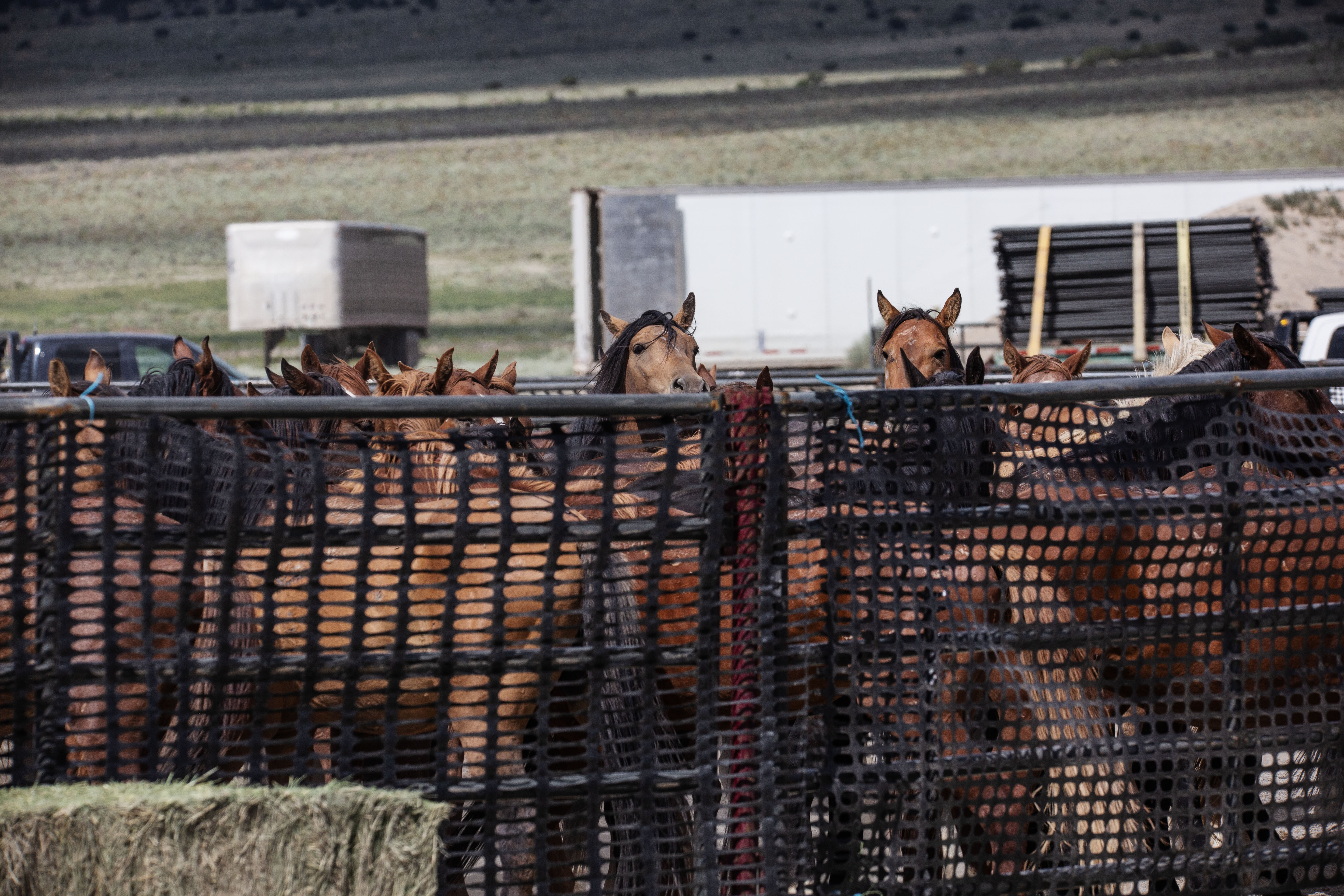Antelope Complex-North
64 Wild Horses Were Rounded Up Today
August 12, 2023: Today we met at 6:30 AM, 49 miles south of Wells, Nevada and then drove another 5 miles to the observation point. This was the same observation and trap site that we were at on Monday, August 7.
We were well over 1/2 mile from the trap. It was cool and cloudy. At 8:25 AM we saw the helicopter up by the mountain but we didn’t have eyes on the horses yet. At 8:35 we saw a group being moved toward the trap. At 8:40 AM they entered the trap. 3 came back out and ran out of the wings.
The pilot attempted to get them back toward the trap for the next 20 minutes, but they kept changing direction on him. The pilot finally gave up and the 3 horses kept running. The helicopter refused and left again. He was gone a little over an hour.
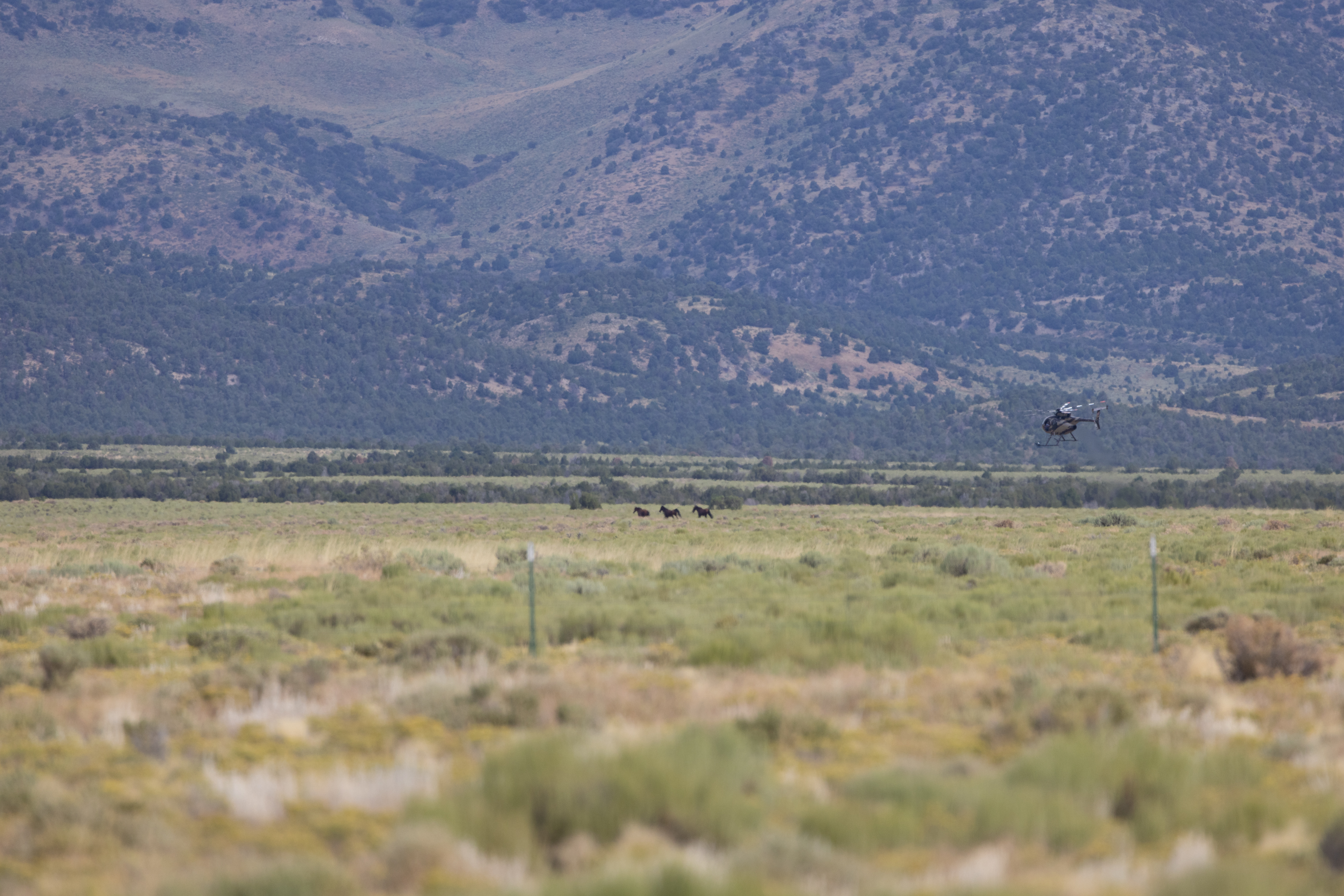



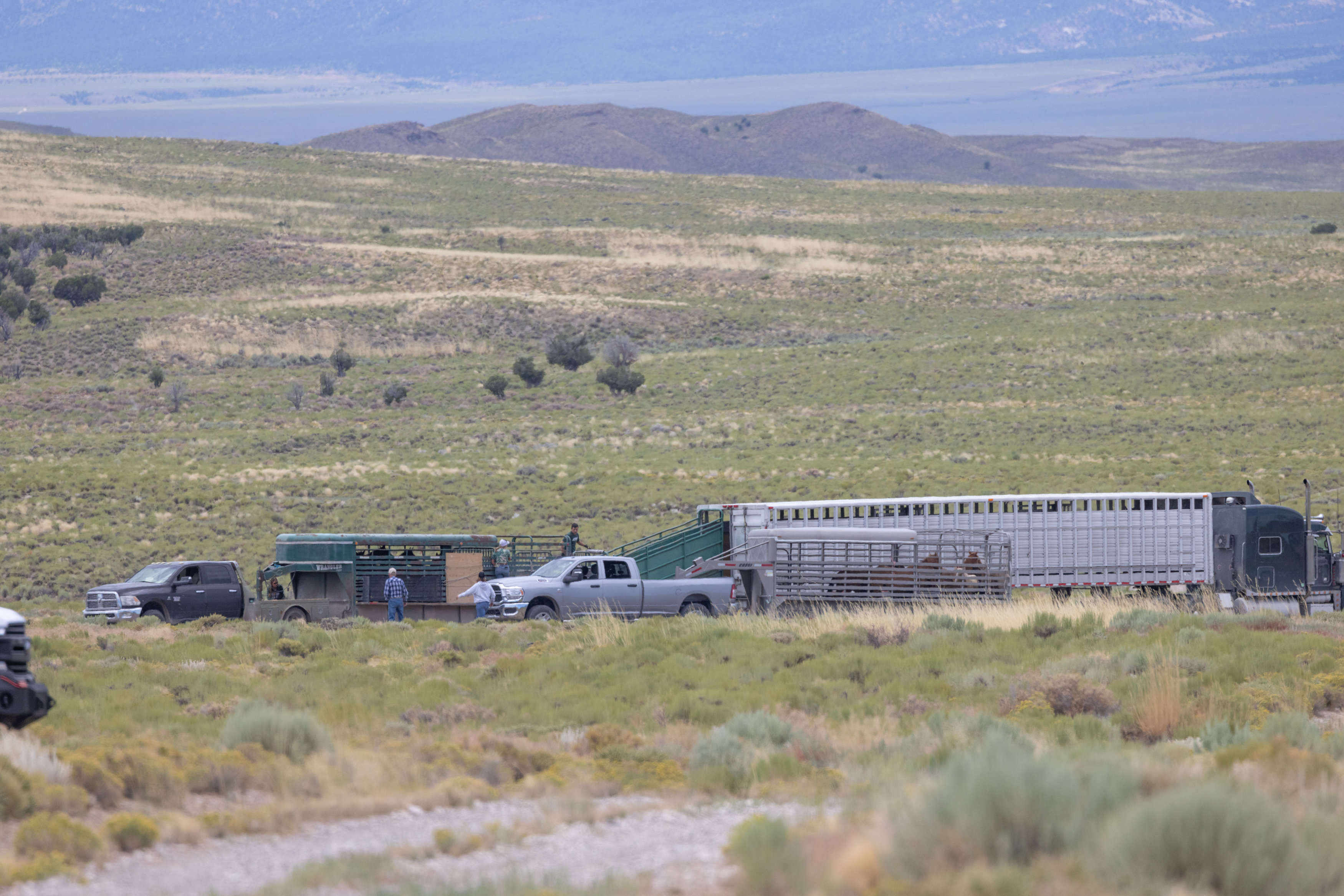

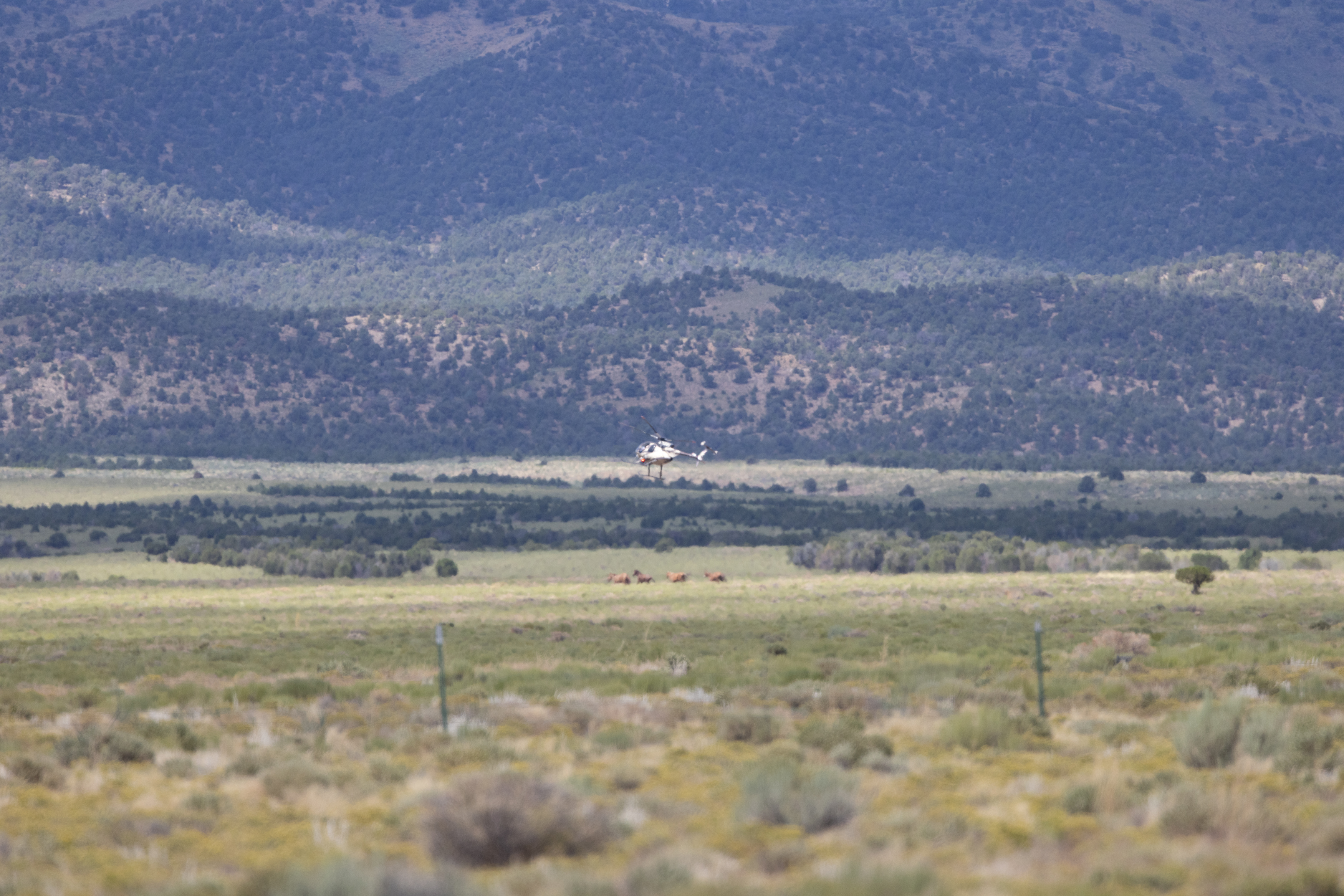

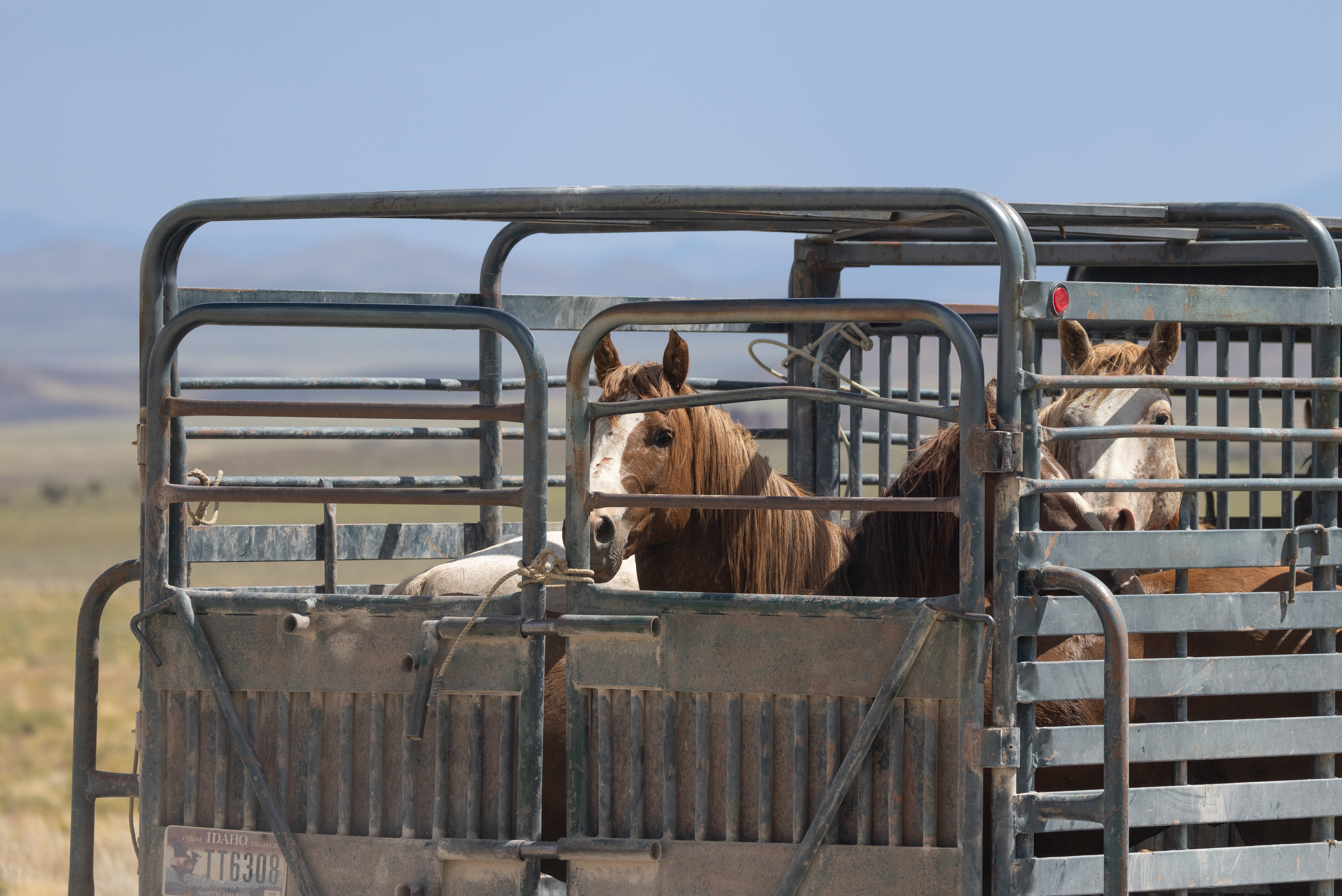
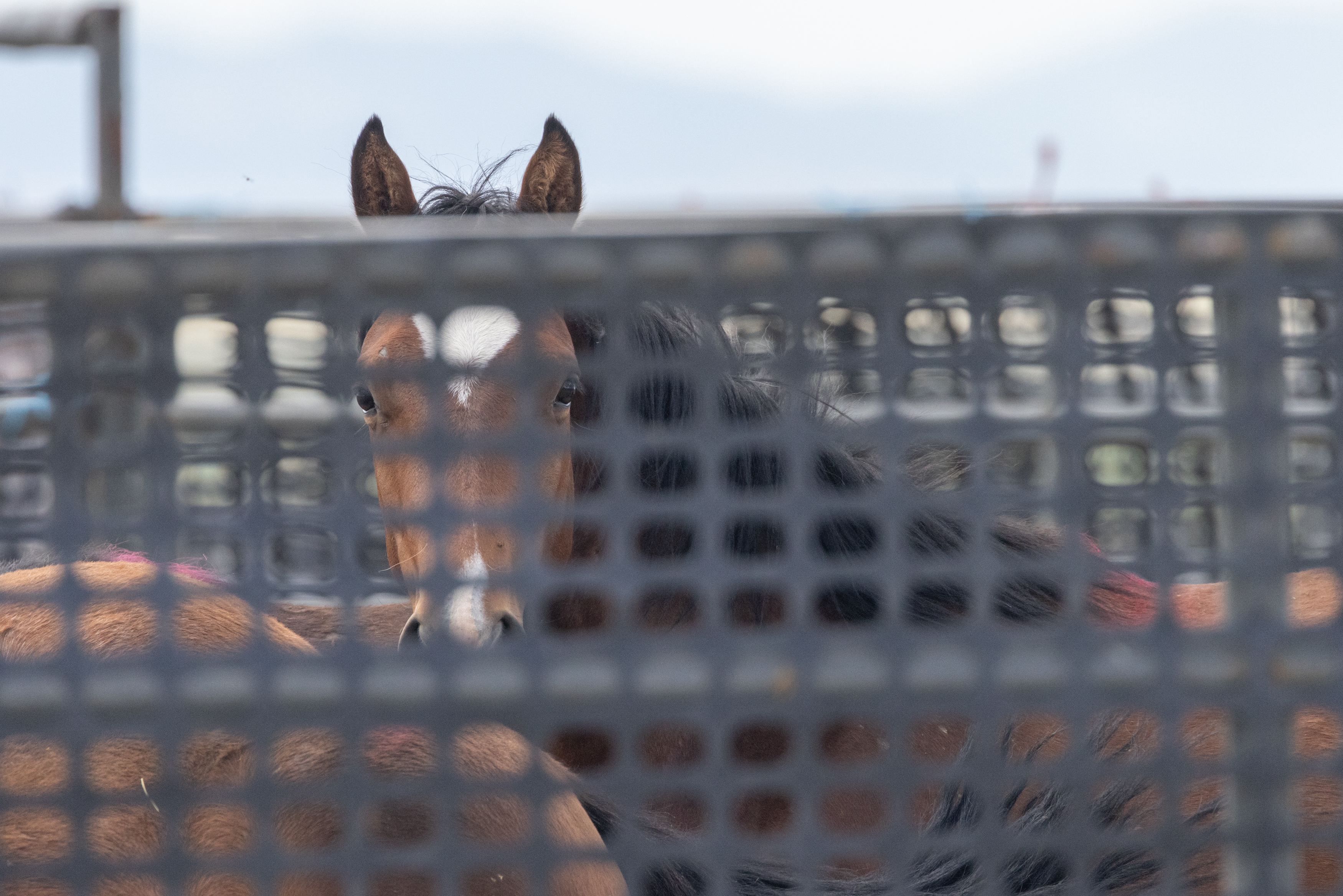
At 10:17 AM we could see the helicopter 2 miles out. 5 minutes later we saw a large group of about 25 coming thru the trees. At 10:42 AM they went into the trap. At 11:07 AM the first trailer of horses came by. They took them down the road from us to transfer them to a large stock trailer. The second trailer came by 10 minutes later. The third is at 11:25 AM.
Once again, just like they did last Monday, they would pull one trailer in front of the one that was unloading to block our view. We heard the helicopter again at 12:14 PM but couldn’t see it yet. 10 minutes later it came into view. He was moving about 15 horses.
They went into the trap at 12:31 PM. Despite the rain overnight, the trap was getting very dusty at this point. The pilot refueled while another trailer holding the foals left for holding. At 1:40 PM we could see the helicopter but no horses yet. 15 minutes later a group of horses came into view over a mile away. At 1:54 PM, about 4 went into the trap.
At 1:58 PM, another 4 entered the trap. At 2:07 PM, the last 4 entered the trap. They called it a day. We then traveled 58 miles to temporary holding to view the horses caught today. We arrived at 3:48 PM and waited about 30 minutes before we could walk around. They watered down the ground to help with dust and put fresh feed out. The horses were calm.
August 11, 2023: The helicopters did not fly today
No wild horses were captured today
August 10, 2023: Today we met at 5:45 AM and went to the same trap and observation point as yesterday, 47 miles East of Wells, Nevada.
We got set up and watched the helicopter leave. He was gone over an hour. At 8:10 AM, they already called it a day because they couldn’t find any horses.
We then drove 58 miles to temp holding. They had already shipped out two trailers this morning, but we were able to view a few horses still in the holding pens from August 9.
They set up the trap at a new location today, but they did not fly.

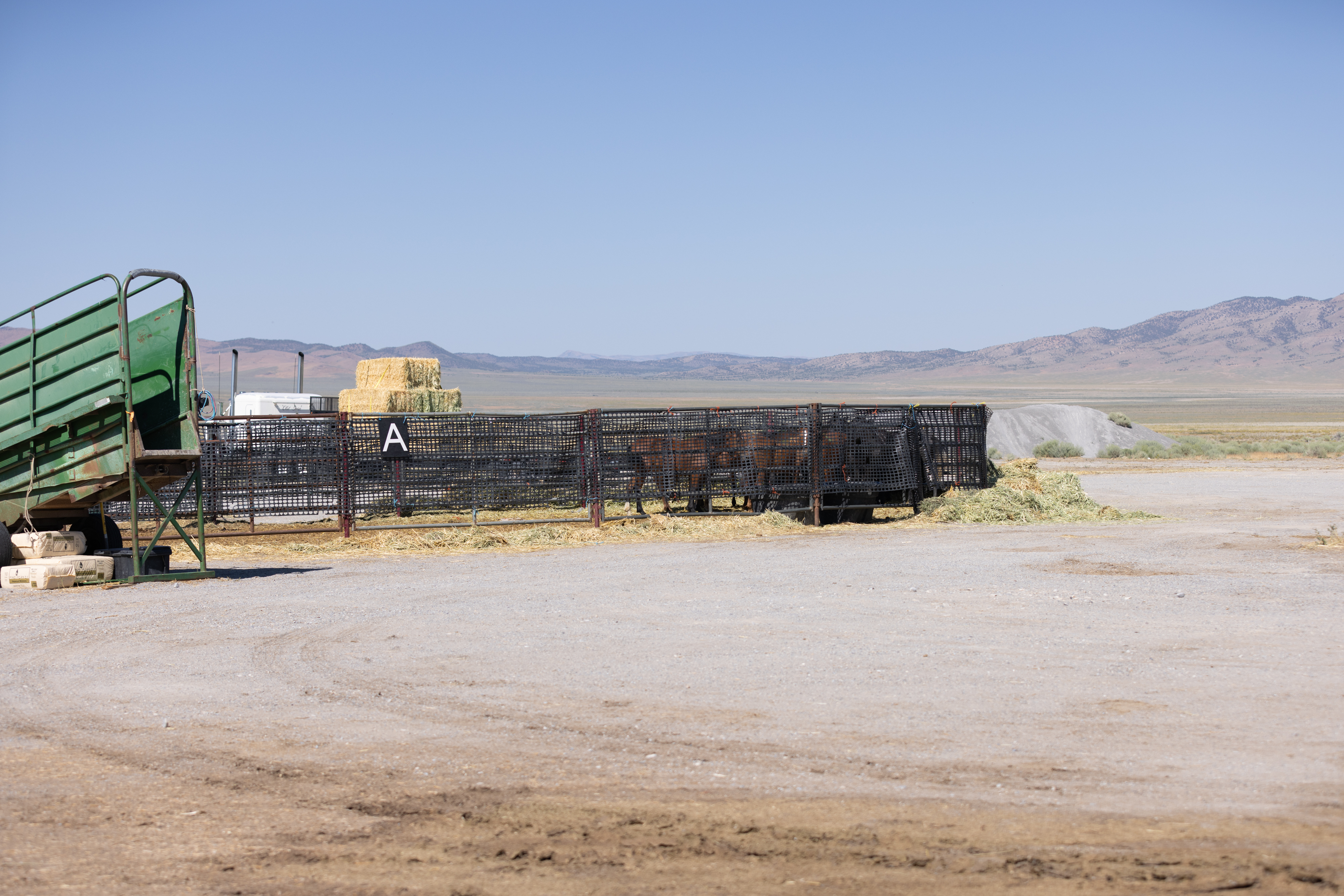
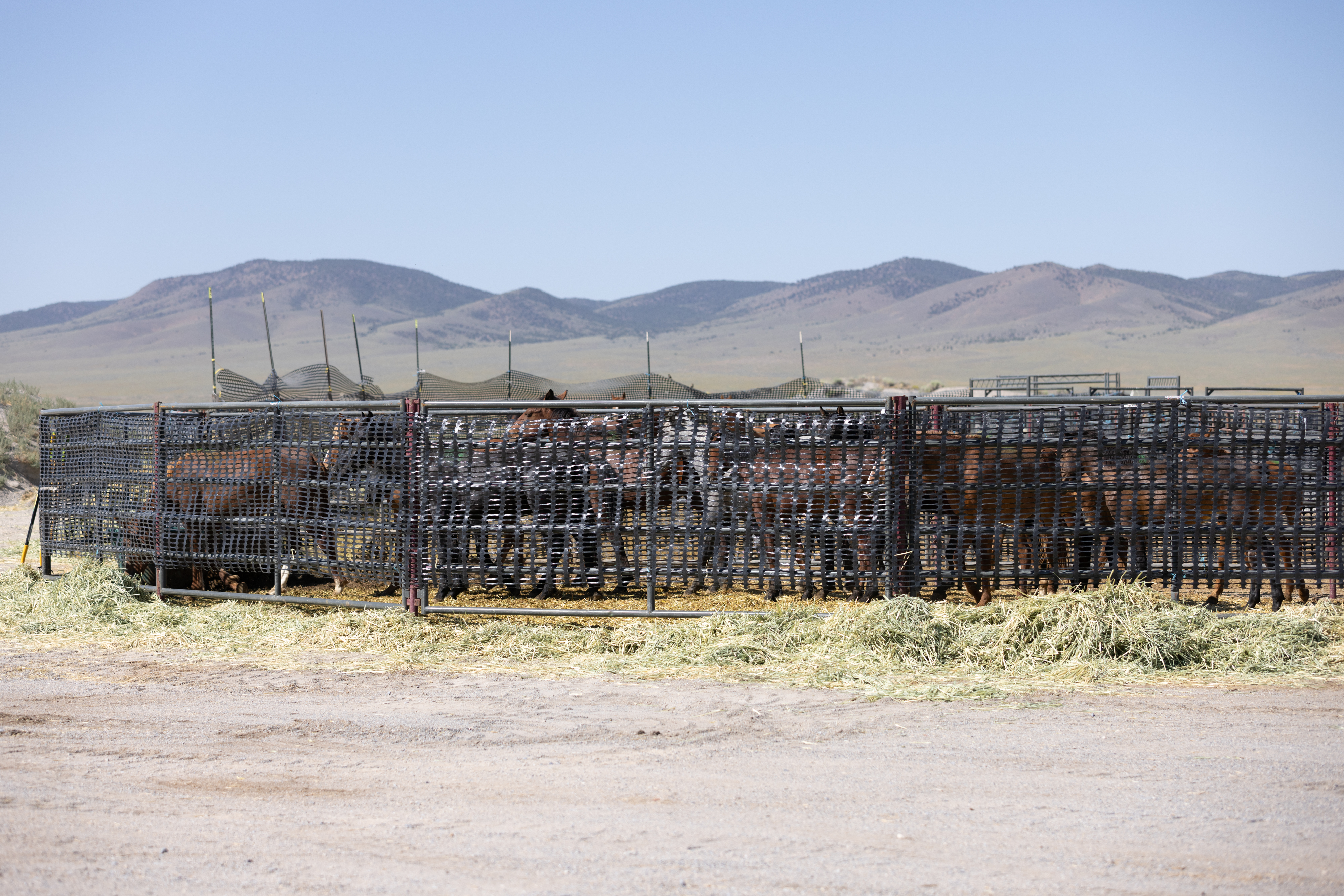
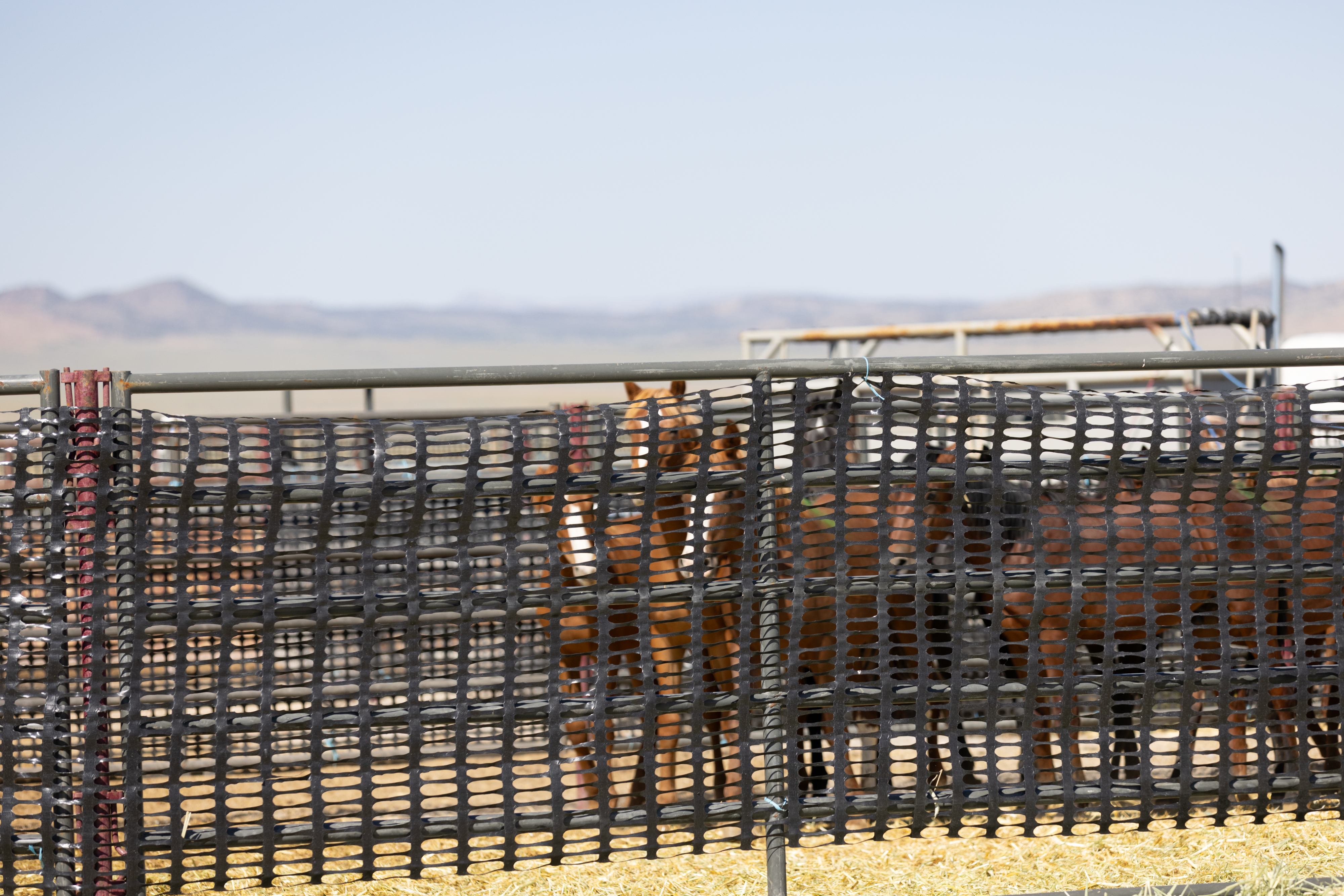
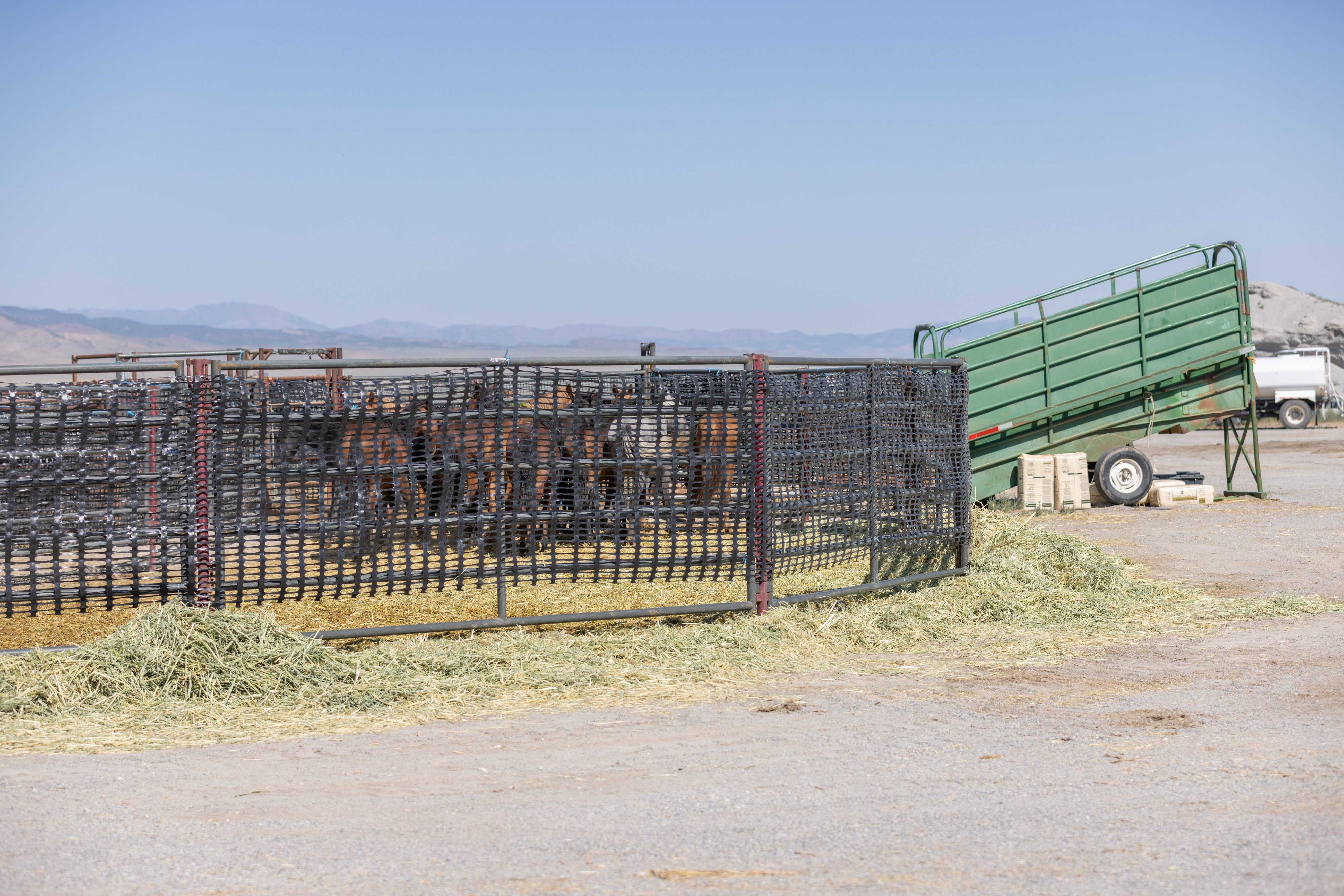
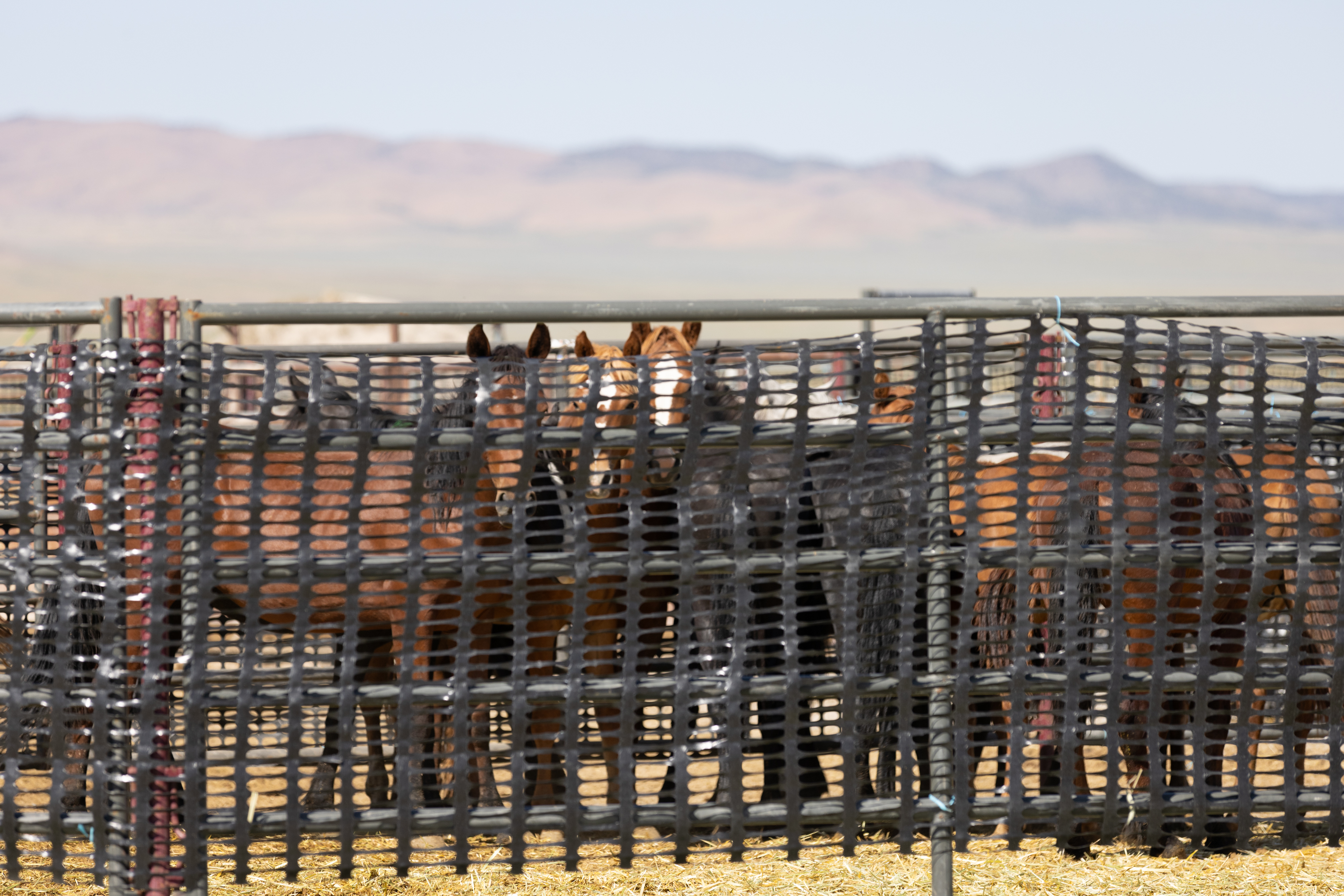
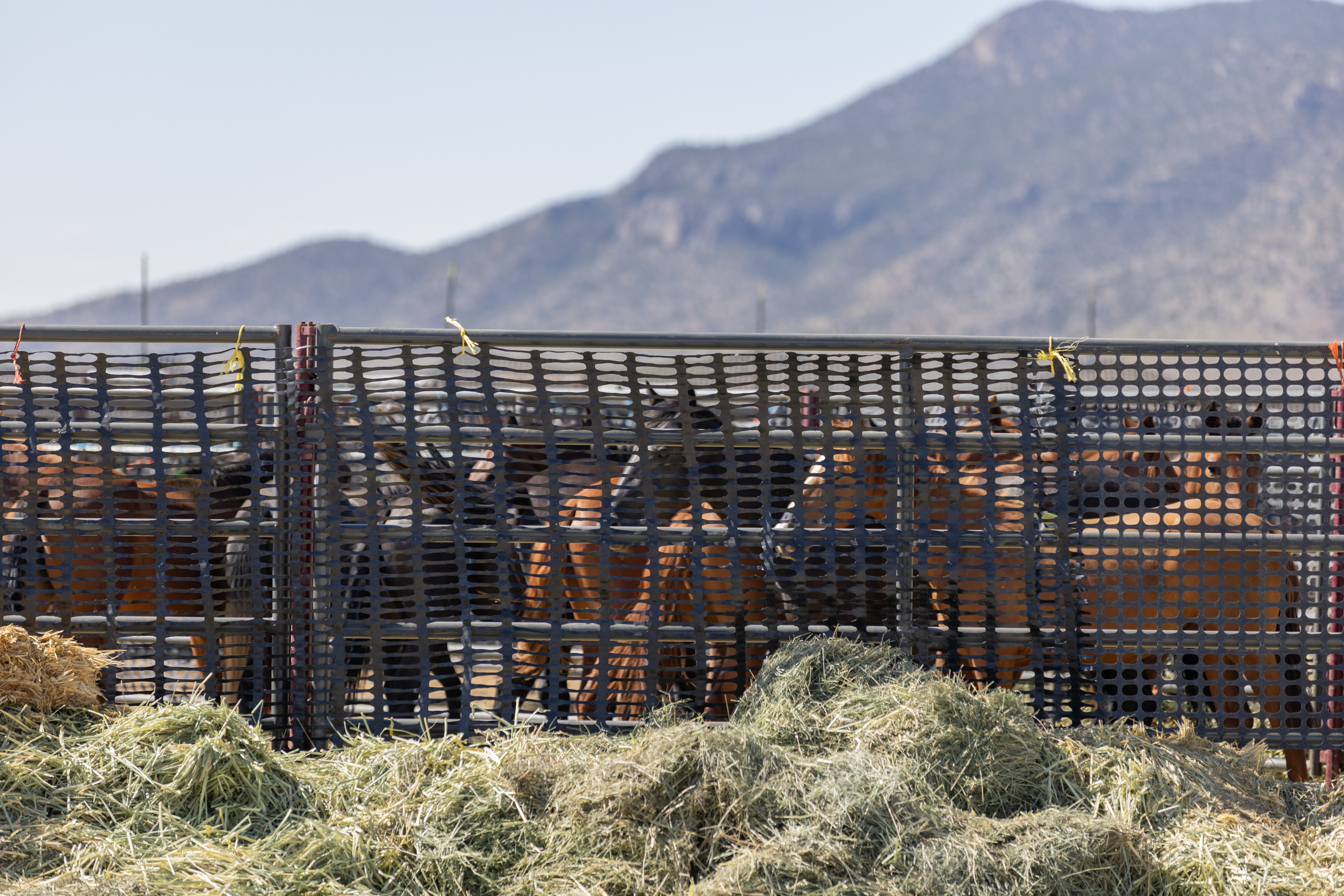
94 wild horses captured in Wednesday operation
August 9, 2023: Today we met at 7:15 AM, 47 miles East of Wells, Nevada. We drove another 7.5 miles to the observation point which was only a couple miles from Interstate 80 as well as a mine. The trap was about 0.9 mile to our Southwest.
Though far away, we could see the wings and trap. At 8:04 AM the pilot was bringing in a small group. At 8:11 AM, they went into the trap.
At 8:28 AM 5 more went into the trap.
At 8:35 AM I could see them bringing 6 horses off the foothills right behind the trap. After turning around once in the wings, they entered the trap at 8:44 AM.
At 9:30 AM a group of 8 were running toward the wings. A grey stallion broke off and headed the opposite direction. The rest went in the trap at 9:36 AM. About 15 minutes later, the grey stallion that broke off came running close to us and stopped briefly as he looked back towards the trap. He then continued to run away.
At 9:52 AM, a small group entered the trap.
At 10:35 AM about 6 entered the trap.
At 12:18 PM, we spotted some horses headed our direction. The PR person radioed to the helicopter who was flying up by the mountain that they were coming toward us. The pilot spotted them and moved them up to the trap. About 10 entered at 12:35 PM. A group of 6 came in to the wings at 12:44 PM, except for one bay stallion which diverted the other direction. Once again after running far away, he stopped and watched the helicopter circling behind the trap before he continued on his way. 6 more horses entered at 12:56 PM.
At 1:15 PM we spotted a group of at least 15 running off the foothills. They entered at 1:23 PM. 30 minutes later, 6 more entered the wings, but one stallion ran back out and got away. They called it a day at 2PM.
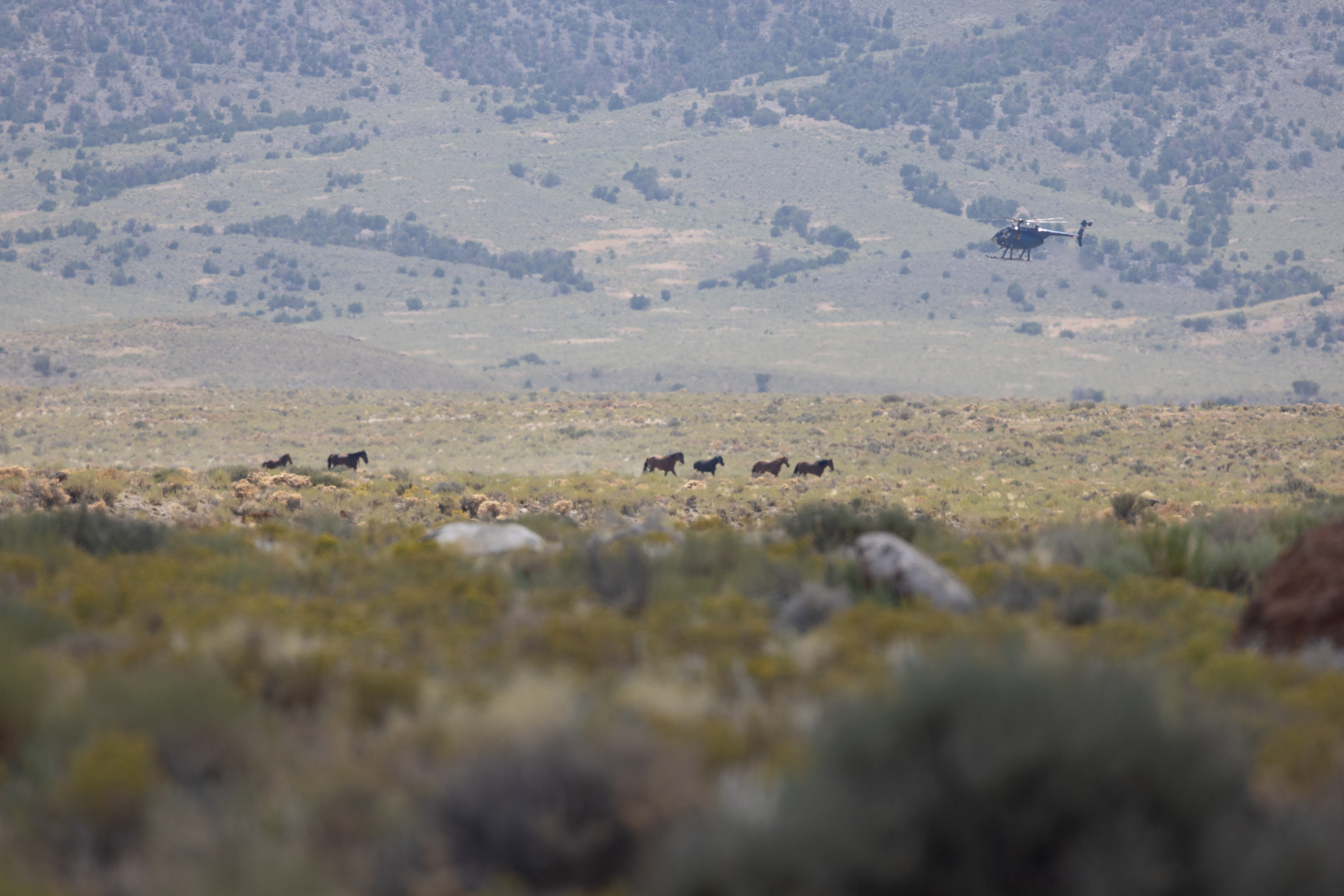

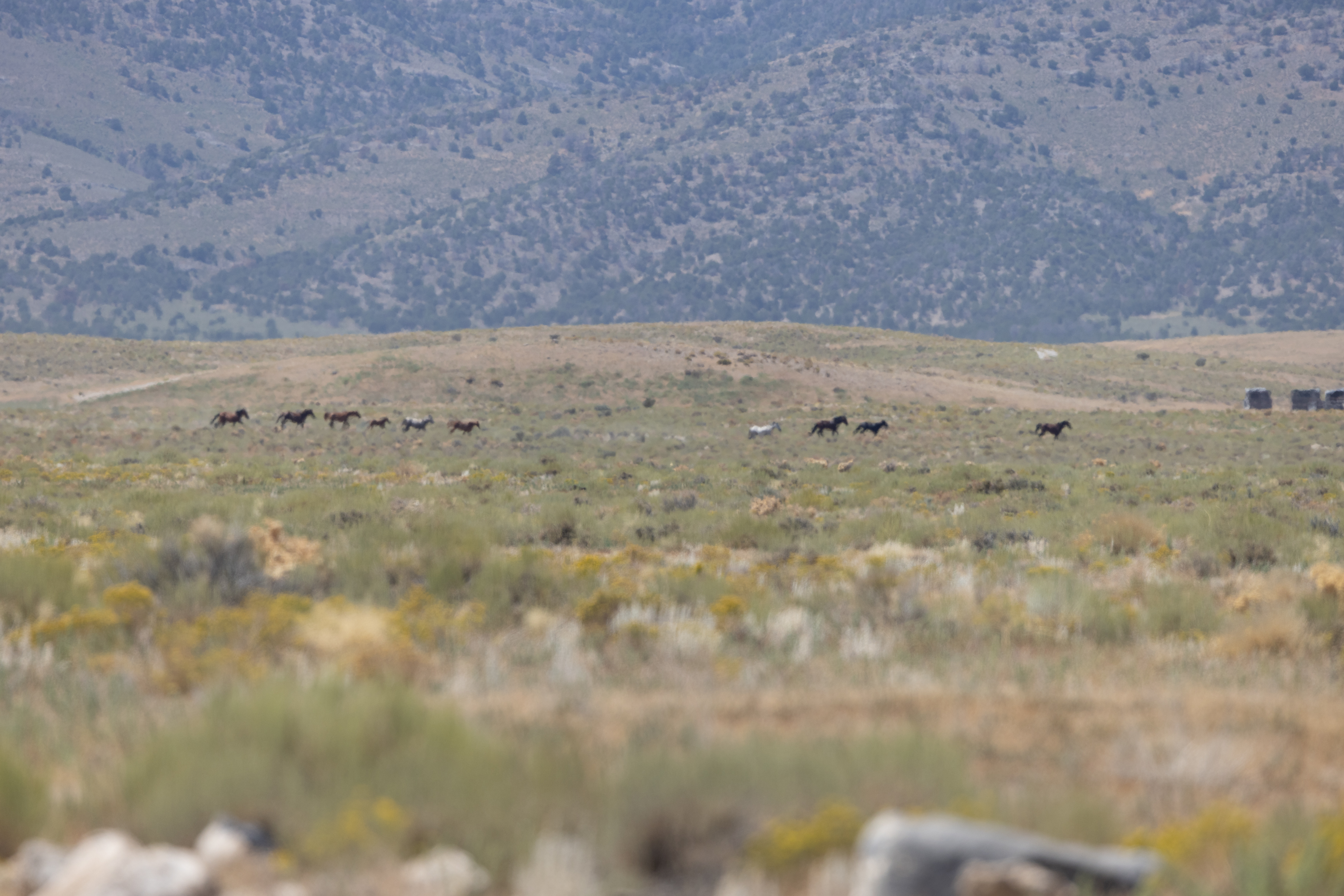
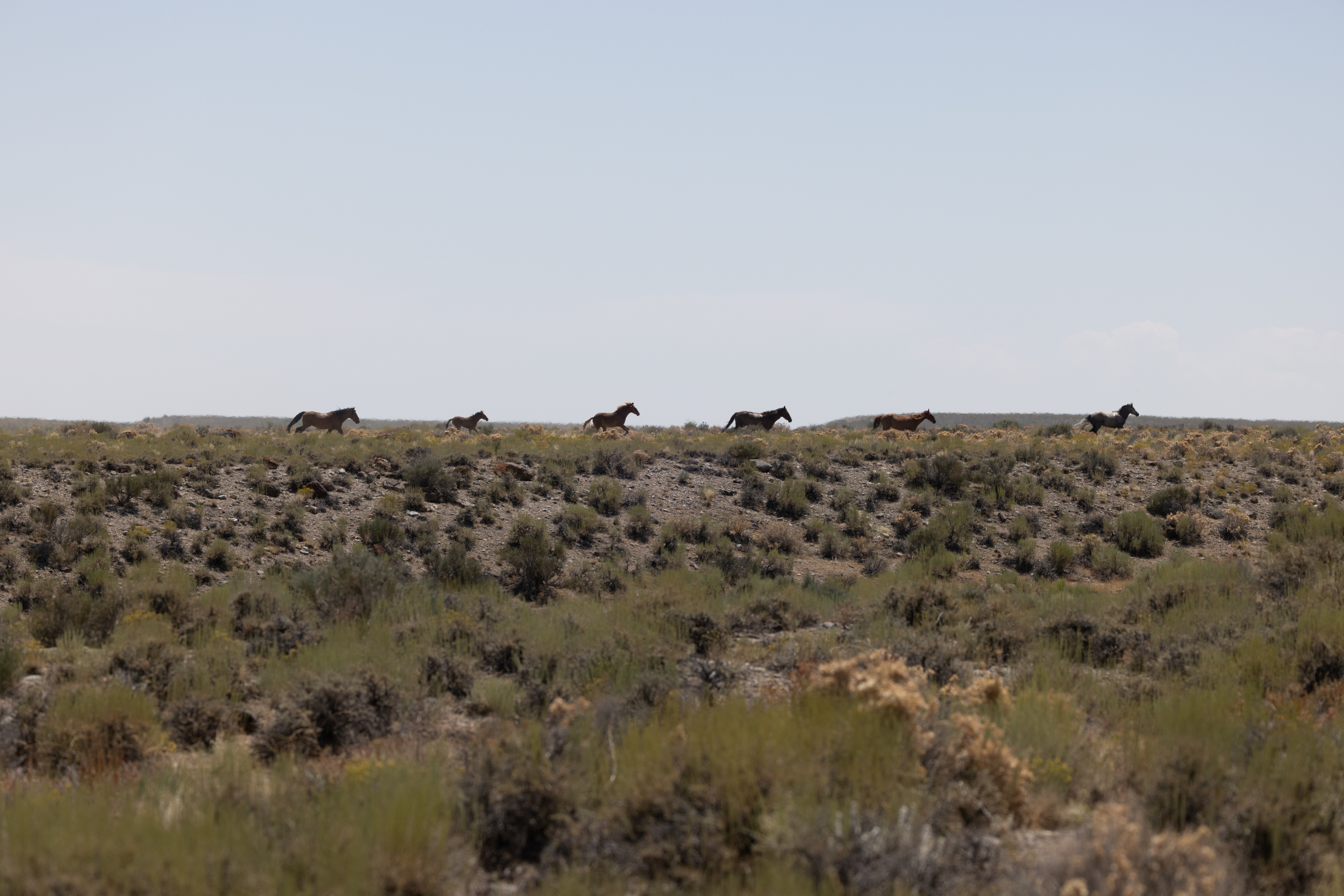
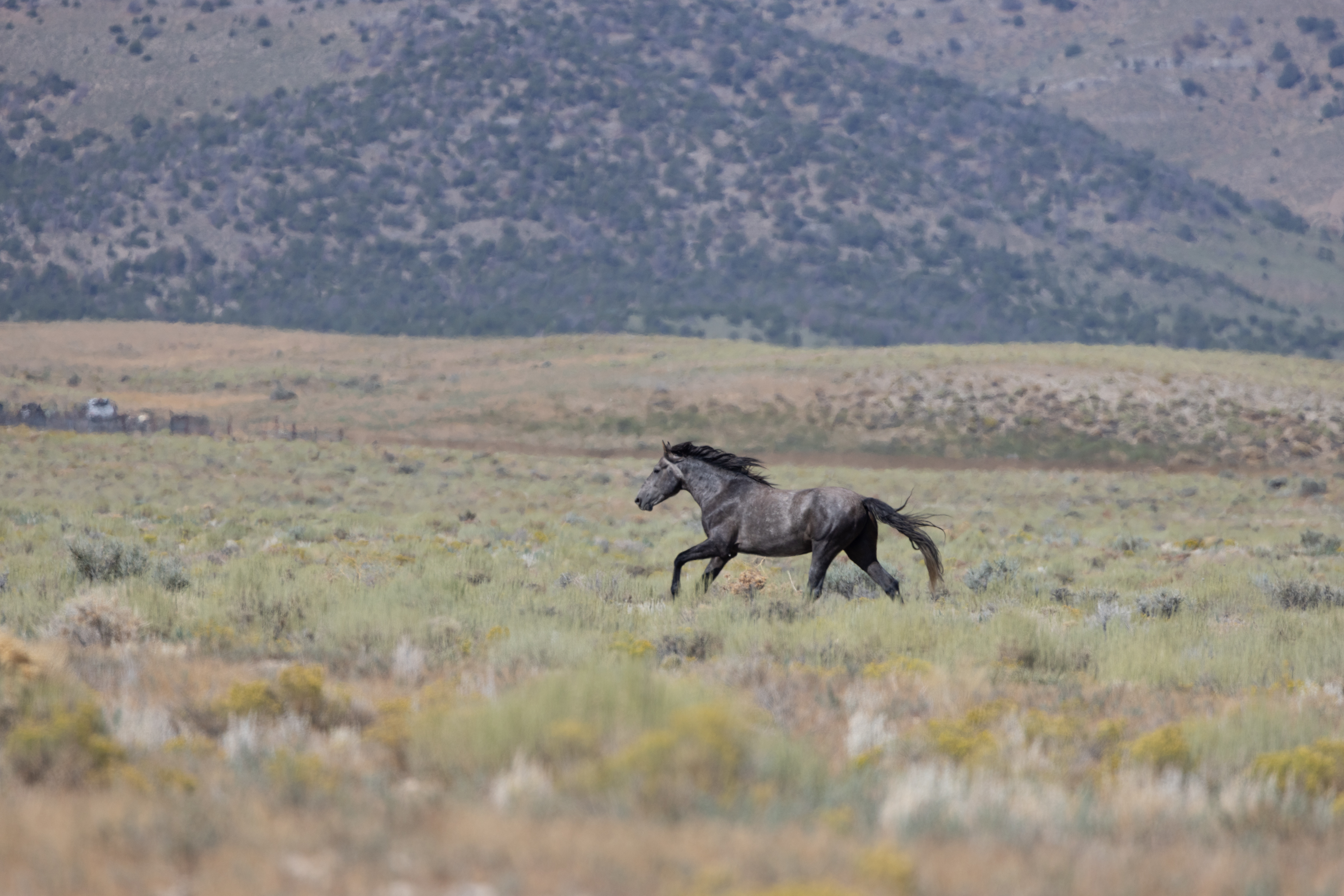


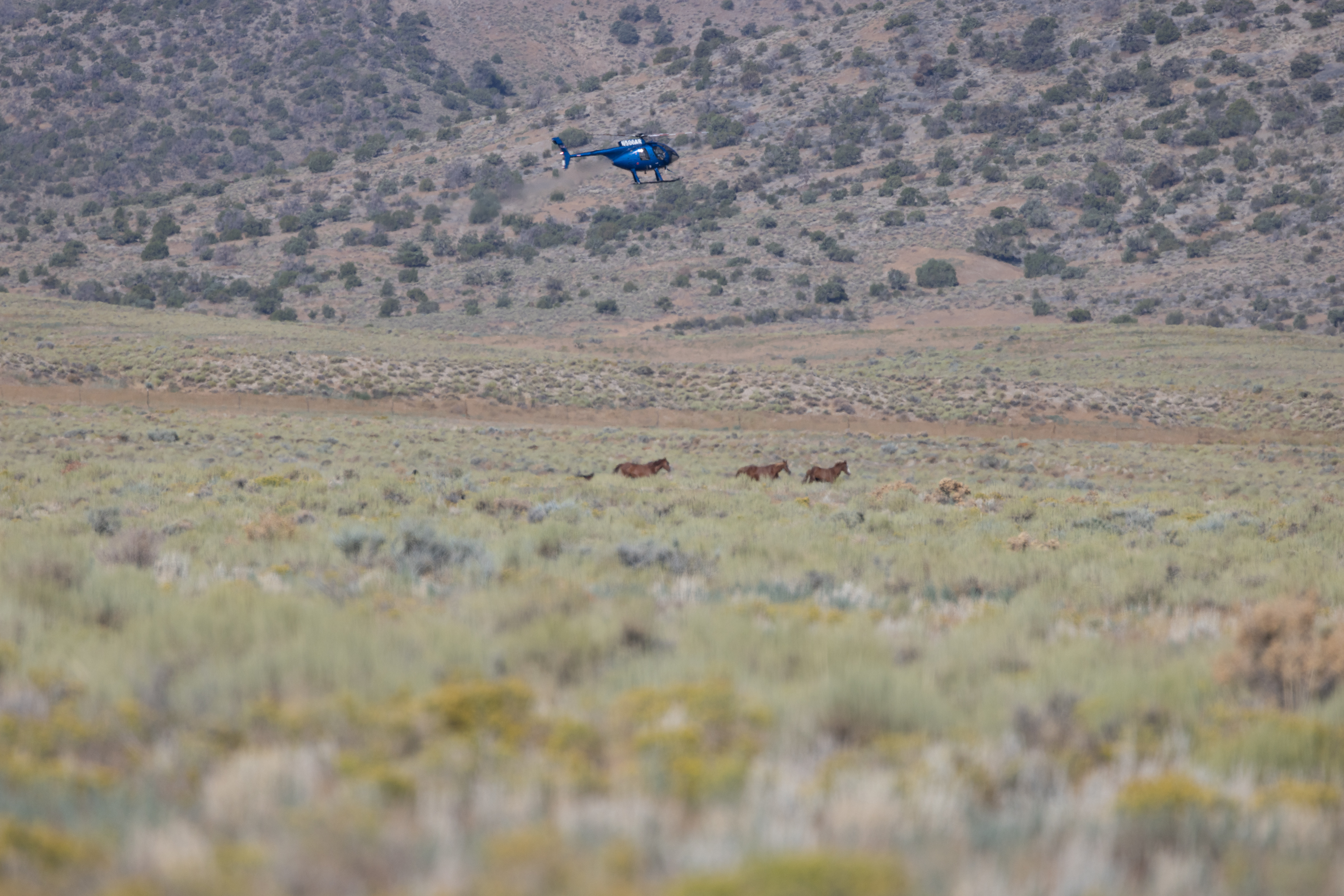
August 8, 2023: There was no roundup operation today.
August 7, 2023: Today, we met at 7:30 AM, 45 miles south of Wells, Nevada. From there, we drove another 9 miles to our observation point. Our observation point was located just off a dirt road, a little over 1/2 mile away from the trap. The weather was sunny and windy, which made it challenging to document due to heat distortion and wind.
At 8:45 AM, we first spotted a helicopter bringing in about a dozen horses. As they approached the wings, two of the horses broke off and ran west. The remaining horses went into the trap at 8:56 AM. For a while, we couldn't see any horses due to the terrain, but at 9:20 AM, we spotted about a dozen horses, and they entered the trap at 9:27 AM.
At 9:35 AM, the first trailer of horses came along the road near us. They took the horses to a parking lot just south of us to load them onto a large stock trailer. The second trailer of horses arrived and parked in front of the other two trailers, blocking our view of the first group of horses loading onto the stock trailer. Once the first trailer was empty, it was moved to block our view of the second trailer unloading.

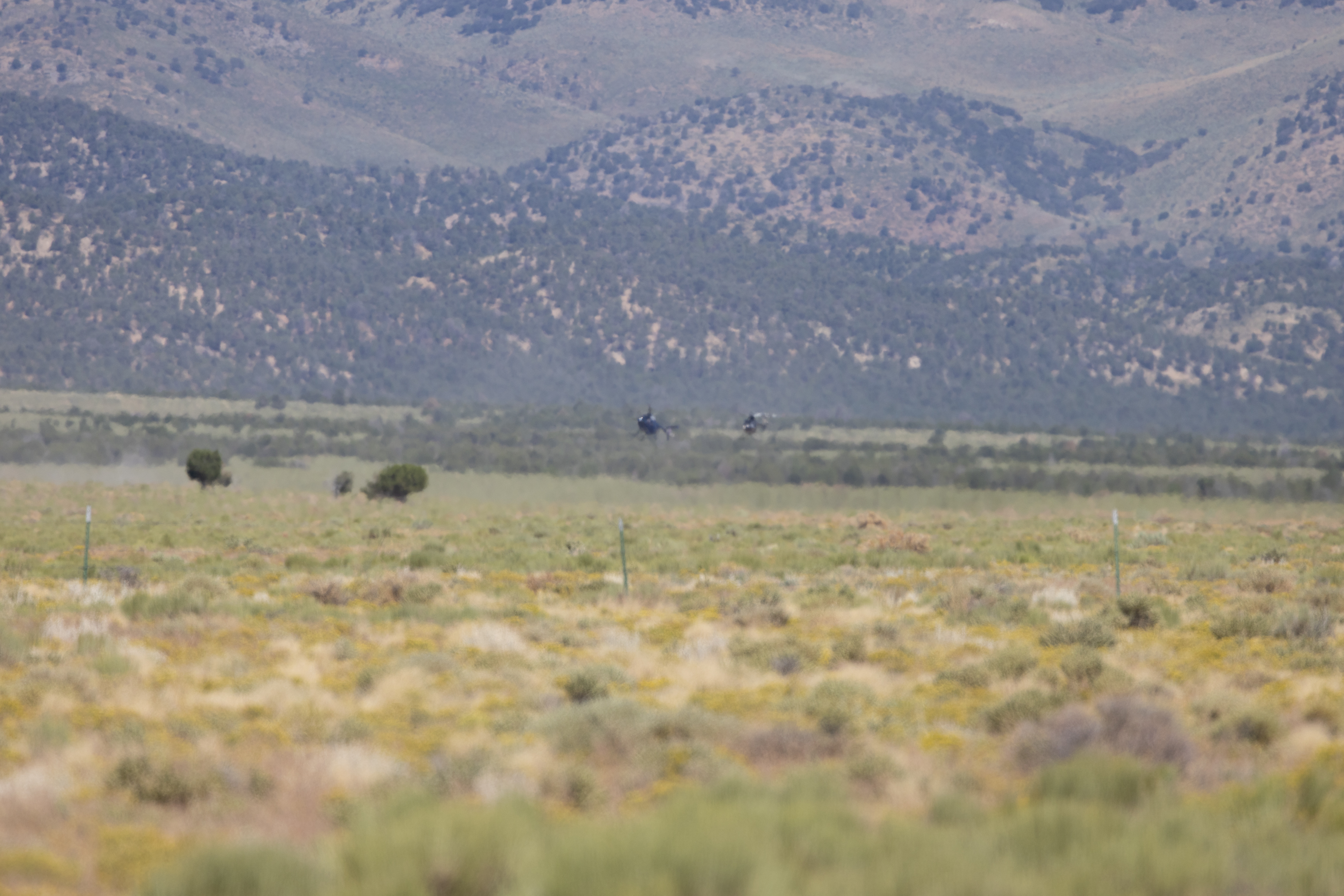
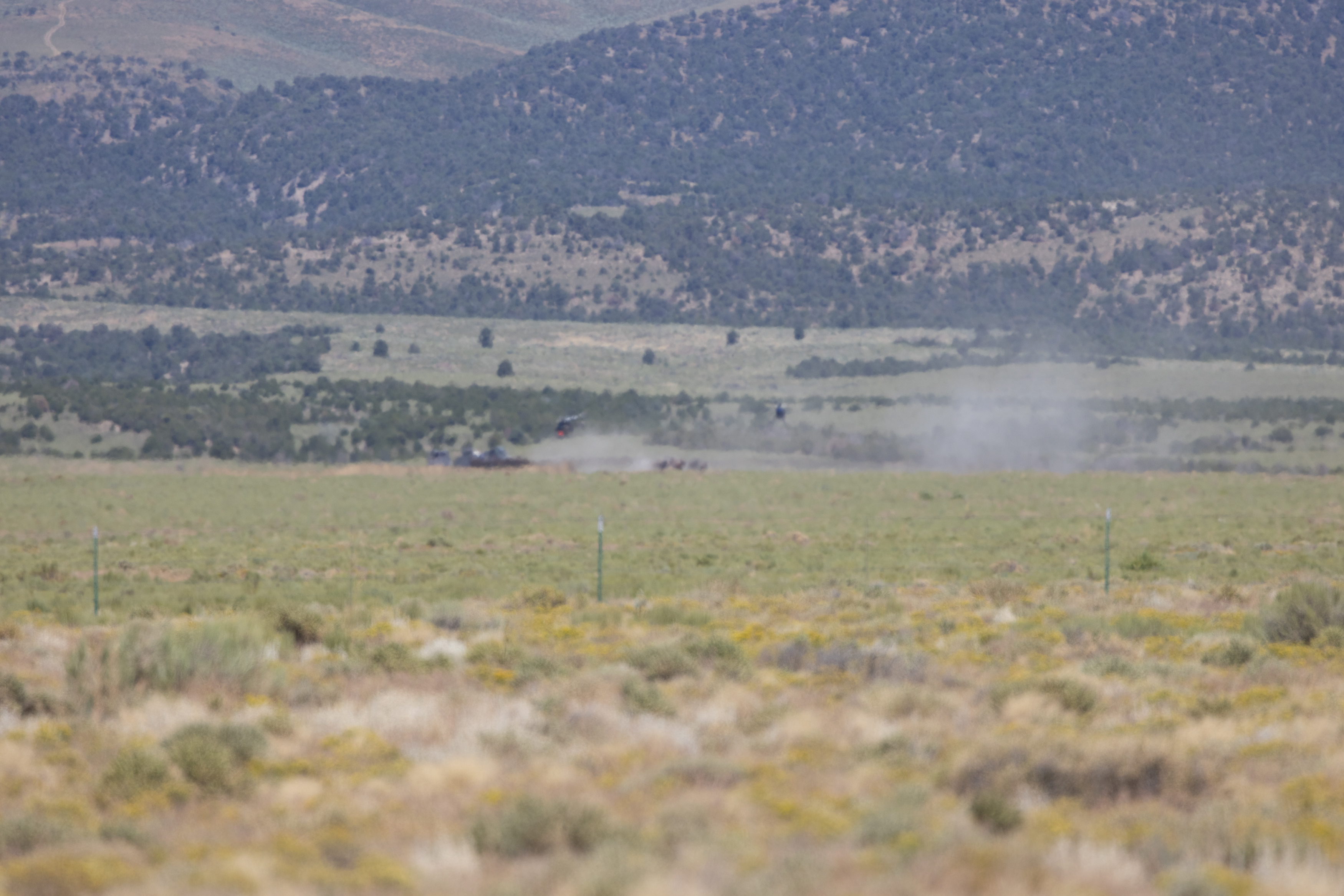


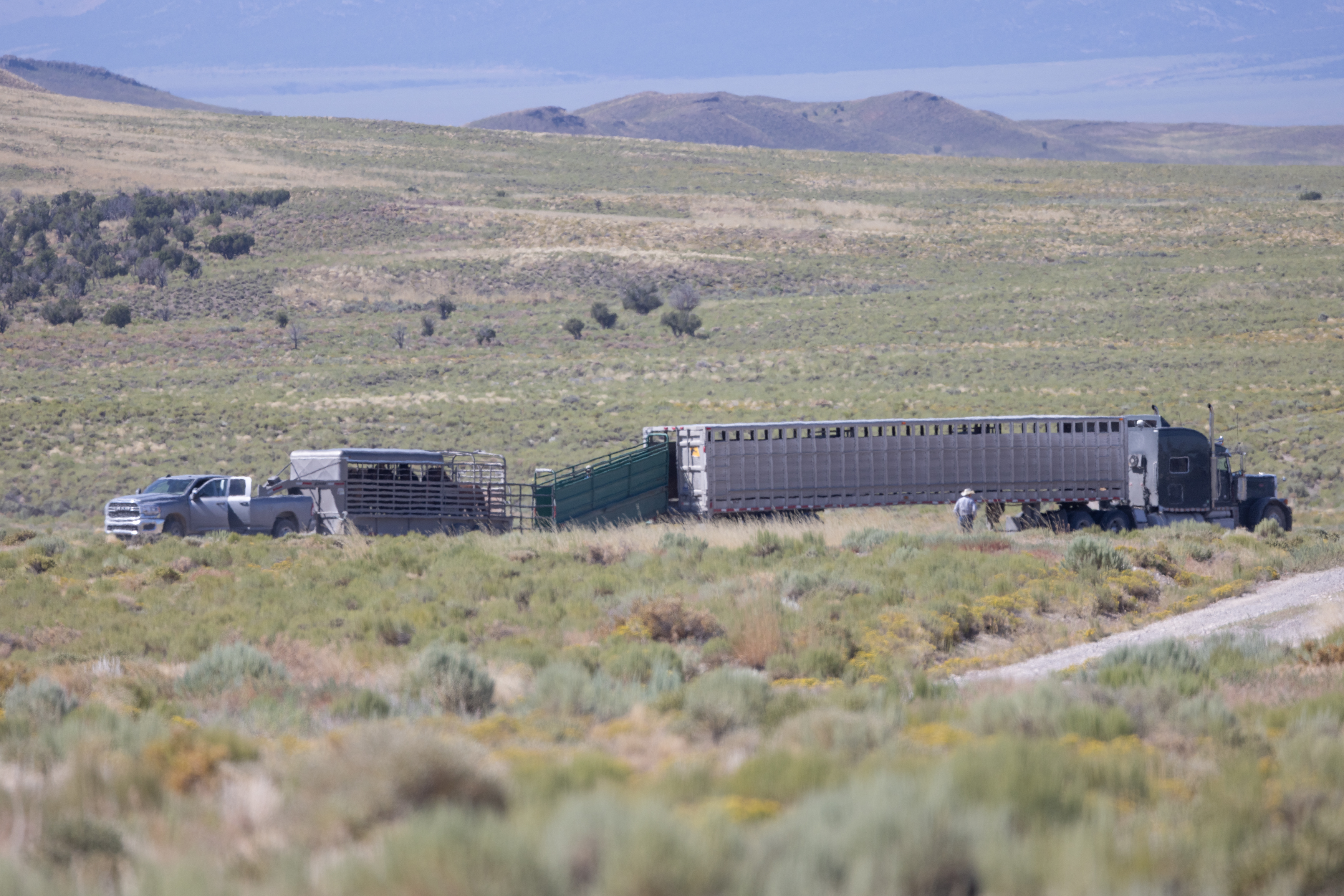

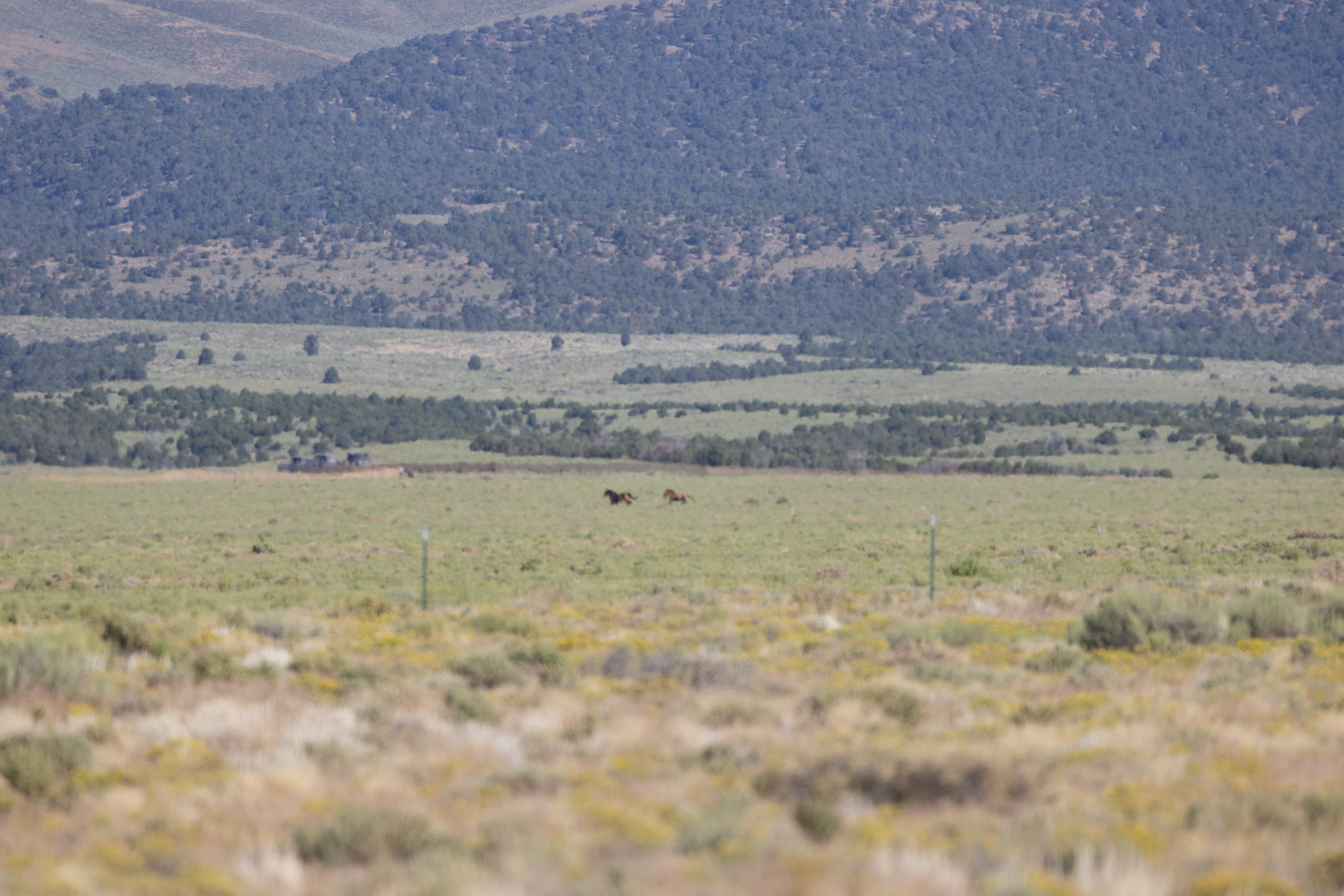

We could still hear the helicopter but couldn't see it. The horses were being brought in from areas with lots of trees and hilly terrain. Occasionally, we heard banging noises from the horses kicking inside the stock trailer down the road. We didn't see the helicopter again until 10:36 AM when it was 1.5 miles away. There was also a second helicopter flying on this run, and it seemed like there were around 15 horses.
At 11:06 AM, the horses were in the wings, but it was difficult to determine if any went into the trap. Most of the horses split into two groups, causing some challenges even with two helicopters. Finally, at 11:19 AM, they entered the trap, although it was hard to determine if all of them did.
At 11:48 AM, two trailers of horses came by, and one of them was loaded onto the stock trailer with the horses that had been there since before 10 AM. After the third trailer loaded onto the stock trailer, it left at 12:08 PM along with the fourth smaller trailer carrying the foals. Due to strong winds, they called it a day shortly after noon.
30 Horses Were Captured on Sunday
August 6, 2023: Today, we did not meet BLM until 2 PM due to the contractors flying in restricted airspace.We met approximately 97 miles Southeast of Wells, Nevada and then traveled an additional 15 miles to the observation location just South of West Wendover, Nevada.
The horses were typically seen crossing during the late day, which is why we scheduled our meeting for 2 PM. We parked and hiked up a hill, positioning ourselves about 1/4 mile from the trap. To remain inconspicuous, we were advised to sit low to the ground and stay still, as we were in direct line of sight as the horses approached the wings. Although we could see the wings, the trap itself was obscured by a small rocky hill.
At 2:54 PM, we heard the helicopter and witnessed approximately 10 horses being guided along the side of the hill. However, as they approached the wings, they turned back. It took several attempts to redirect them towards the trap. Eventually, with the help of a Judas horse, they followed its lead and entered the trap at 3:15 PM. At 4 PM, we could hear the helicopter but couldn't see it. By 4:27 PM, the helicopter reappeared, bringing six horses through the ravine towards the trap. They entered the trap at 4:33 PM. Two hours passed, and at 6:20 PM, we heard the helicopter again and witnessed the Judas horses being brought out. At 6:35 PM, we saw 14 horses running in.
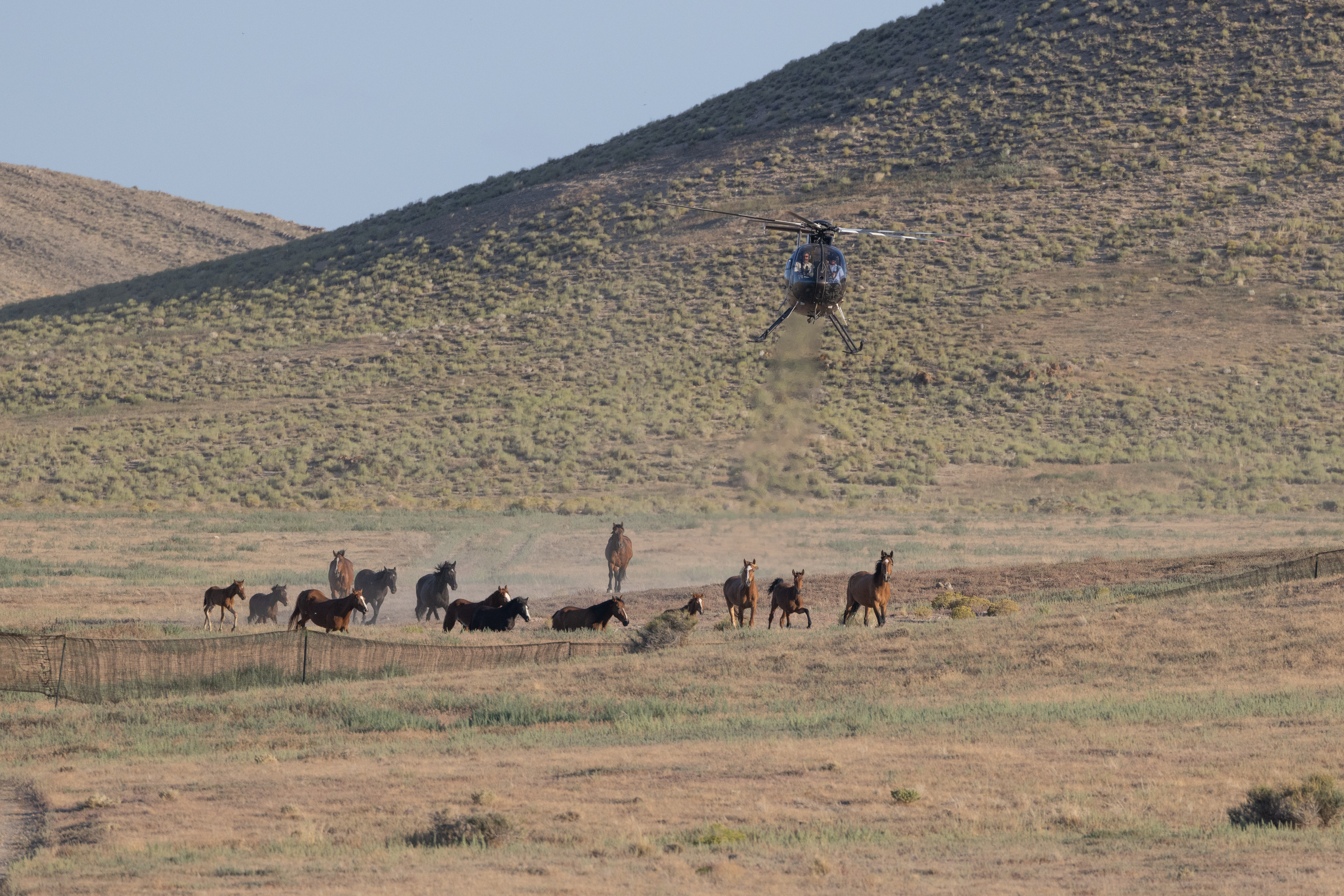
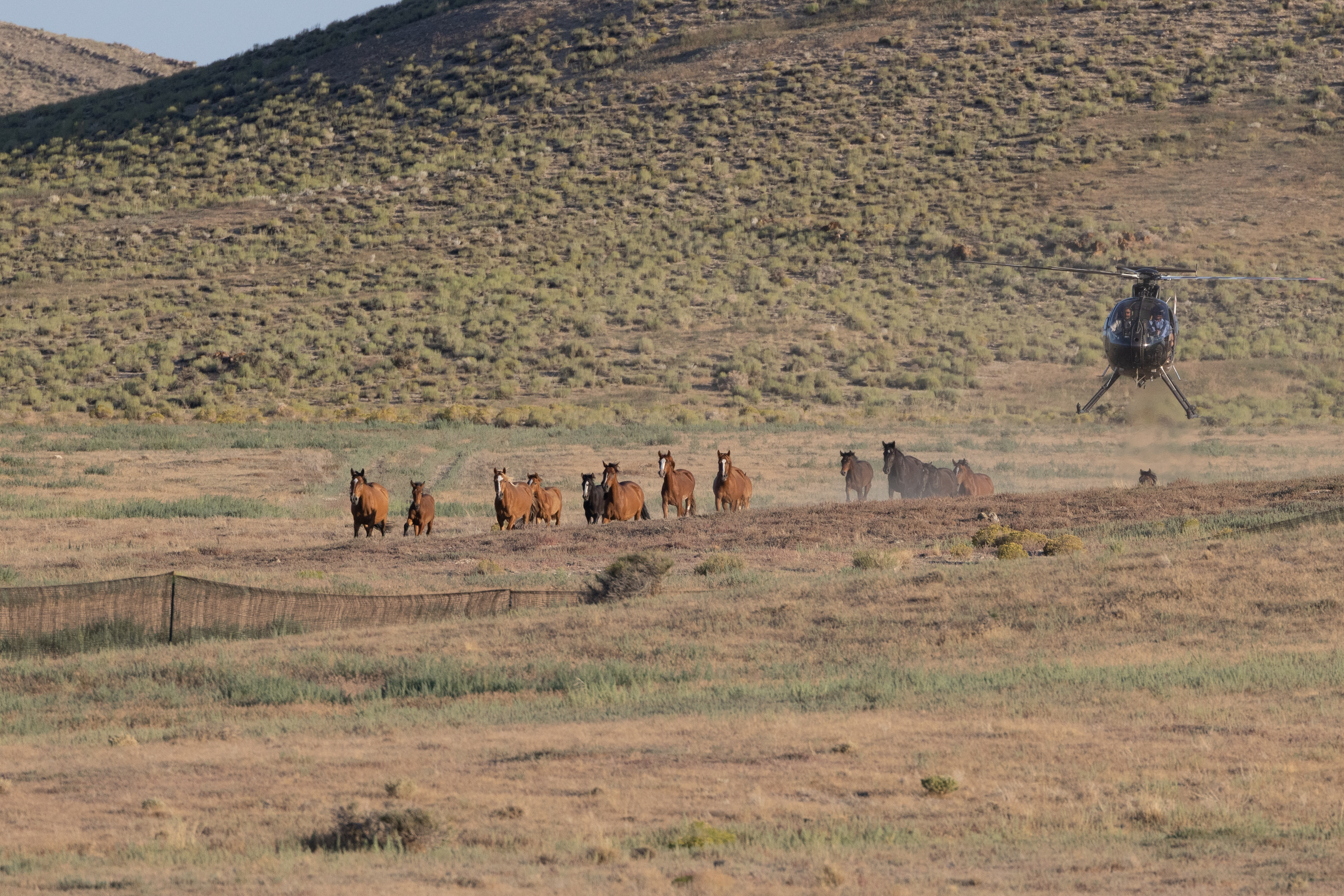
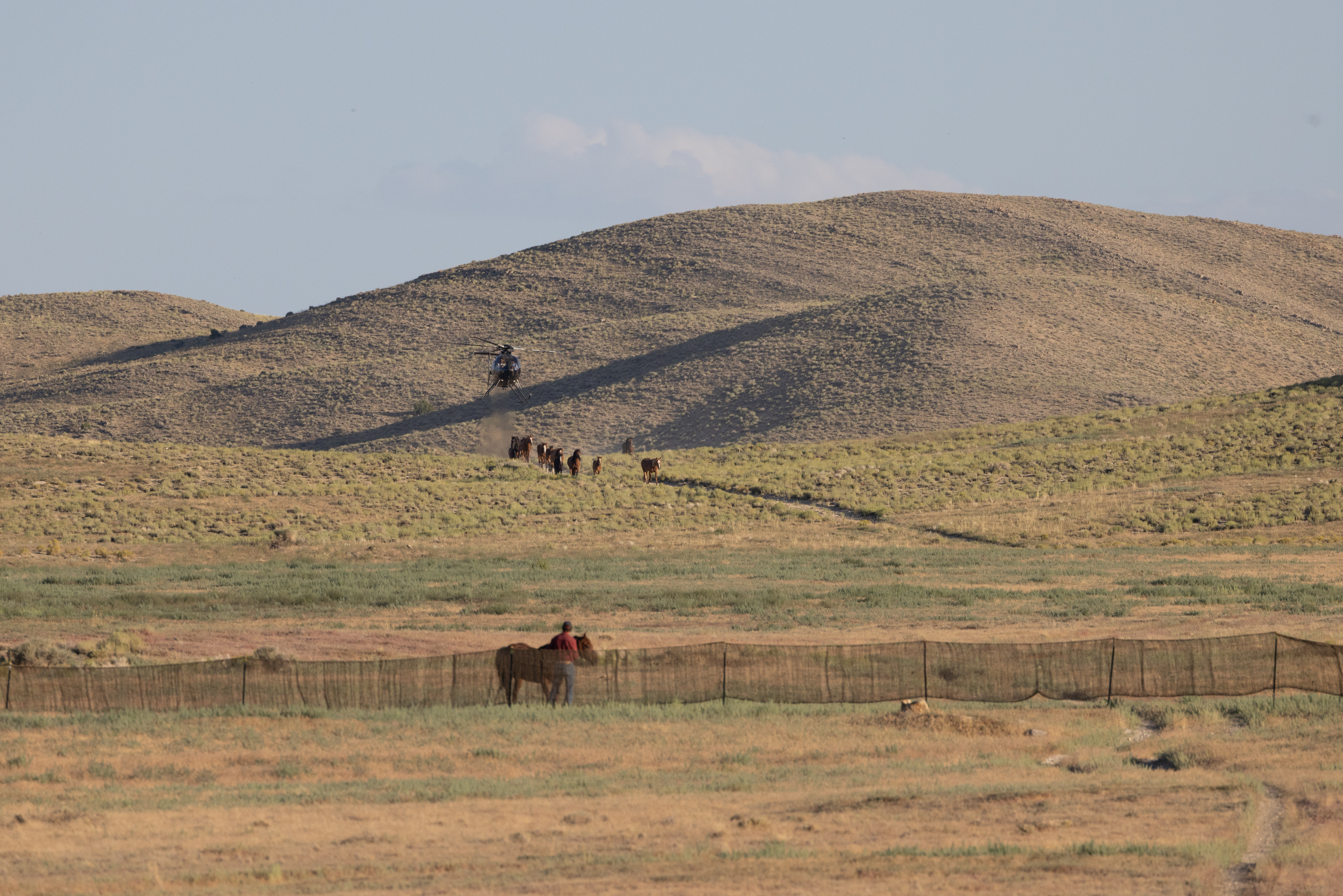

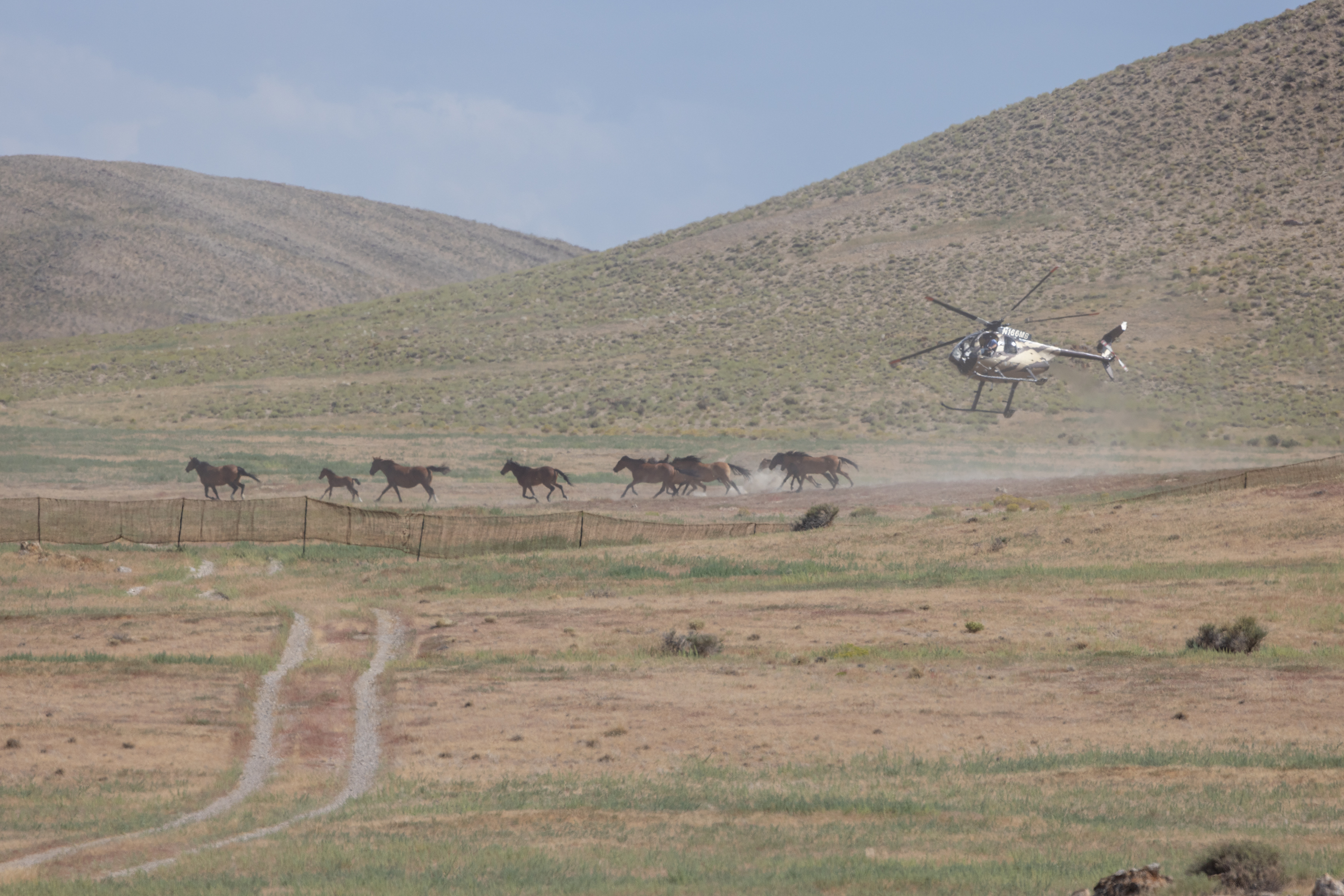
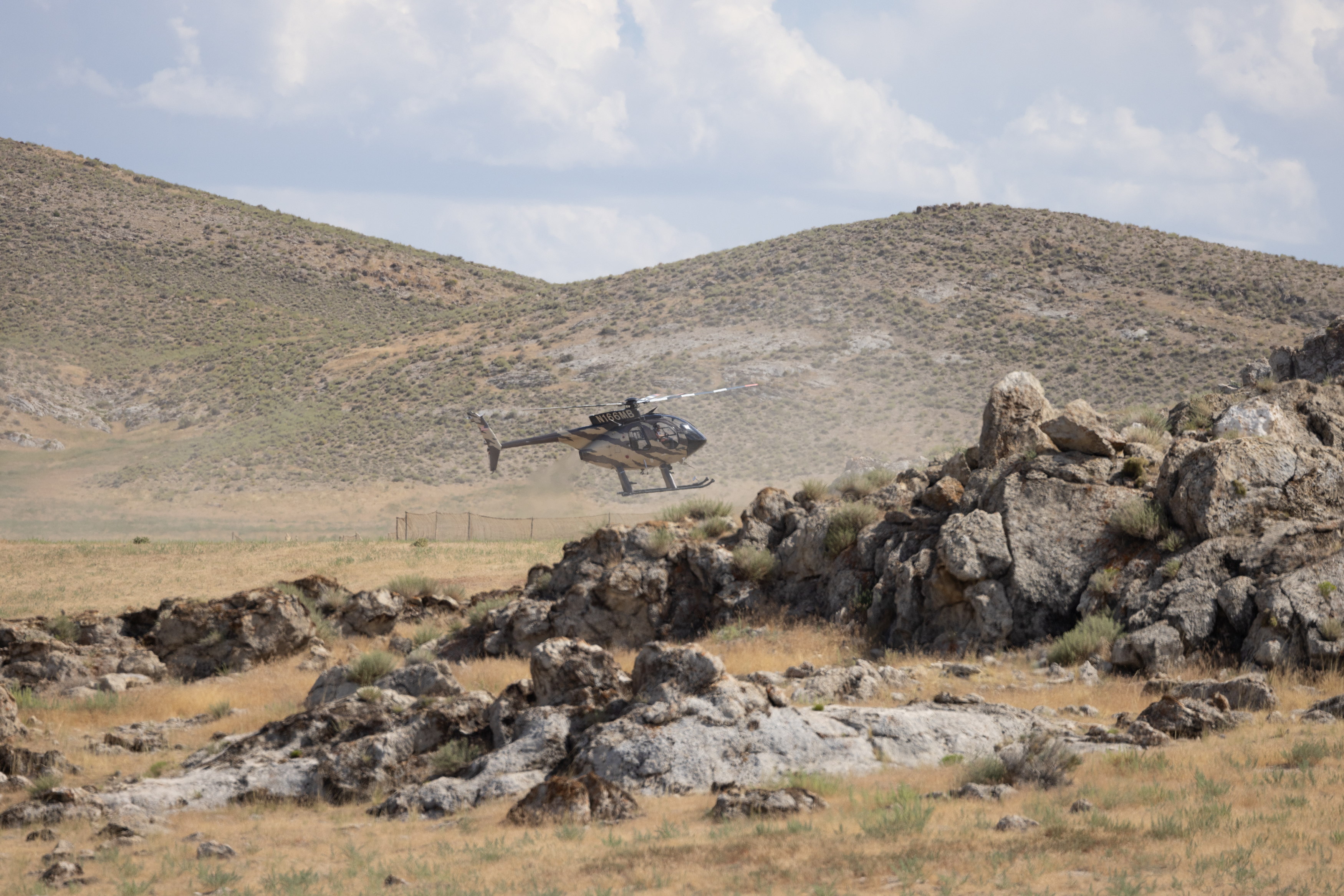
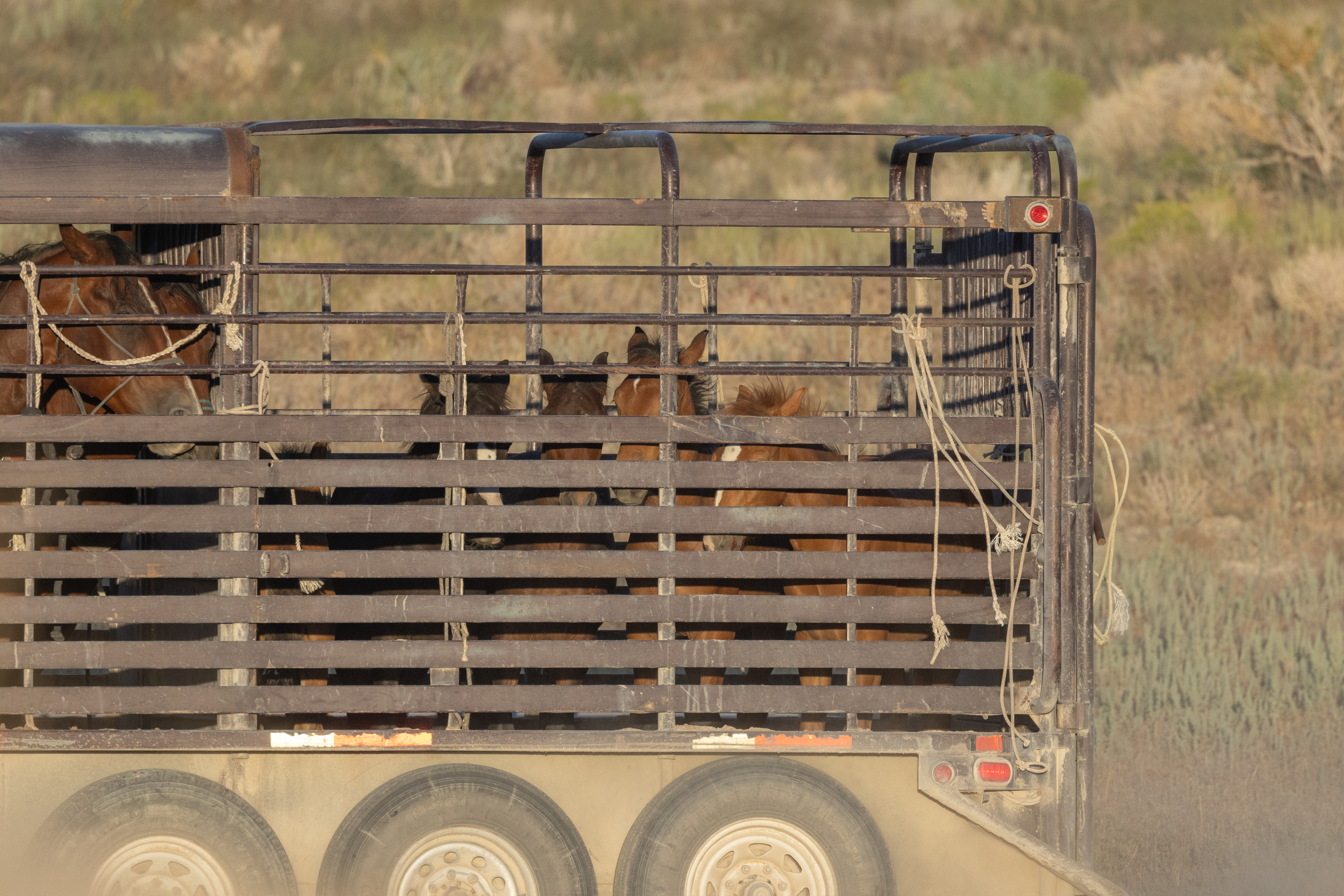
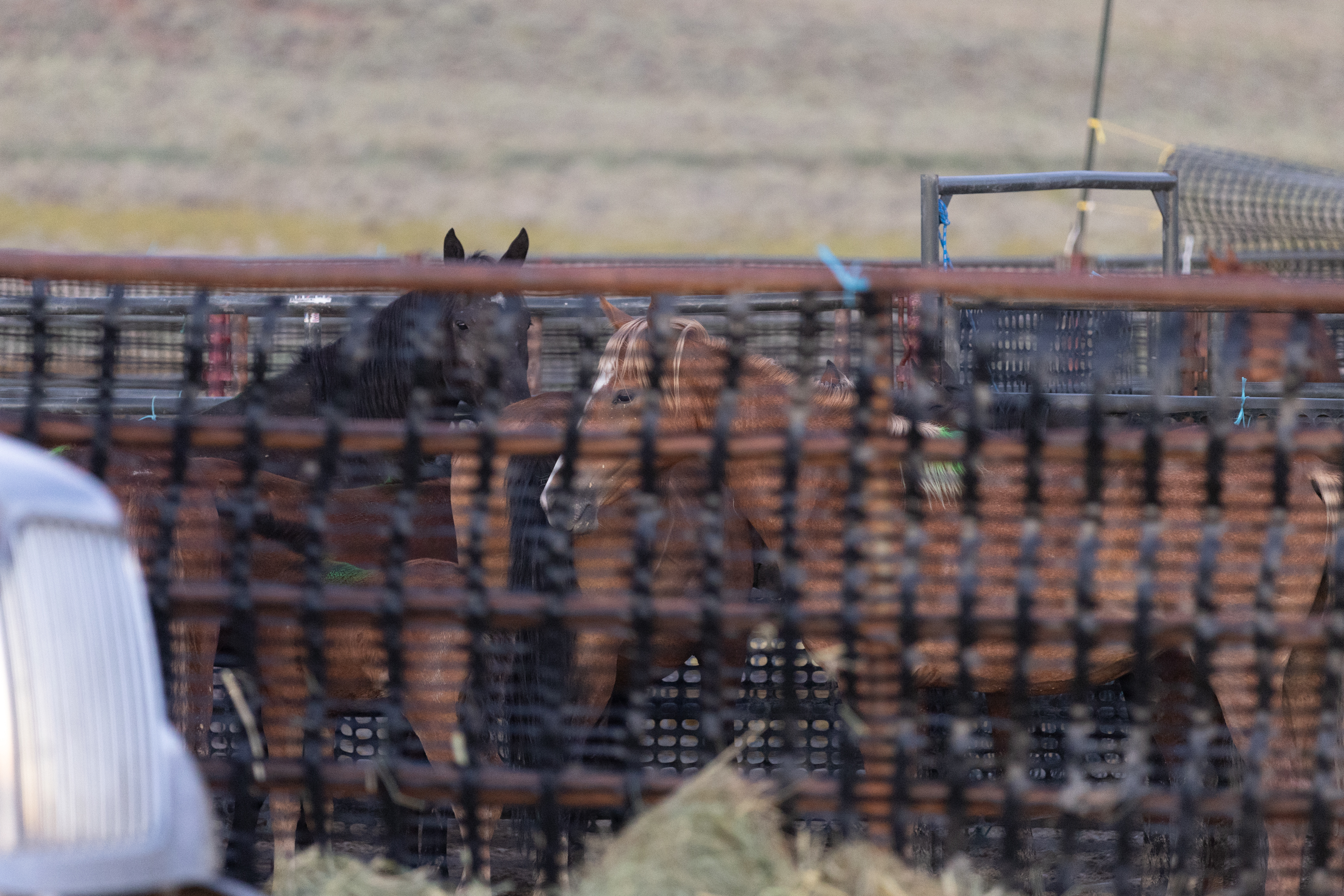

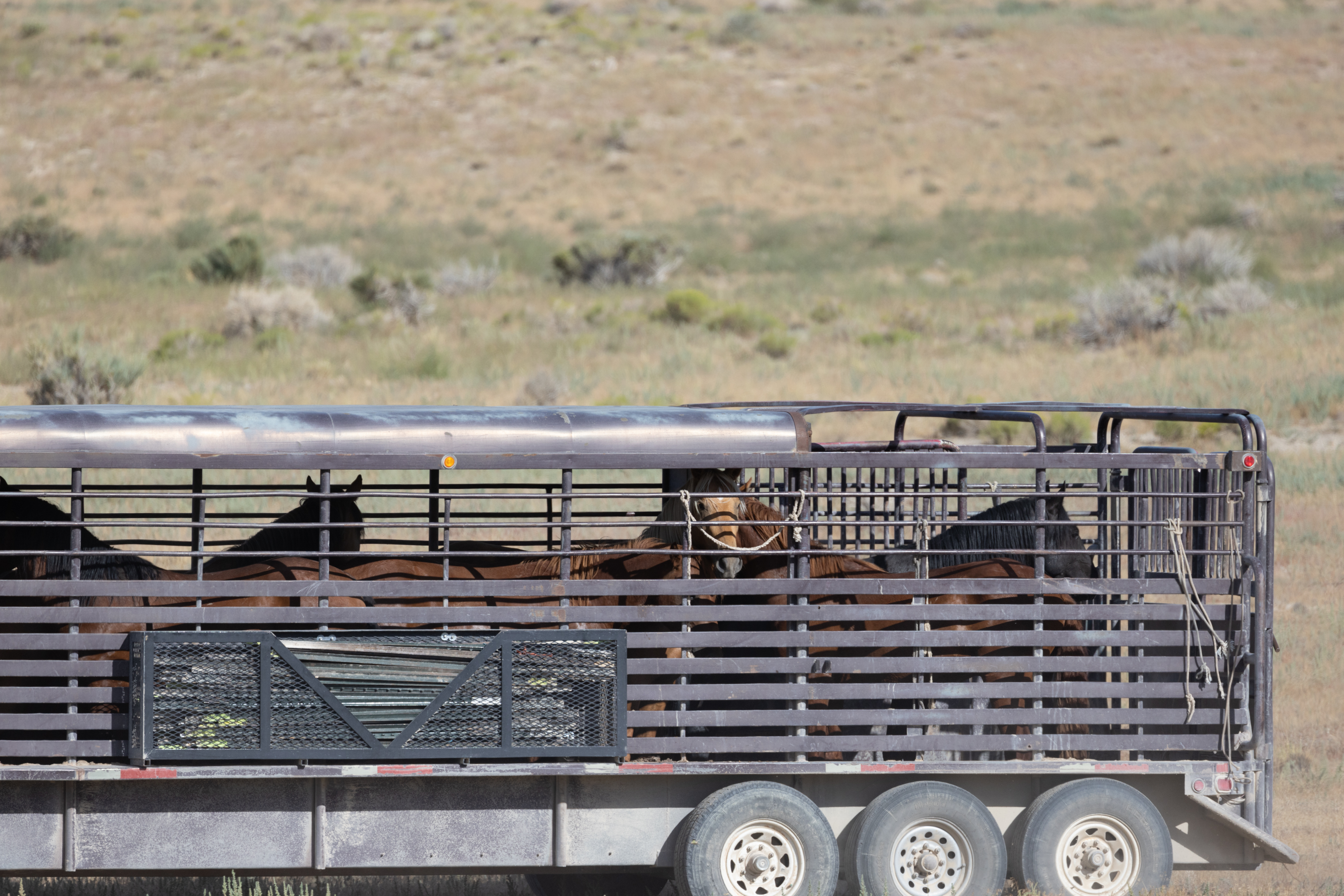
Similar to the first group, they initially turned around near the trap and required multiple attempts to be fully guided in. They entered the trap at 6:44 PM. Shortly after, we noticed a stallion, mare, and foal not far from our observation point. Efforts were made to move them towards the trap, but the stallion changed direction and ran away. Although the helicopter pilot attempted to redirect the stallion, it was unsuccessful. The mare and foal briefly came close to us, within 40 feet, but then returned downhill.
The helicopter pilot decided not to pursue them further. The day's activities concluded at 6:52 PM when the trap was dismantled. We then traveled 26 miles to a temporary holding area, arriving at 7:34 PM. After waiting until 7:45 PM, we were able to walk around the holding area just as the sunset. The horses in temporary holding had access to food, water, and appeared calm.
8 Horses Captured on Saturday
August 5, 2023: We met BLM at 7:30 AM, 9 miles South of Wells, Nevada, and then proceeded to our observation point, which was approximately 25 miles away. Our position was near an old corral in the valley, while the trap itself was situated 2 miles away in the same valley. Unfortunately, due to the distance, terrain, and heat distortion, our viewing experience was quite challenging. We could only see the wings, not the trap, as it was located in a lower area. The valley terrain, with its numerous ravines, often obscured the horses as they moved through the area.
At 11:08 AM, we witnessed the first run of over a dozen horses approaching the wings. The only way we could tell when they reached the trap was by the cloud of dust that emerged from the ravine. Around 11:15 AM, approximately another dozen horses attempted to enter the trap, but they diverted around it instead. The pilot decided to release them and landed to refuel.
Then, at 11:31 AM, we observed the pilot bringing in about 8 horses, which entered the trap at 11:47 AM. Just three minutes later, at 11:50 AM, a group of a dozen horses emerged from the hill behind us. The helicopter flew over to that area and began moving them across the valley.
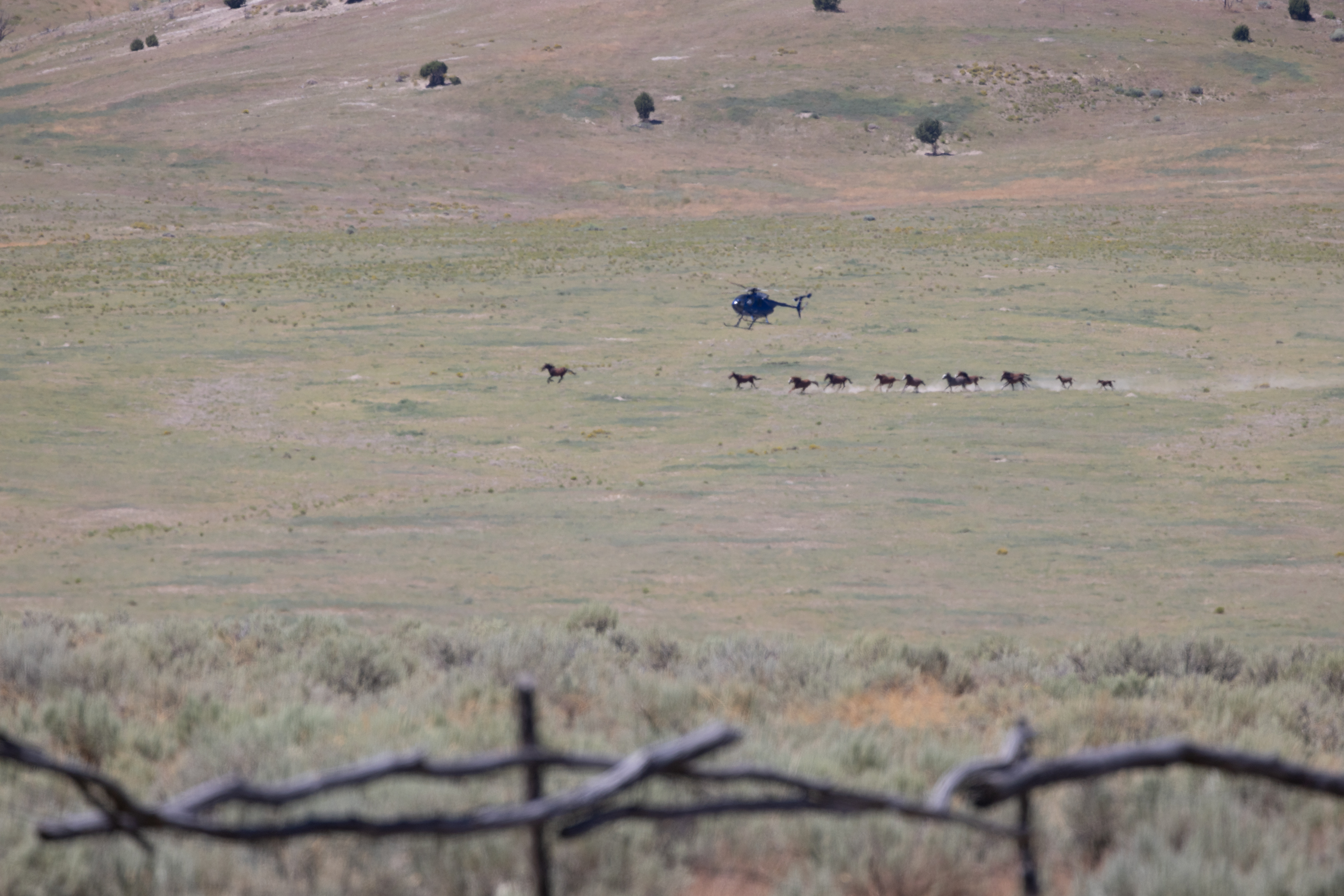
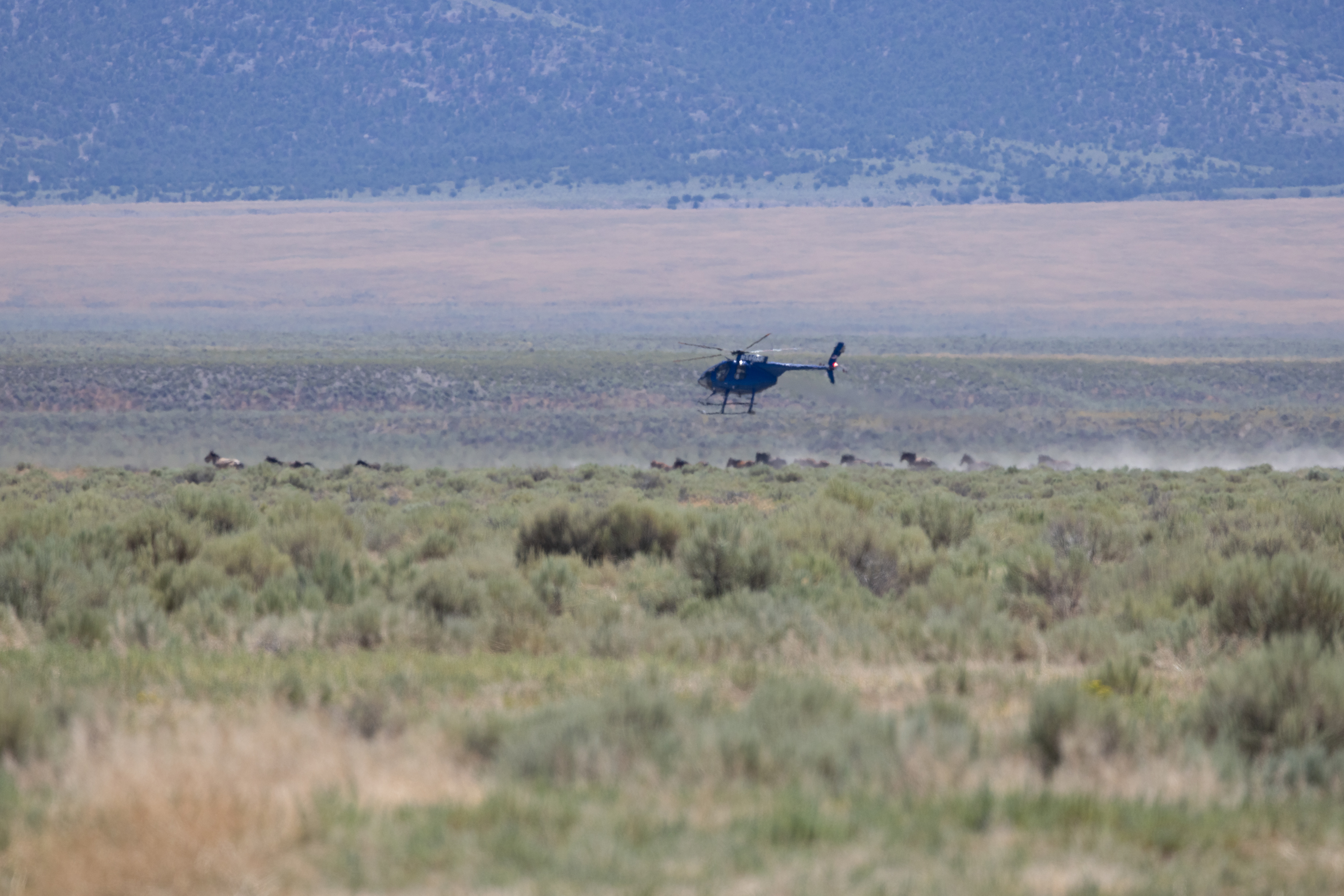
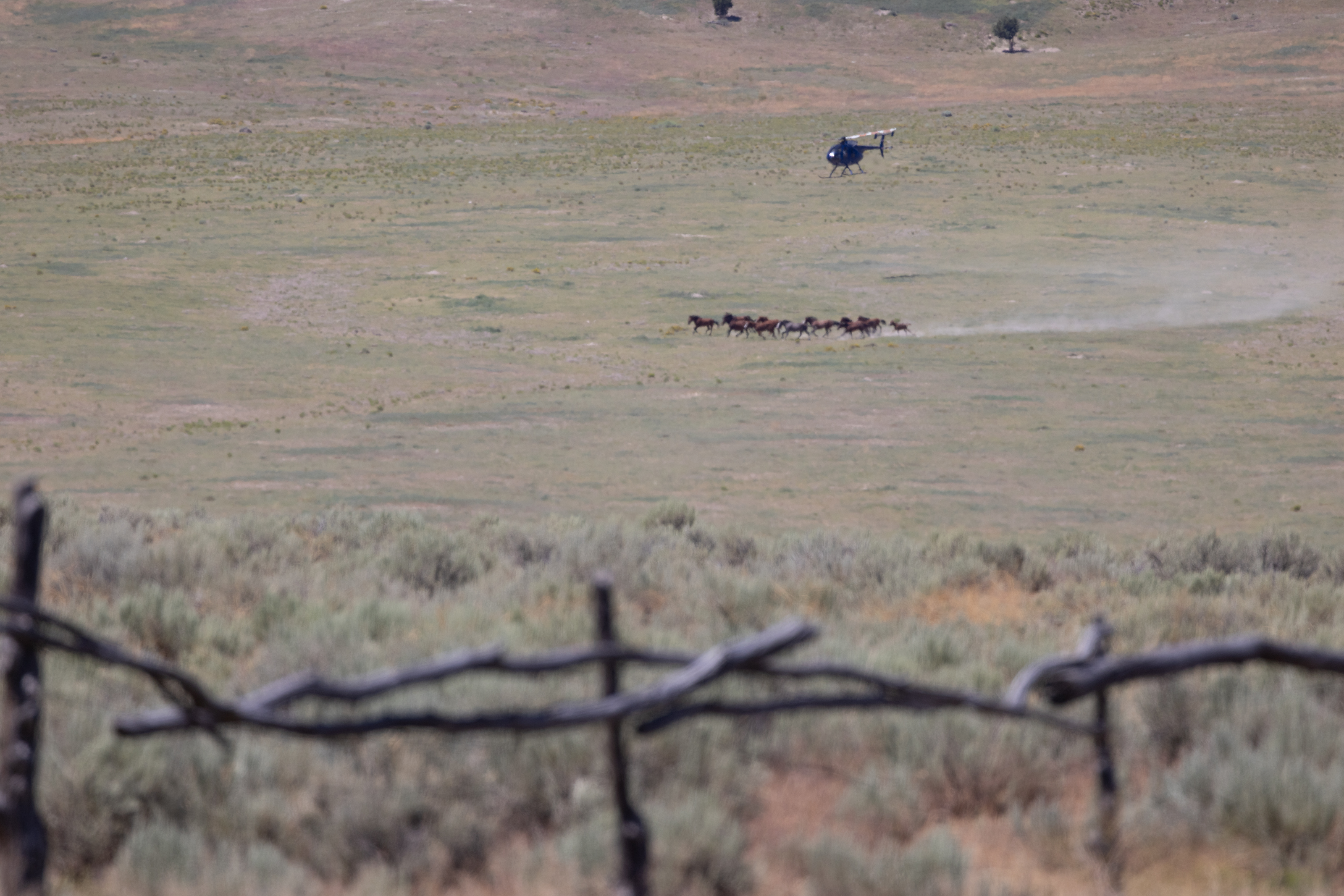

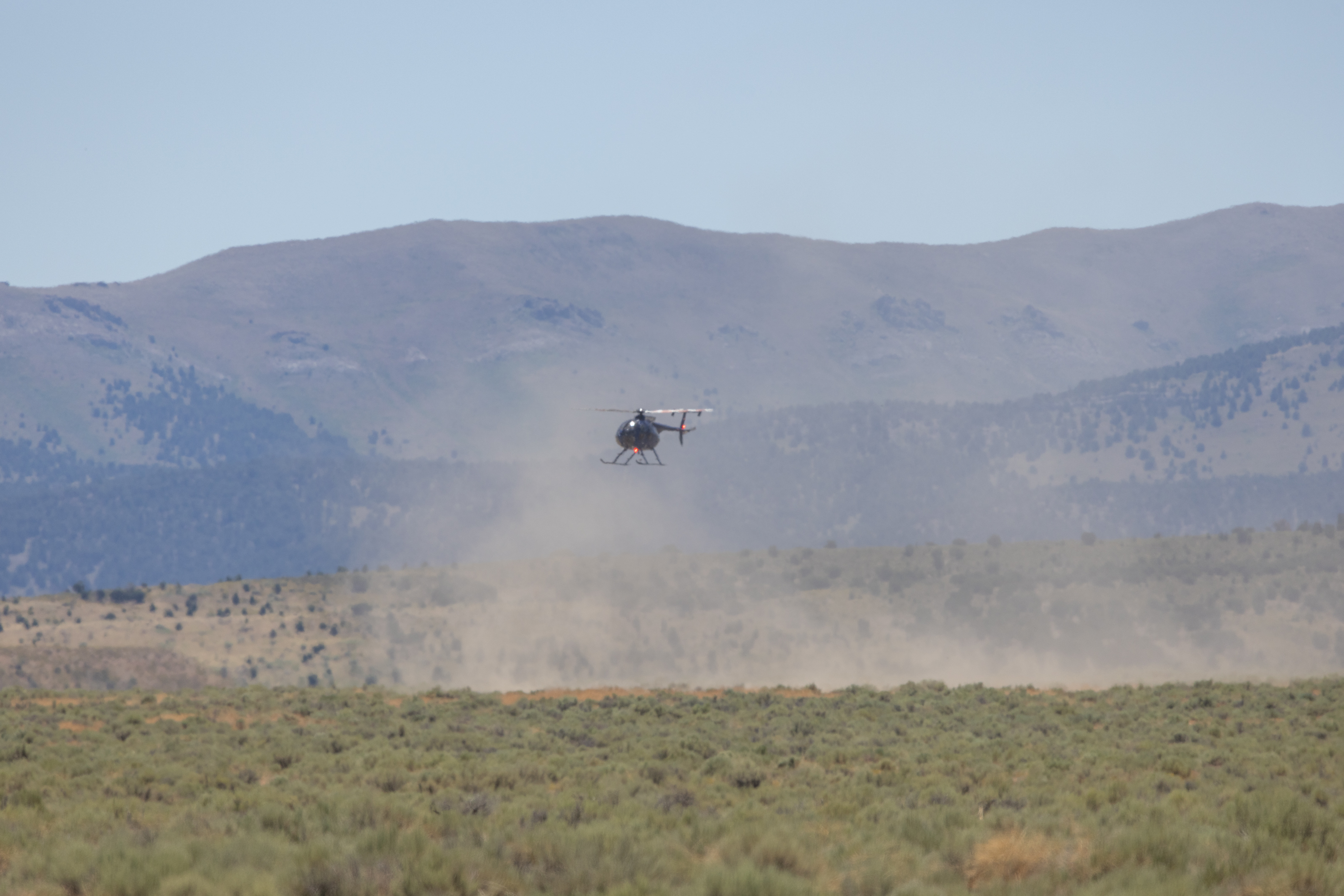
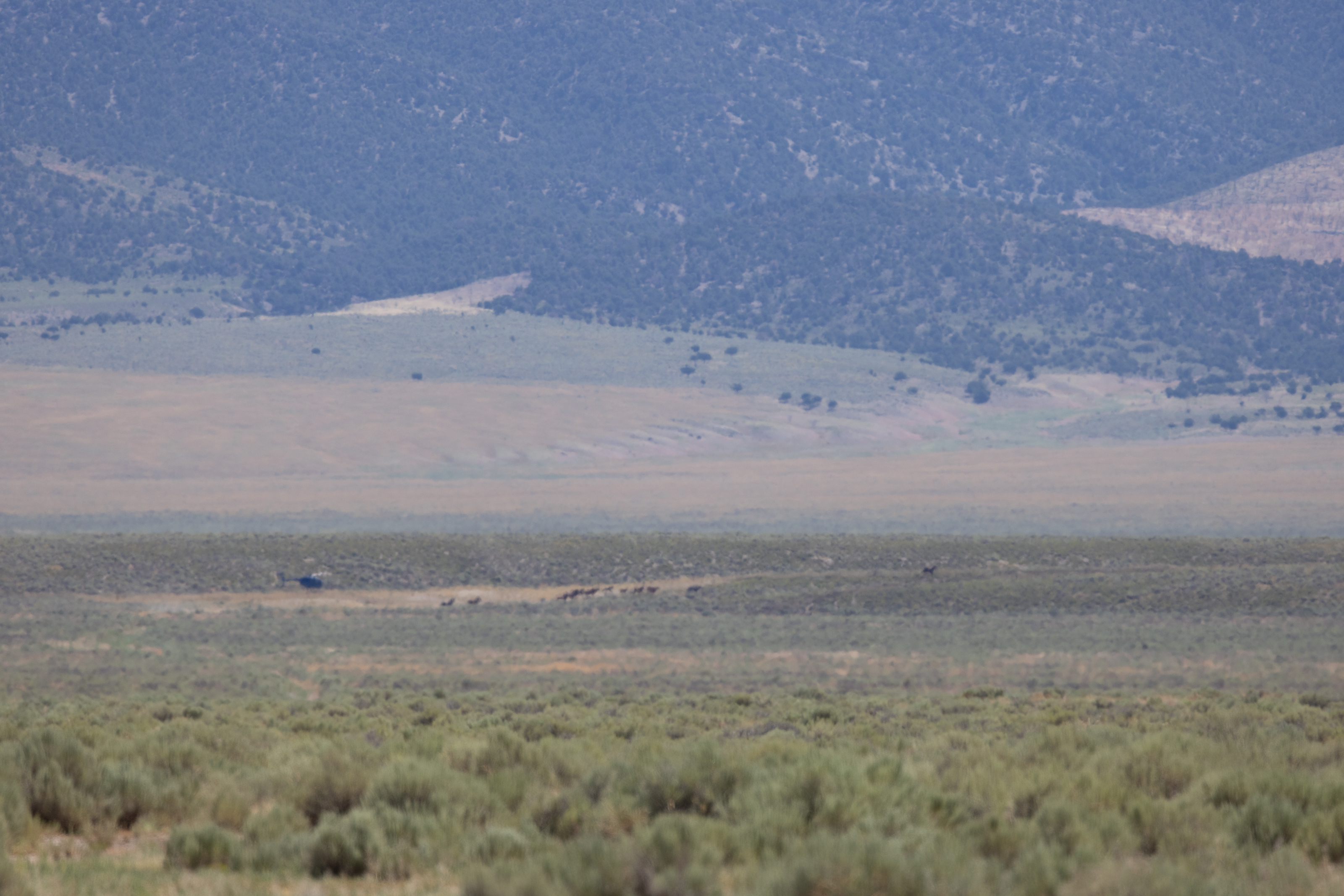
Among the group was a small foal, who occasionally fell behind. In such instances, the helicopter would back off to allow the foal to catch up. They momentarily disappeared from our view as they descended into a ravine, but reappeared 5 minutes later, closer to the trap. It took them approximately 30 minutes to cover a distance of about 2 miles, considering the foal's pace. As the pilot attempted to guide them into the wings, two horses deviated from the group, while the rest continued.
There was some back and forth at the wing entrance, but ultimately, all the horses turned and ran in the opposite direction. The pilot released them all, and the operation concluded at 12:40 PM. There was no visit to the temporary holding area that day, and the trap was dismantled in preparation for tomorrow's location.
56 Horses Captured, 2 Dead: 12-year old, gray are was euthanized for having a tumor, and a 20-year old sorrel stallion was euthanized due to have Lordosis, an exaggerated inward curve of the spine
August 4, 2023: We met BLM at 6:15 AM at the same location as yesterday, which was about 90 miles southeast of Wells, Nevada. By 7 AM, we arrived at the observation site where they were still in the process of setting up the wings of the trap. Since it was a sunny day, the heat distortion and distance made it challenging to take clear photos.
At 7:40 AM, the helicopters arrived and departed to search for horses. Around 8:27 AM, we spotted the helicopter bringing in a small group of horses across the valley. Approximately seven horses entered the trap at 8:40 AM. Over the next 30 minutes, we observed several more small groups of horses moving toward the trap from a farther distance. The helicopters maintained a distance to allow them to move at a slower pace. At 9:35 AM, the first small group of four horses entered the trap, followed by another group of about ten horses at 9:42 AM. Four more horses entered five minutes later.
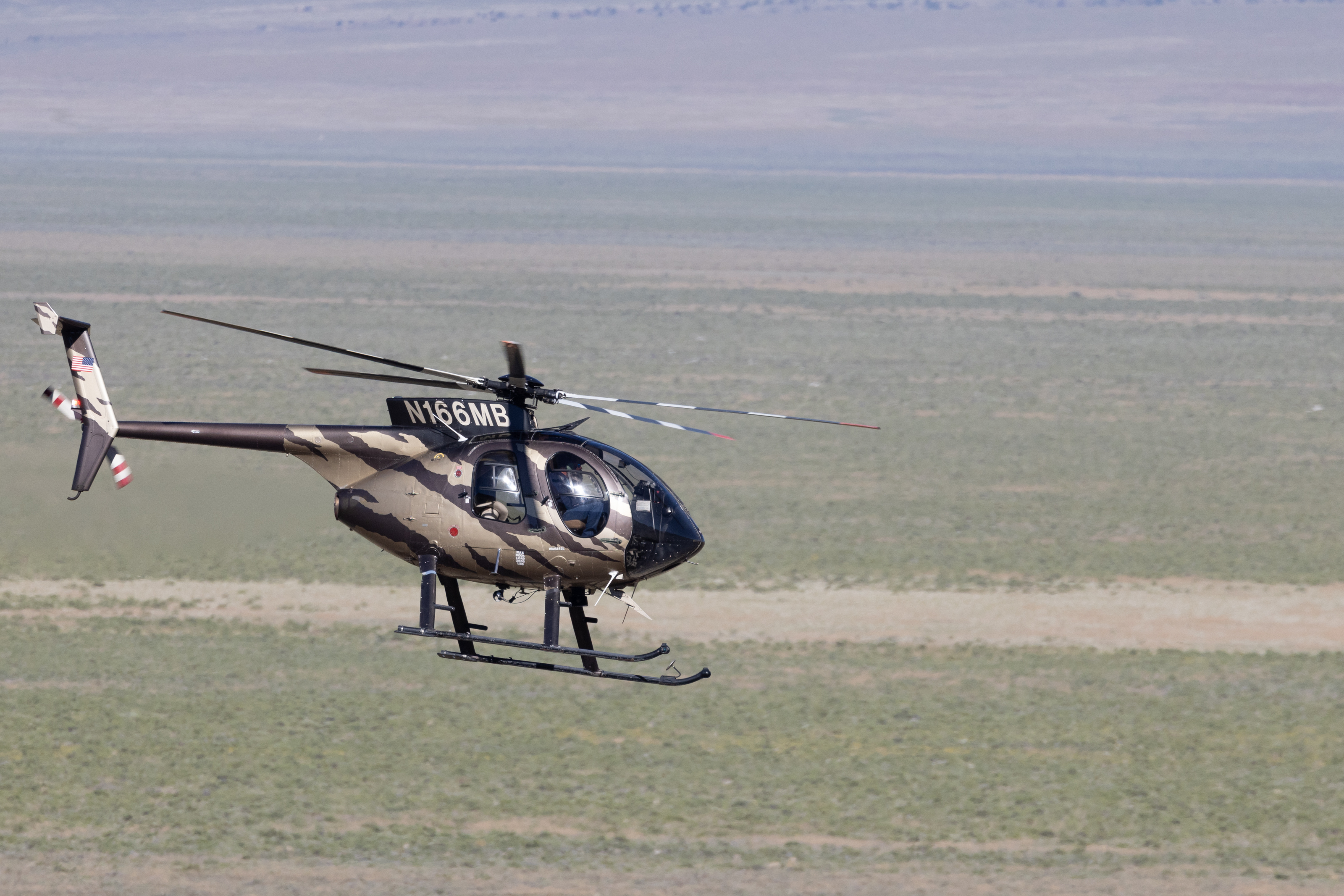
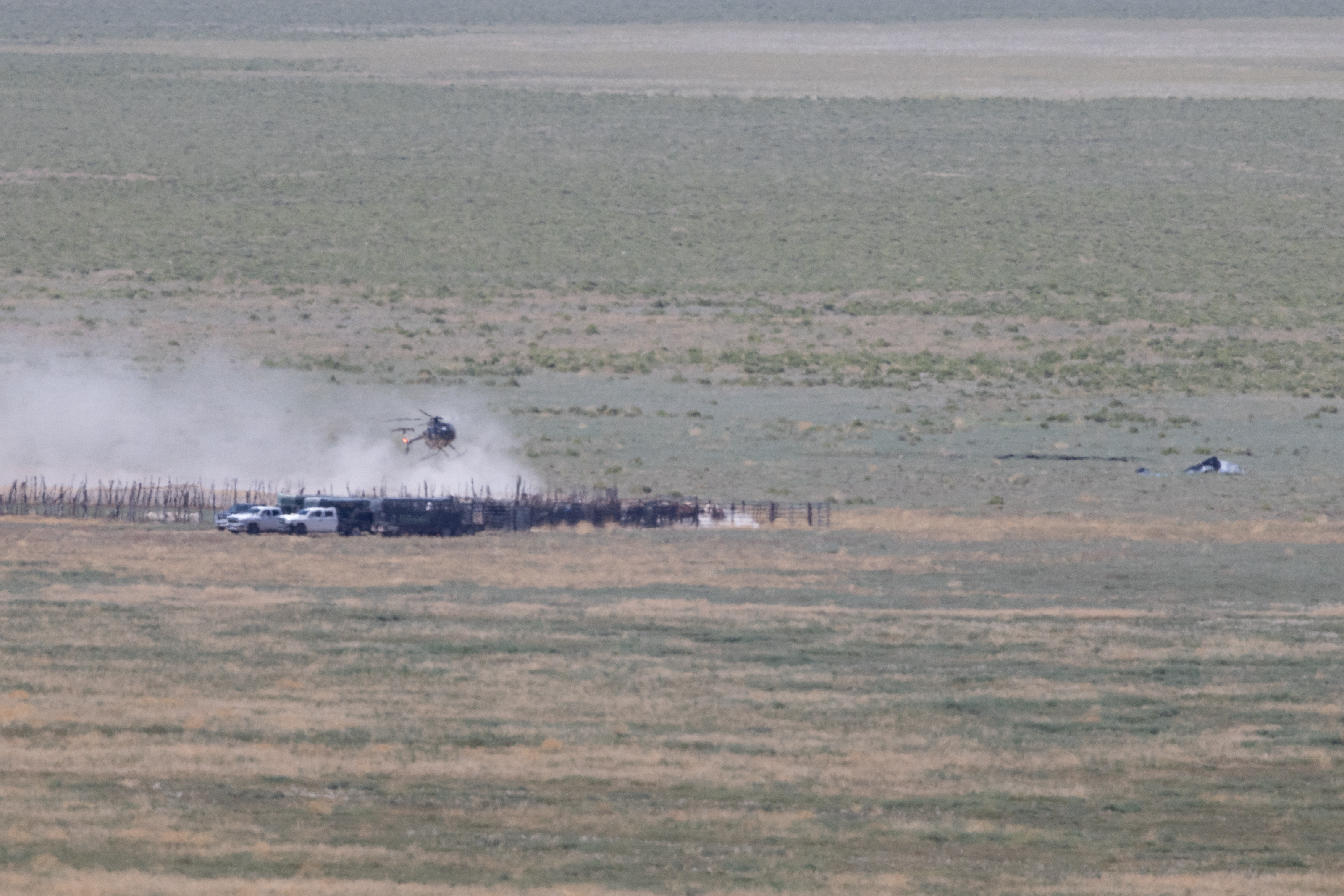
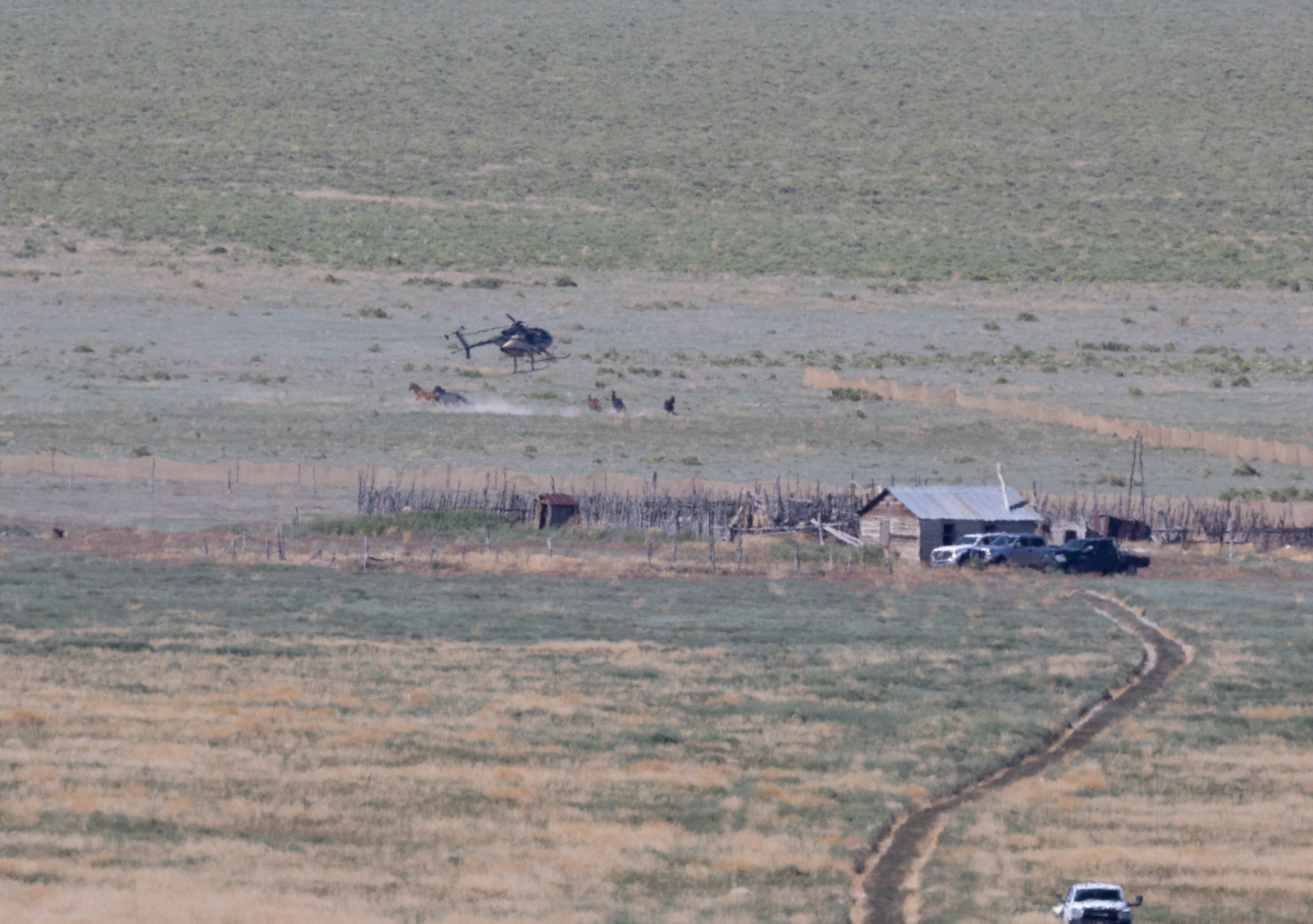
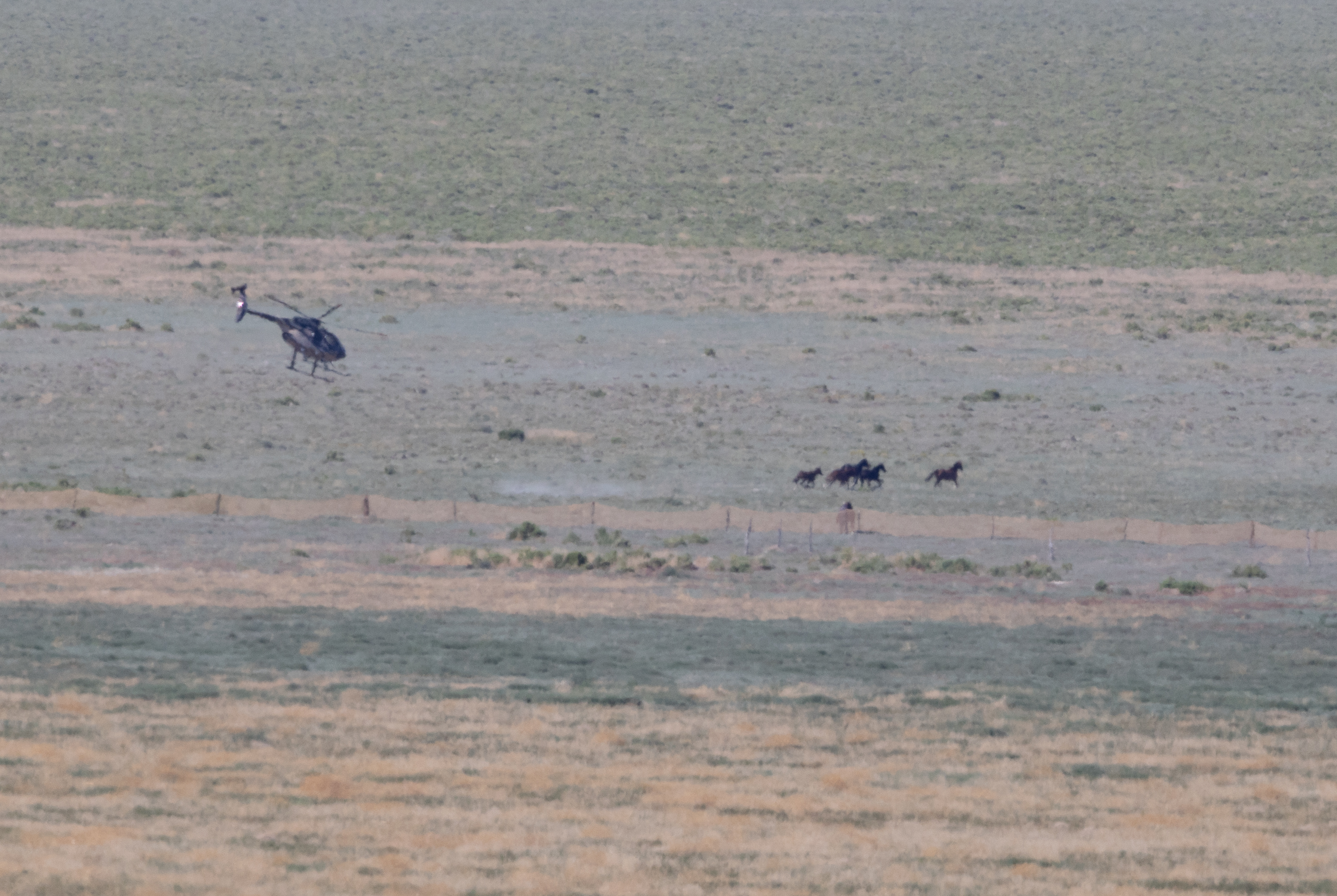
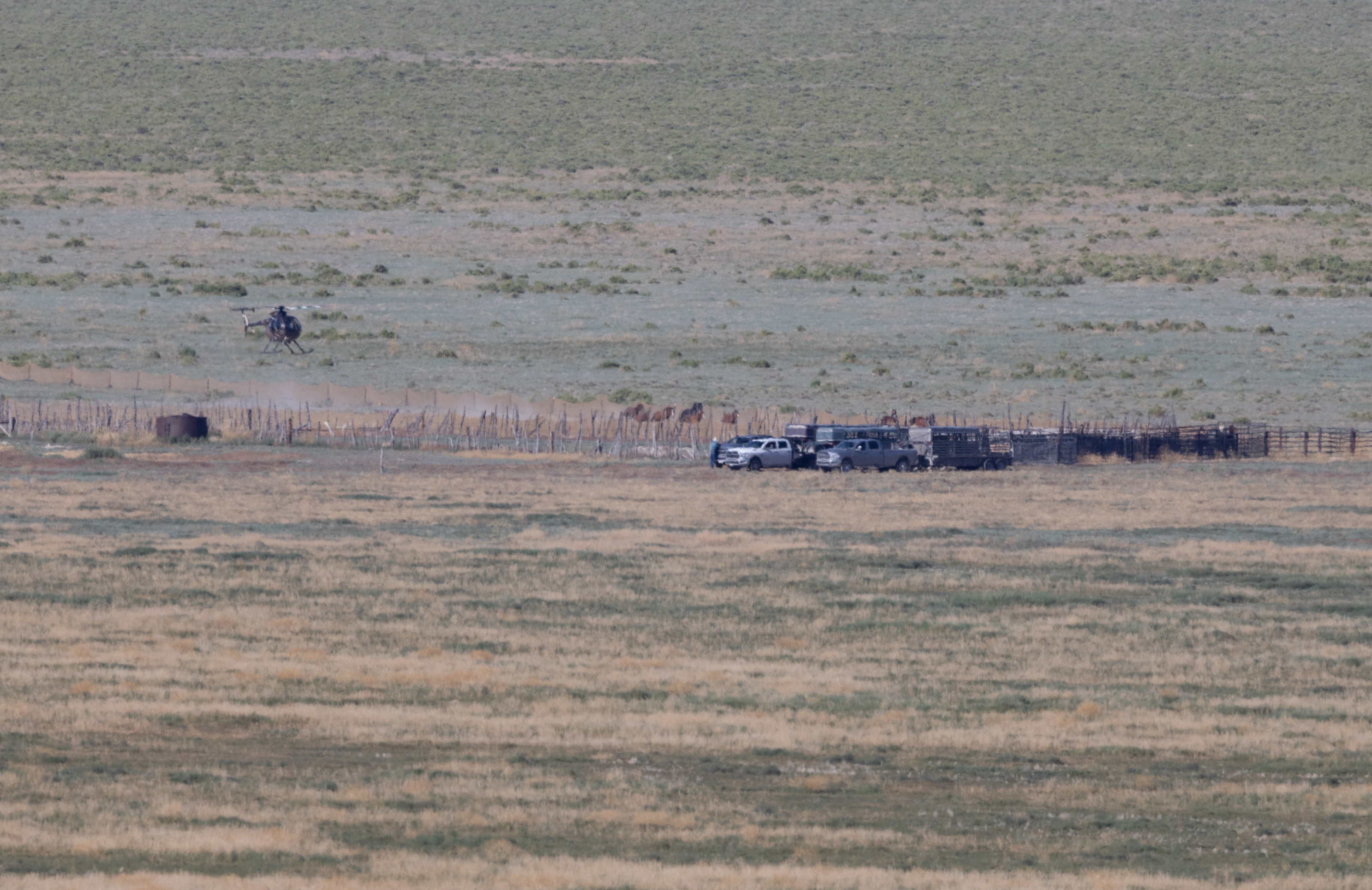

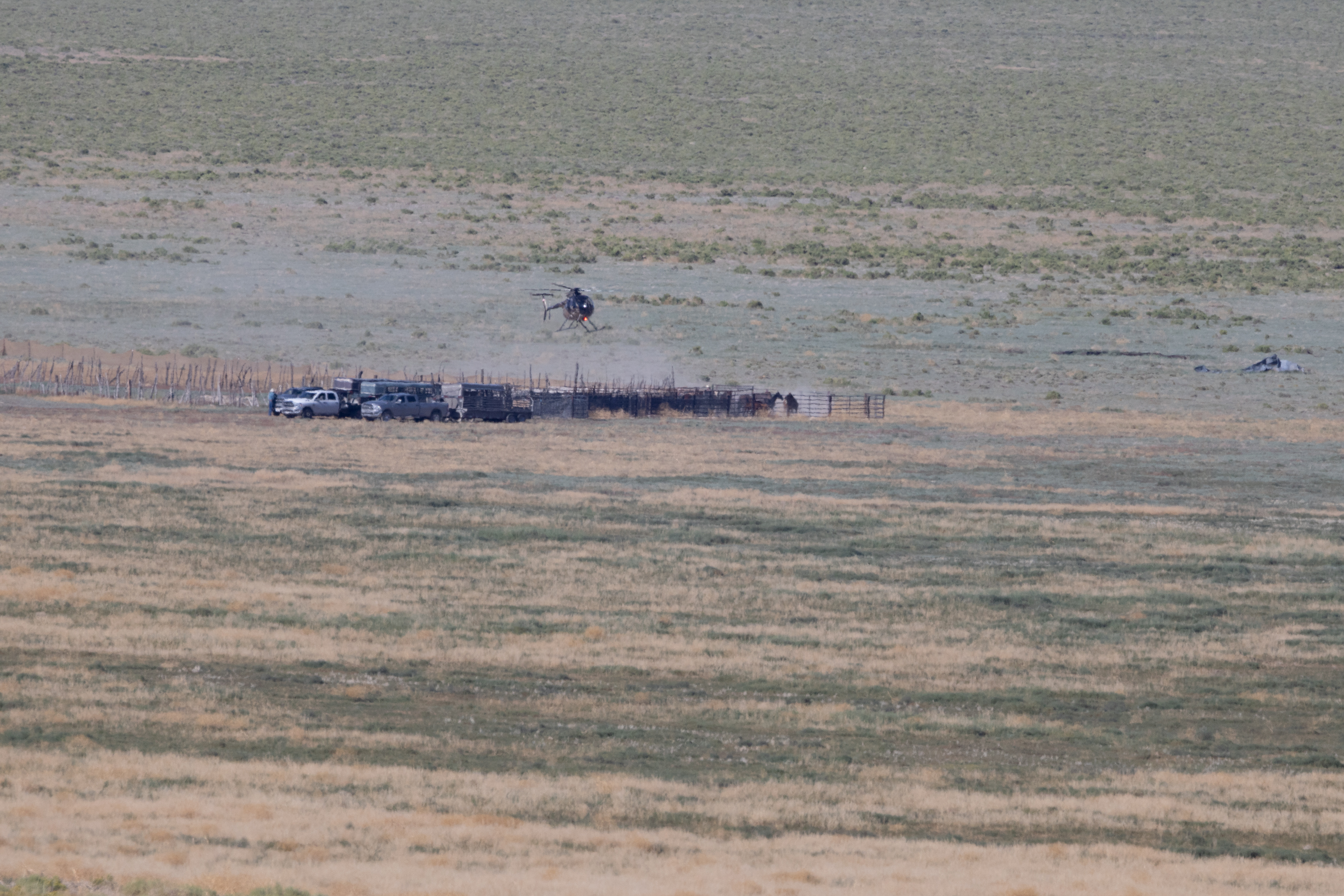
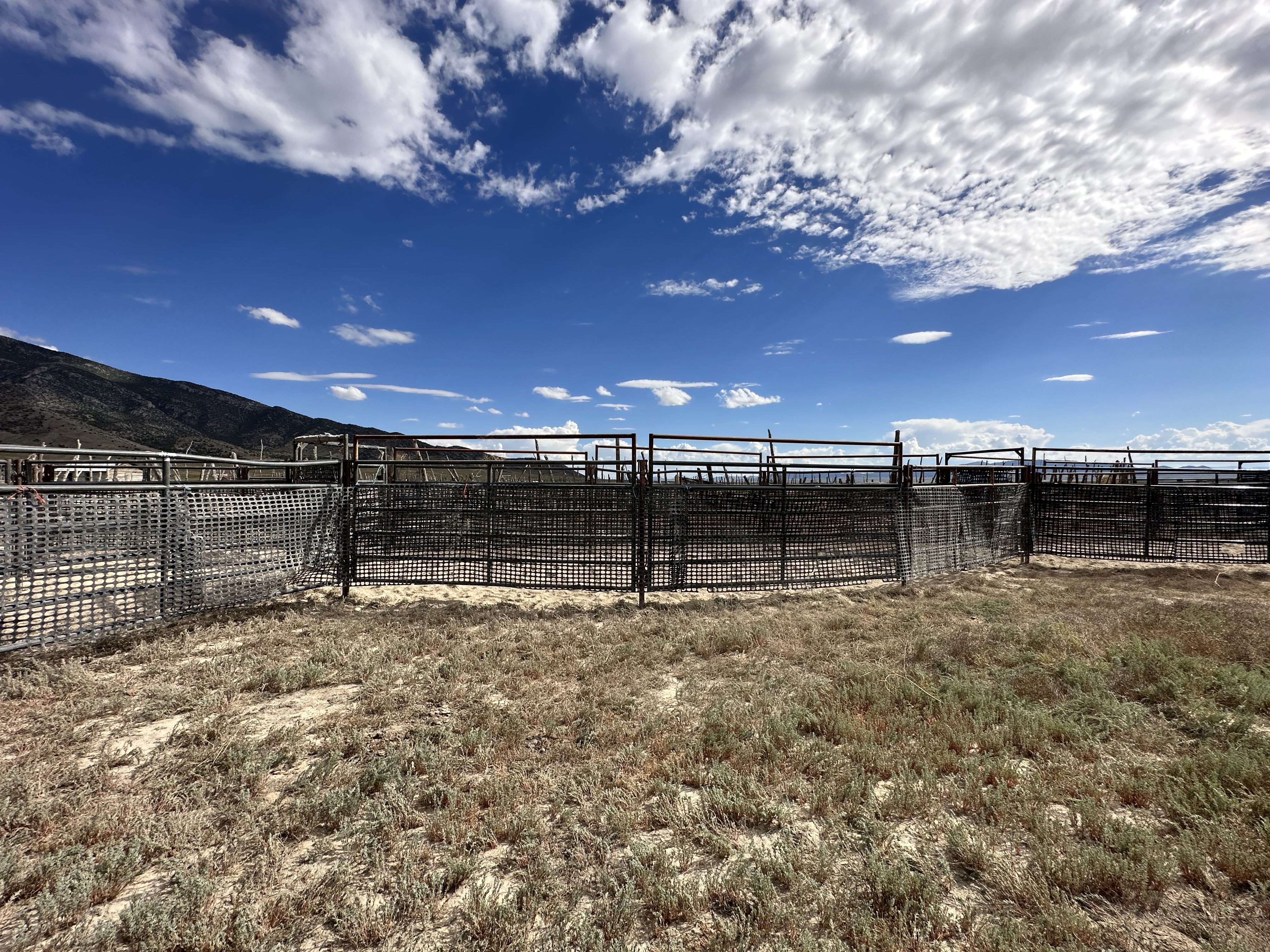

During this time, it looked like one horse ran into a panel and fell, but it appeared to recover and walk away. However, due to the distance, it was difficult to determine if it was injured. Both pilots refueled and left before returning with horses from the West after nearly an hour. At 11 AM, a small group of horses entered the trap, with a foal at the tail end.
The foal turned around and ran out of the wings, prompting the helicopter to follow and attempt to steer it back. After a couple of minutes, a wrangler rode out and roped the foal, successfully bringing it back into the trap. At 11:14 AM, a group of six horses entered the trap, followed by another group of four at 11:24 AM, and then six more at 11:57 AM. An hour later, the helicopter reappeared, moving six horses, including a foal, at a slower pace.
By 1 PM, as they entered the wings, one horse veered off and ran in the opposite direction, while the other five went into the trap. The pilot did not go back for the horse that broke away. Initially, there was some debate about whether it was a smaller horse or the foal that broke away, but after reviewing video footage, it was confirmed that it was a stallion, and the foal had indeed entered the trap. At 1:14 PM, three more horses entered the trap, and the day's activities concluded at 1:30 PM. We did not visit the temporary holding area today.
130 Horses Captured, 2 Dead: 15-year old mare died from a fractured hip, a 1-year old stallion died from a fractured shoulder
August 3, 2023: We met at 7am, approximately 90 miles Southeast of Wells, Nevada, and then traveled another 20 miles to the observation site. From there, we were situated a little over 1/2 mile away from the trap. Our visibility of the wings and part of the trap was partially obstructed by the contractor vehicles. The weather was cooler and overcast.
When we arrived a little before 8am, there were already 2 helicopters in the air. We witnessed them bringing in a large group of at least 100+ horses across the valley. They proceeded to bring them into the trap in groups of about 10 at a time through multiple runs. The first group went into the trap at 8:40 AM, and although a foal got briefly separated, it was quickly brought in without any issues.
Ten minutes later, a second group came in, but 6 of them turned around and ran back out when they were almost at the trap. At 9:15 AM, there were multiple groups of horses running back and forth, making it difficult to keep track of them with two helicopters flying simultaneously. Another group went into the trap at 9:29 AM. These horses had been on the move since before we arrived, so they appeared tired and were moving more slowly.
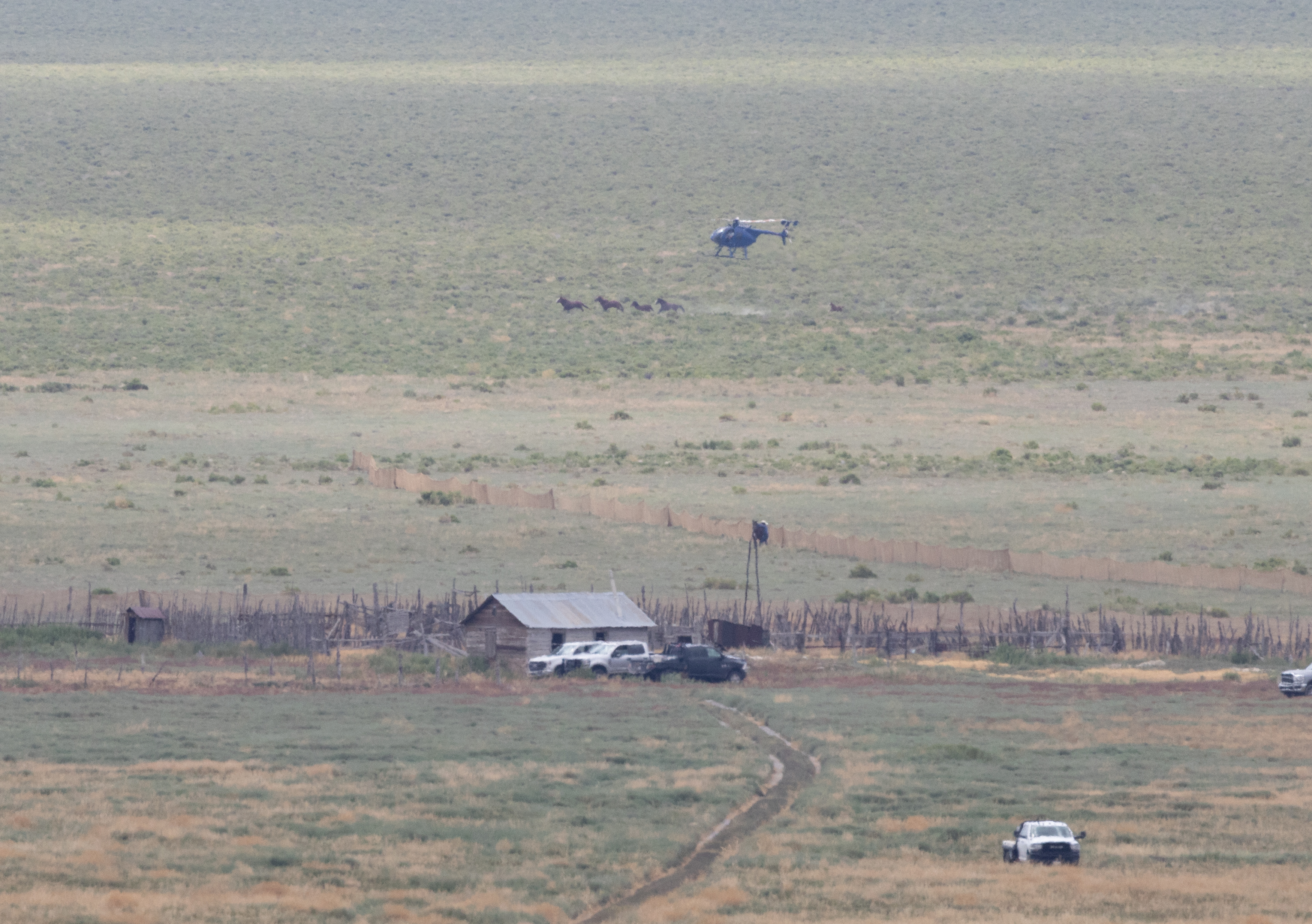
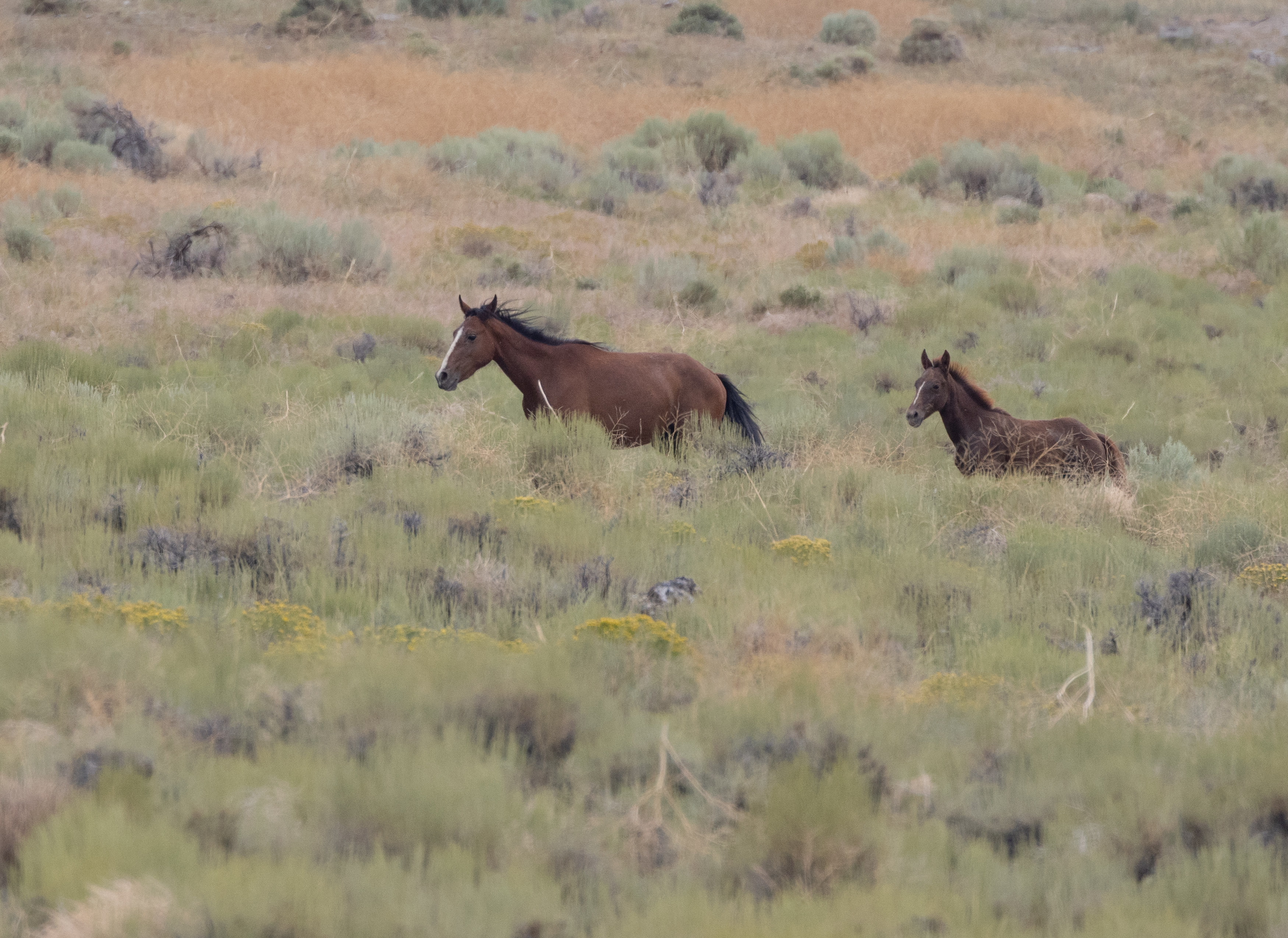
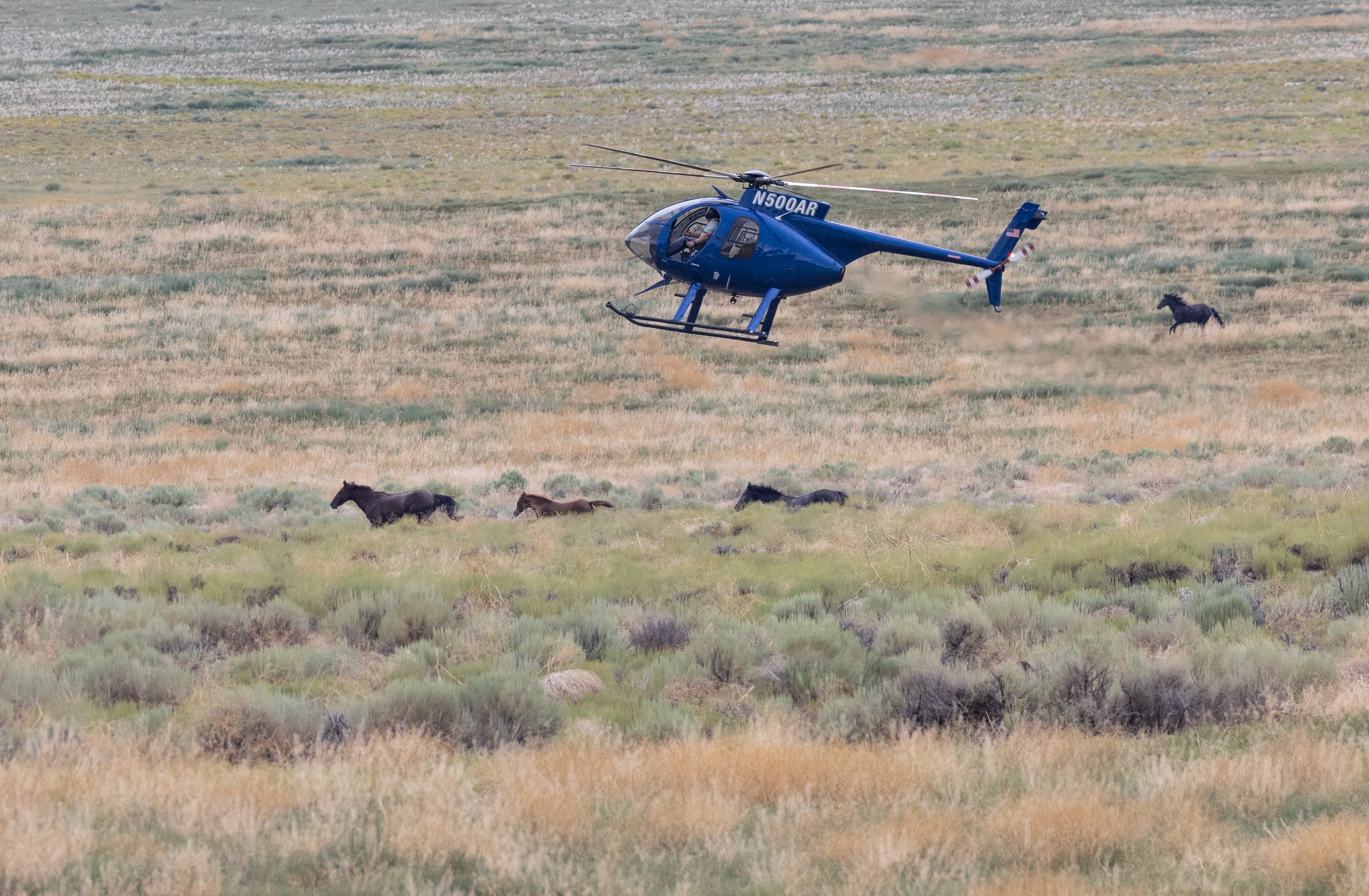
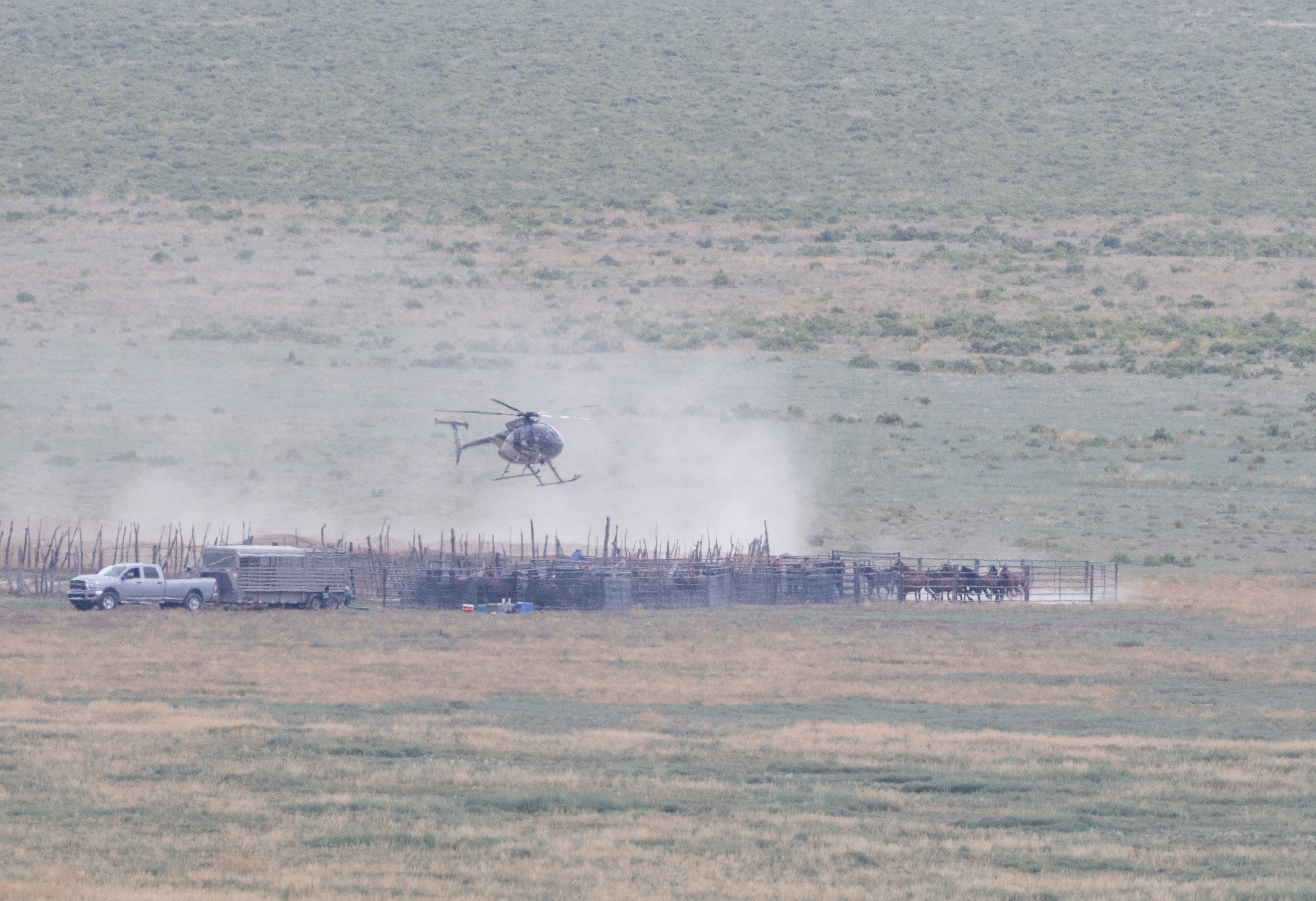
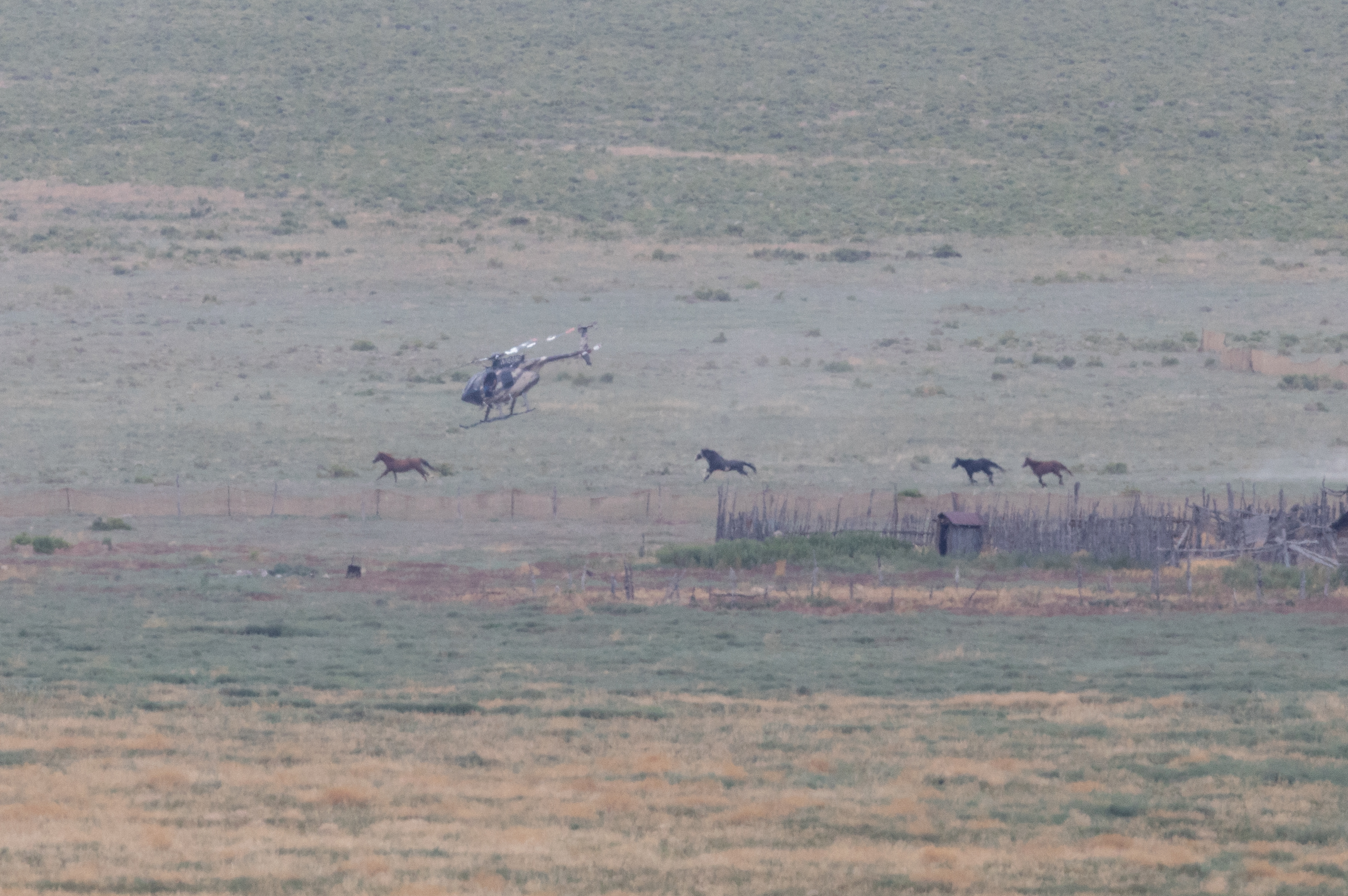
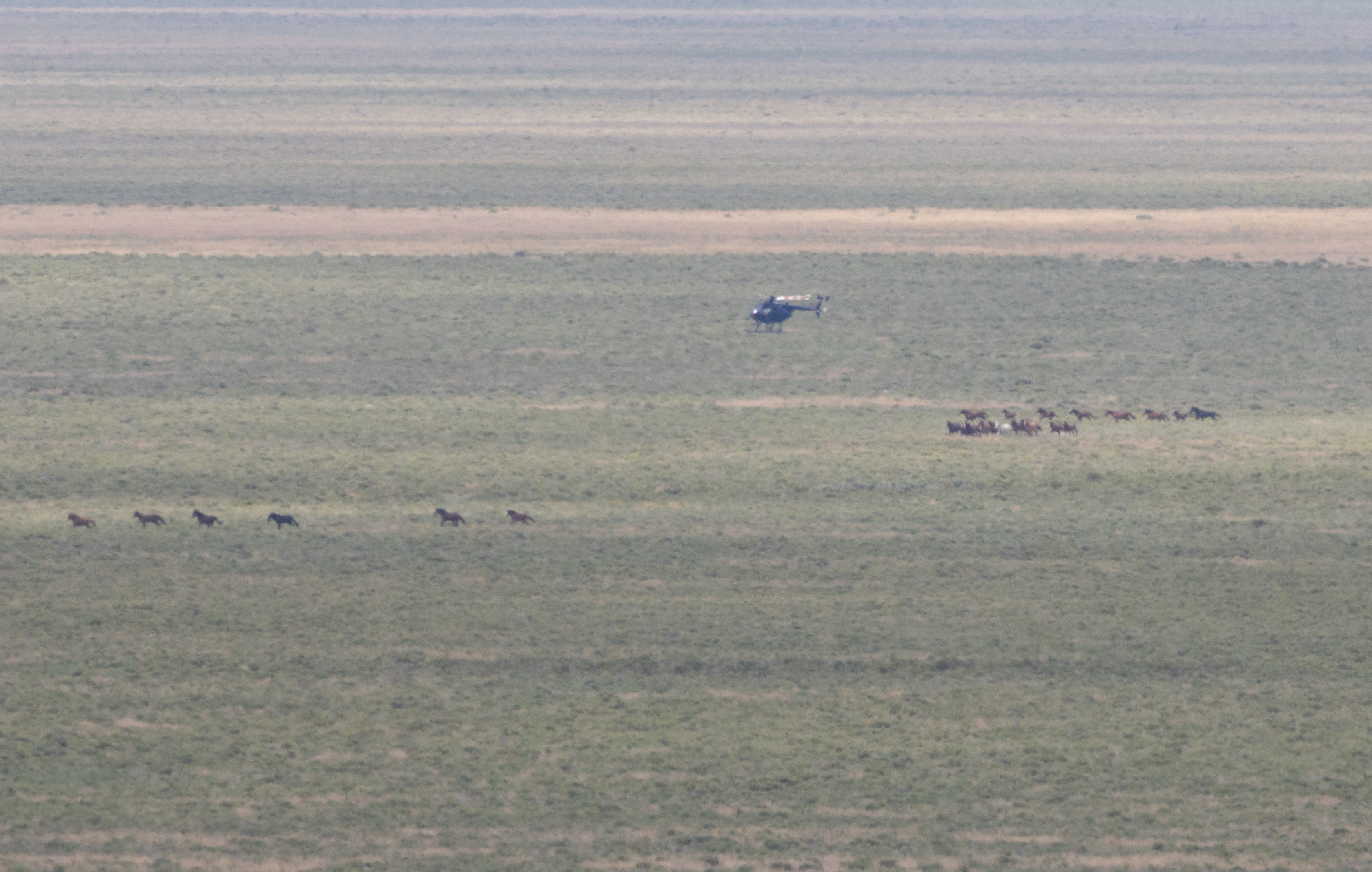
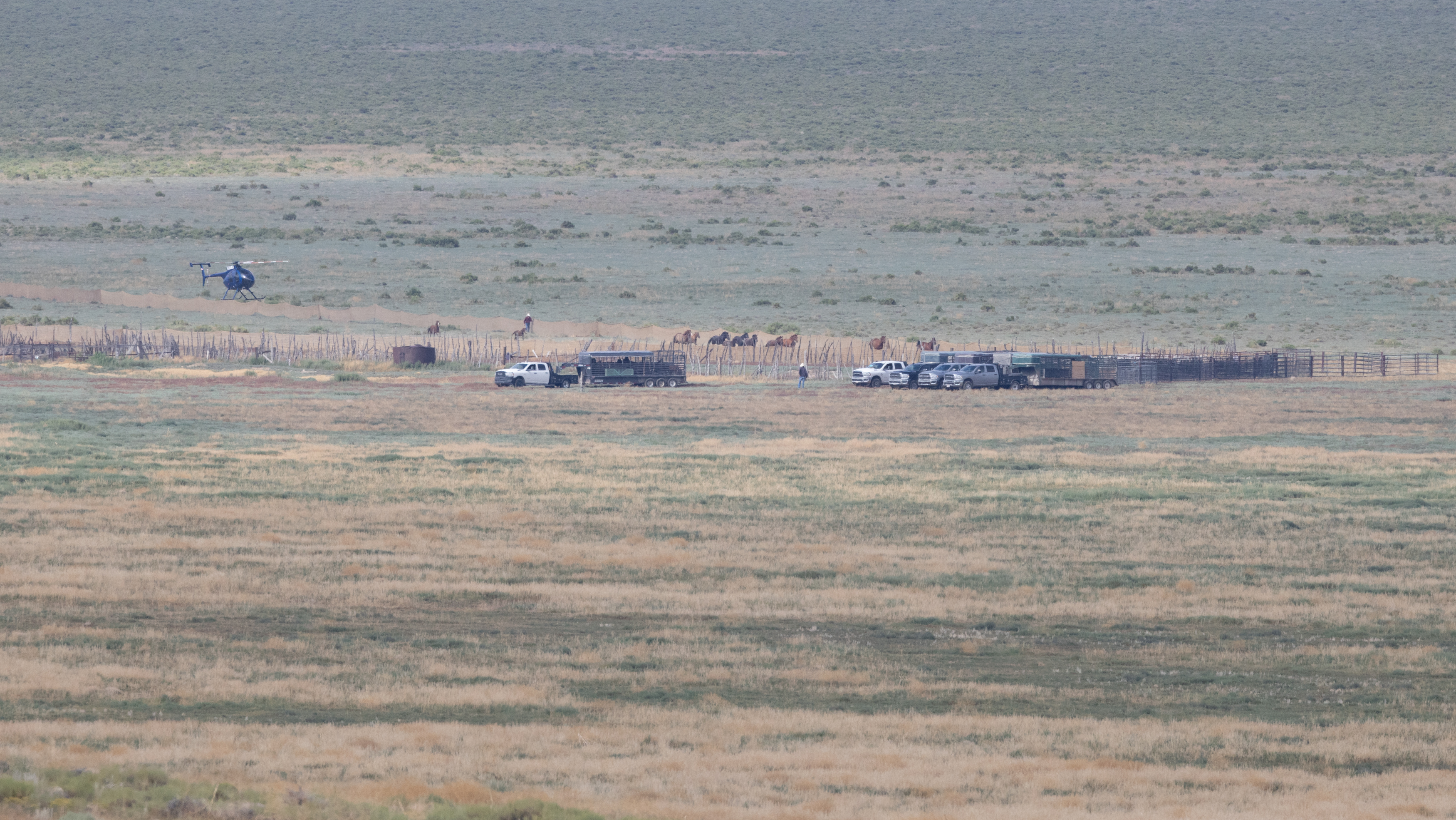



To make room in the trap for more horses, three trailers of horses left for holding, and the helicopters landed for about 20 minutes. It was quiet for the next 30 minutes, and then both helicopters resumed moving large groups of horses toward the trap. Within a span of 10 minutes, three separate small groups entered the trap, with the last group entering at 10:57am. In this group, one horse broke off and ran back out of the wings.
The pilot spent 15 minutes trying to get her to go back in, but she seemed very tired and walked slowly or stood still. Eventually, at 11:13am, wranglers went out and roped her. While they were trying to bring her in, the other helicopter was attempting to bring in four horses, but they kept turning around multiple times. The pilot eventually left them alone and landed.
The wranglers continued their efforts to bring in the lone mare at 11:39am. She put up a fierce fight, kicking and bucking, refusing to budge. It was astonishing to witness her determination to stay free. At 11:42am, they brought out a trailer for her and attempted to get her inside. She went halfway but stumbled back out. They tried again, and she came back out once more, this time ending up on the ground.
Due to the distance and people standing nearby, it was challenging to see exactly what was happening, but it was clear that she was on her side and not moving much. They brought out a large board to create a ramp onto the trailer, and a few people pushed her into the trailer at 11:50am. This happened nearly an hour after her family went into the trap. Witnessing her fight so fiercely made it difficult to watch her being loaded into the trailer. I inquired about her at the trap site, and they mentioned she was an older mare who was quite thin. She likely collapsed from exhaustion. However, they assured me she was up and moving around fine at temporary holding, although I didn't personally see her to verify.
Between noon and 1:00pm, there were five smaller runs. During this time, a mare and her foal passed by us and managed to escape to the hills, remaining free for the day. Around 1:10pm, a group of four, including a foal, came into view. They entered the wings, except for the foal, who ran along the side toward the front of the trap and circled back around. A wrangler went out, but we couldn't see if he roped the foal. Shortly after, they all came into view and made it to the trap without any issues.
The helicopters landed, took a break, and then resumed flight at 1:30pm. An hour later, at 2:30pm, we saw them bringing in horses from a distance. At 2:42pm, a group of six horses came in. As they entered the wings, one horse tripped and fell but managed to get back up and seemed fine. Just before 3:00pm, four horses entered the wings but turned around and ran back out as they approached the trap. I'm quite certain these were the same four horses they attempted to get in around 11:13am without success. At the same time, a stunning grey stallion ran right by us and escaped to the hills. The decision was made to call it a day at 3:00pm. We waited near our vehicles until we received clearance to leave the observation area, which was approximately an hour later. We made a stop at the trap site and walked around to observe it before heading to the holding area, which was 23 miles away.
We arrived at temporary holding at 4:50pm and had to wait before we could walk around. However, we were able to observe the sorting process from a distance, although it was mostly obscured by contractor trailers. We finally had the opportunity to walk around at 5:25pm, but the horses were already fed, watered, and appeared calm.
71 Wild Horses Captured on Wednesday
August 2, 2023: We met BLM and traveled to observe at the Butte Valley turnoff. The observation began at 8:57 am and concluded around noon. Our primary focus was on the trap site and the treatment of horses during the process.
Upon arrival at the trap site, we noticed that all the barbed wire fencing had been flagged, and no jute was hung on any of the barbed wire. This lack of visibility made it difficult to locate the trap, as it was strategically positioned behind the trees. As a result, our ability to observe the horses being maneuvered into the trap or the direction from which they were brought in was severely limited. We could only catch a glimpse of the horses as they passed by and entered the trap. This limited visibility, whether due to distance or obstruction, raises concerns about ensuring humane treatment within the trap area.

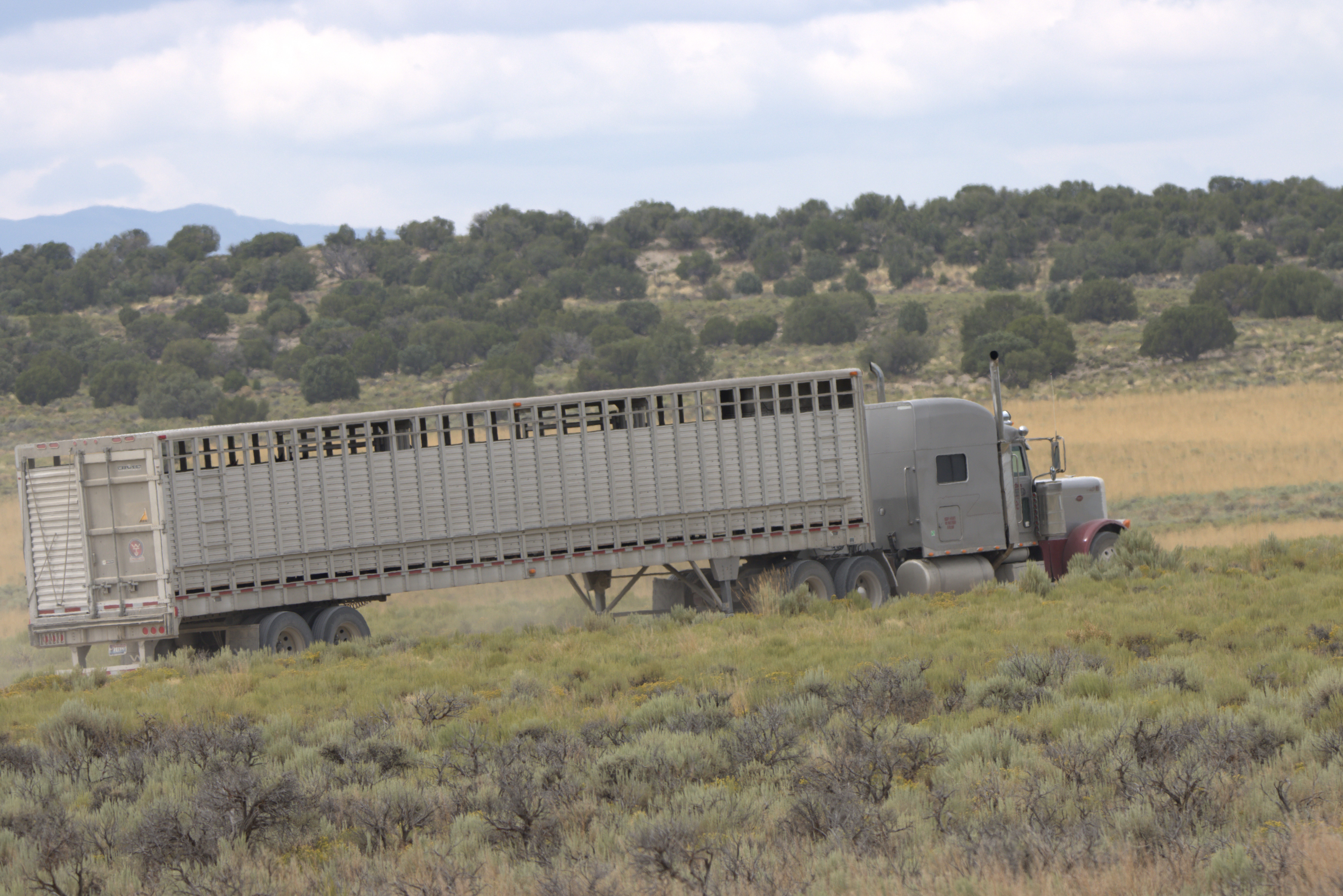

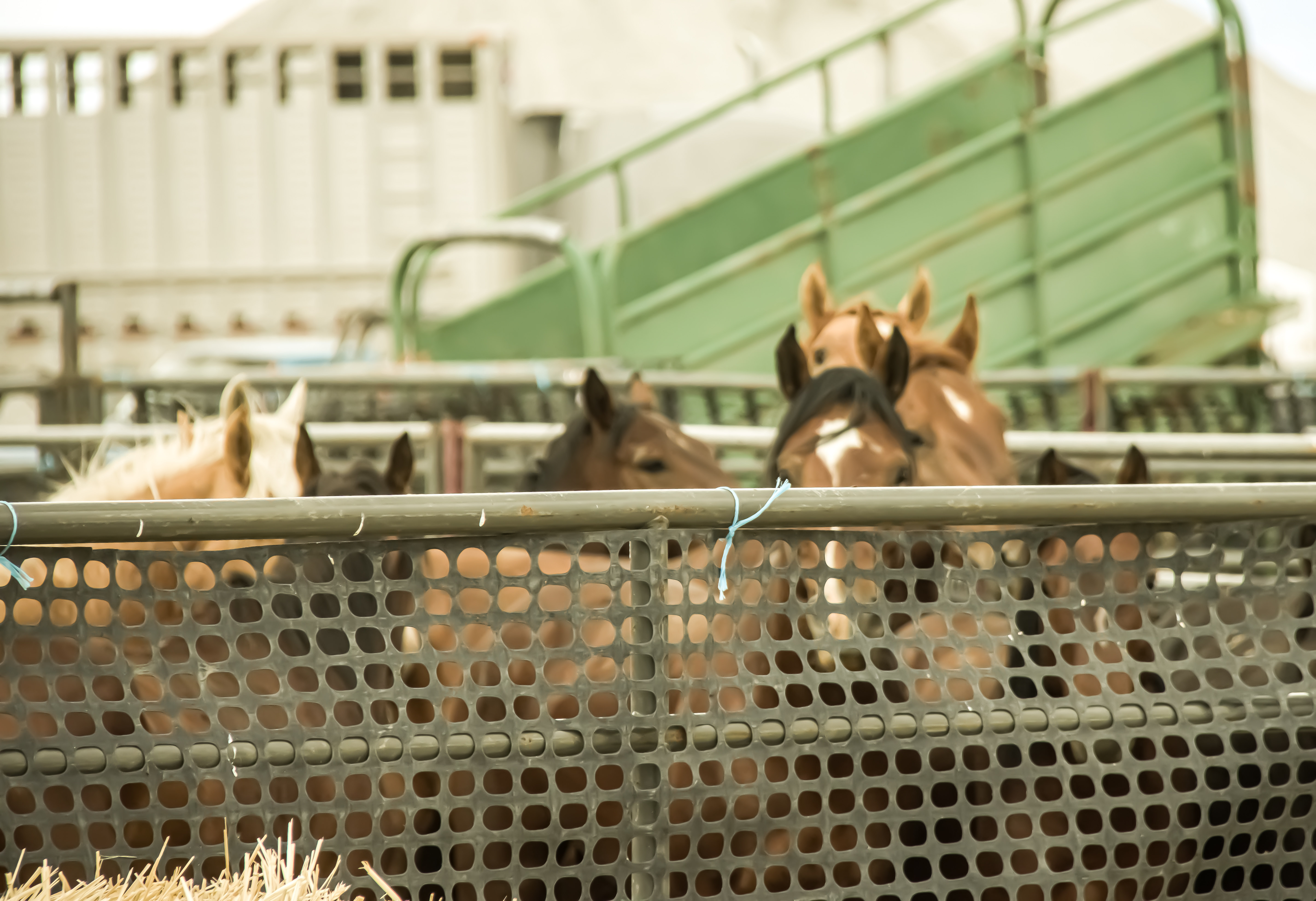


Without the ability to view the loading, we have no way of confirming if the loading ramps are secure with a non-slip surface or if electric stingers are being used, among other potential safety and welfare measures.
62 Wild Horses Captured on Tuesday
August 1, 2023: We met with BLM personnel at a designated location approximately 9 miles south of Wells, NV at 6:30 am. We were given the option to either go to the holding area or take a tour of one of the two traps that have been in use recently. We chose to view the trap after observing the situation.
The observation site was the same as it has been for the past few days, and we arrived at around 7:30 am. Initially, we couldn't hear any helicopters, but at around 10:00 am, we could hear them in the distance. They appeared over the ridge and seemed to be struggling to guide the horses toward the trap area. It's possible that they were actually pushing them toward the second trap, which was not within our view.
The first group of horses started coming down through the ridge at approximately 10:46 am, consisting of around 20 horses. Another run occurred around 12:00 pm, bringing down the second group of the day. The distance between where the horses were being brought off the mountain and the trap area provided them with room to split off. It seemed to be around 2 to 3 miles to reach the trap.
During this process, two foals had to be roped from the second run. The first foal, which may have been slightly older than a typical foal (difficult to determine due to the distance), put up quite a resistance while the helicopter hovered overhead and the wranglers attempted to rope it. Eventually, they managed to rope the foal and led it to a trailer that had arrived to retrieve the two young horses. The second foal was also roped and taken into the trailer. Unfortunately, we were unable to inquire about the condition of the foals as we did not proceed to the holding area.
Due to the onset of light rain, the operation was concluded at 1:30 pm. From the observation site to the trap location, known as the S trap, the distance covered was approximately 82 miles, arriving at around 4:00 pm. Upon viewing the trap, it appeared to have been set up properly with the use of CAWP (Comprehensive Animal Welfare Program) guidelines. It is worth noting that a new trap site will be used on the following day.
July 31, 2023: 17 wild horses were captured and there was one death after a 20-year-old mare snapped her neck. BLM said the public was unable to observe due to trapping being on private land.
165 Mustangs Captured, Another Foal Perishes
July 30, 2023: Yesterday, we met at the specified meeting location, which was 9 miles outside of Wells, NV on 93 S, at 6:30 am. We followed the BLM personnel for approximately 28 miles to reach the observation site, where we arrived at around 7:30 am. The trap and observation areas were the same as the previous day.
At 8:30 am, the helicopter took off and the first run of horses came in around 9:15 am. It seemed that horses were being brought in from various directions throughout the day until they called it a day. The pilot faced some difficulty in getting a particular band of horses into the trap, which lasted for over 10 minutes. The whole process appeared chaotic due to the presence of two helicopters, horses splitting off in different directions, and horses being brought in from two different directions.
Unfortunately, due to the distance between the trap and observation area, as well as the heat distortion, it was impossible to see what was happening in the trap area. I couldn't determine if any horses jumped over the jute or if any were injured in the catch pen. Additionally, the dust raised concerns, and I couldn't ascertain if the trap was being watered down or not.
Blm officially called it a day at around 12:15 pm and waited for the horses to be loaded. We left the observation site at 3:15 pm. There was no tour of the temporary holding area. The body score of the wild horses observed was around 3-4. Tomorrow, we will be at a new observation site as the trap is moving to a different area.
July 29, 2023: 92 Horses were captured and three deaths occurred after a 12-year-old bay stallion was euthanized by BLM for having partial blindness, a 2-year-old mare who was euthanized for having a tumor on her head, and a 3-month-old filly who was euthanized by BLM for having "physical deformity in both front legs".
July 28, 2023: 177 wild horses were captured and there was one death after a 3-month old colt was euthanized by BLM for having a "deformity in right front leg".
July 27, 2023: Our observer arrived at the Antelope Complex roundup and was one of two observers onsite. There were two trap sites and two helicopters flew. Our observer was placed 1.5 miles from the trap.
There were 6 runs at the trap our observer was at. There were 165 horses captured today.
July 26, 2023: The helicopters did not fly today.
July 25, 2023: AWHC’s observer arrived at the meet point at 5:30 am and got to the first observation site around 5:40 am. The first run started at 6:10 when our observer saw a group of 14 horses was seen being chased. The group had 10 adults and 1 foal. They were caught at 0630
The helicopter immediately went and successfully rounded up one of the strays from the group at 6:38, but the horse was reluctant to go in, standing off with the helicopter for some time.
Four more horses were captured at 7:23 and another 4 adults and 1 foal at 8:20. After this, 2 separated foals were wrangled at 8:28 and a truck and trailer drove out next to the wings to collect them. As they were collected, the helicopter flew by and drove 1 single horse into the trap.
The trap site was moved. A large group of 15+ horses was chased behind observation at 10:15 with ~10 getting trapped at 10:45 and another 3 at 11:05. At 11:39, 2 horses ran close by observation and made an escape. Around 6 were captured at 12:20 with 1 horse jumping the trap seemingly uninjured and running away. 3 more adults and 1 foal were captured at 1:08 and the day ended at 1:30
July 24, 2023: 41 horses were captured, and one 3-year-old bay stallion was euthanized due to a hernia.
AWHC’s humane observer arrived at the same meeting location at 5 am and arrived at the observation location around 5:40 am.
The first band he saw was a group of 4 horses who were driven into the trap, but all escaped. Right after this band scattered, two wranglers were dispatched to search for a separated foal. They were e assisted by the helicopter and returned back with the young foal.
Next, the helicopter brought in a band of 3 adults and 1 foal who escaped.
Later they brought in a band of ~10 horses and then another of ~5 horses approximately 20 minutes later. One more band of ~4 was brought in. Then a lone foal approached the observation area and watched observers for 10 minutes and came within six feet. The foal was then captured by wranglers. BLM staff notified that all foals captured in the last 48 hours had been assigned to a foster nurse mare.
July 23, 2023: 42 horses were captured and there was one death, but no information is given yet.
AWHC’s observers arrived at the meetup point around 6:30 am and arrived at the observation point around 7:40 am.
The runs started immediately with the first one capturing approximately 5 horses. The view of the operation was severely obstructed by topography and the position of the trap.
The second run chased about seven horses towards the trap, but only two from this band were captured.
The third run captured about 8 horses. The contractors then brought a trailer in to haul the caught wild horses away.
Next, a band of 3 adults and 1 foal were chased into wings, but redirected and ran away.
The next run captured a band of 4 and the next one caught 6.
The final few runs of the day captured an indeterminate number of horses the visibility was near zero.
The wind picked up and the day ended at 12:12 pm.
July 22, 2023: Approximately 10 Wild Horses Captured
Our arrival at the observation site was at approximately 5:30 am. Upon parking, we noticed a small band of around six horses that observed our arrival before running away. We were placed approximately 500 yards away from the trap, providing clear visibility of their wings and where the horses were being pushed in.
At 6:30 AM, the helicopter took off and immediately began chasing a group of five adult horses and one foal. We could see the helicopter approaching the observation area at 7:09 AM, and the capture of the horses took place at 7:30 AM. After this, the helicopter left and returned with another band consisting of seven adult horses and two foals. One of the foals was lagging far behind the group. It seemed that the helicopter did not exert excessive pressure on the horses and allowed them to move at their own pace until they reached the trap. Once at the trap, the helicopter pushed the horses, causing them to turn and disperse.
Multiple attempts were made to push the horses back into the trap, but each attempt resulted in fewer horses participating, and none of them successfully entering the trap. However, the lagging foal was captured without the need for roping. It followed the contractors to the trap area without its mother.
The day's activities concluded at 11:20 AM, with the dismantling of the trap and scouting for the next day's operations.
July 21, 2023: 59 Mustangs Captured, 2 Dead
The BLM captured 59 wild horses today and there were two deaths after a 4-year-old stallion died after fracturing his leg and a foal who also suffered a broken leg.
July 20, 2023: 28 Wild Horses Captured, 1 Dead after BLM Euthanizes for Blindness
The trap site was strategically positioned at a lower elevation beyond a ridge, making it difficult to observe from public vantage points.
Mostly sunny with a high of 95 degrees Fahrenheit. Brief cloud cover for approximately 30 minutes.
We met BLM at the rendezvous site at 5 am and departed at 5:15 am. We reached the observation site at approximately 7:00 am. Due to the topography and obstruction, there was no clear view of the trap site. The helicopter appeared to make movements around the trap site resembling a run at 8:40 am hours. At 9:08 am a run was observed. However, the view of the run was still obstructed by the topography.
The chopper headed north and circled around the mountains. It returned at 11:02 am to drive a group of approximately 11 horses into the trap. The horses were visible for a brief moment but at a great distance. At 11:42 am another potential drive occurred, but it was not visible from the observation point. At 1:17 pm, a brief view of more horses was observed, but they quickly disappeared behind a hill. The day's roundup concluded at 1:20 pm. Shortly afterward, two trailers of horses passed by the observation site.
July 19, 2023: 58 Mustangs Captured, 1 Dead
A five-year-old bay mare was euthanized by BLM for being blind in one eye.
July 18, 2023: The trap site was moved and there were no operations today.
July 17, 2023: 40 Horses Captured in Monday Operation
July 17, 2023: The BLM captured a total of 40 wild horses consisting of 8 stallions, 24 mares, and 8 foals. The weather conditions were mostly sunny with temperatures ranging from 51 to 90.2 degrees Fahrenheit. The horses had a body condition score (BCS) of 4.
Our meeting time in Wells was scheduled for 4:40, and we took Highway 80 east before heading south for approximately 40 minutes from exit 387 to reach the new trap site. The dusty roads made our journey quite challenging, but we managed to arrive at the trap site around 6 am.
During the first run at 6:35, we spotted the helicopter approaching with a band of horses. Within 10 minutes, they were nearing the trap site. As the horses entered the wings of the trap, the herd attempted to maneuver in the opposite direction, causing an older foal to collide with one of the horses and fall. Fortunately, the foal quickly recovered, and the helicopter successfully pushed the horses into the trap.
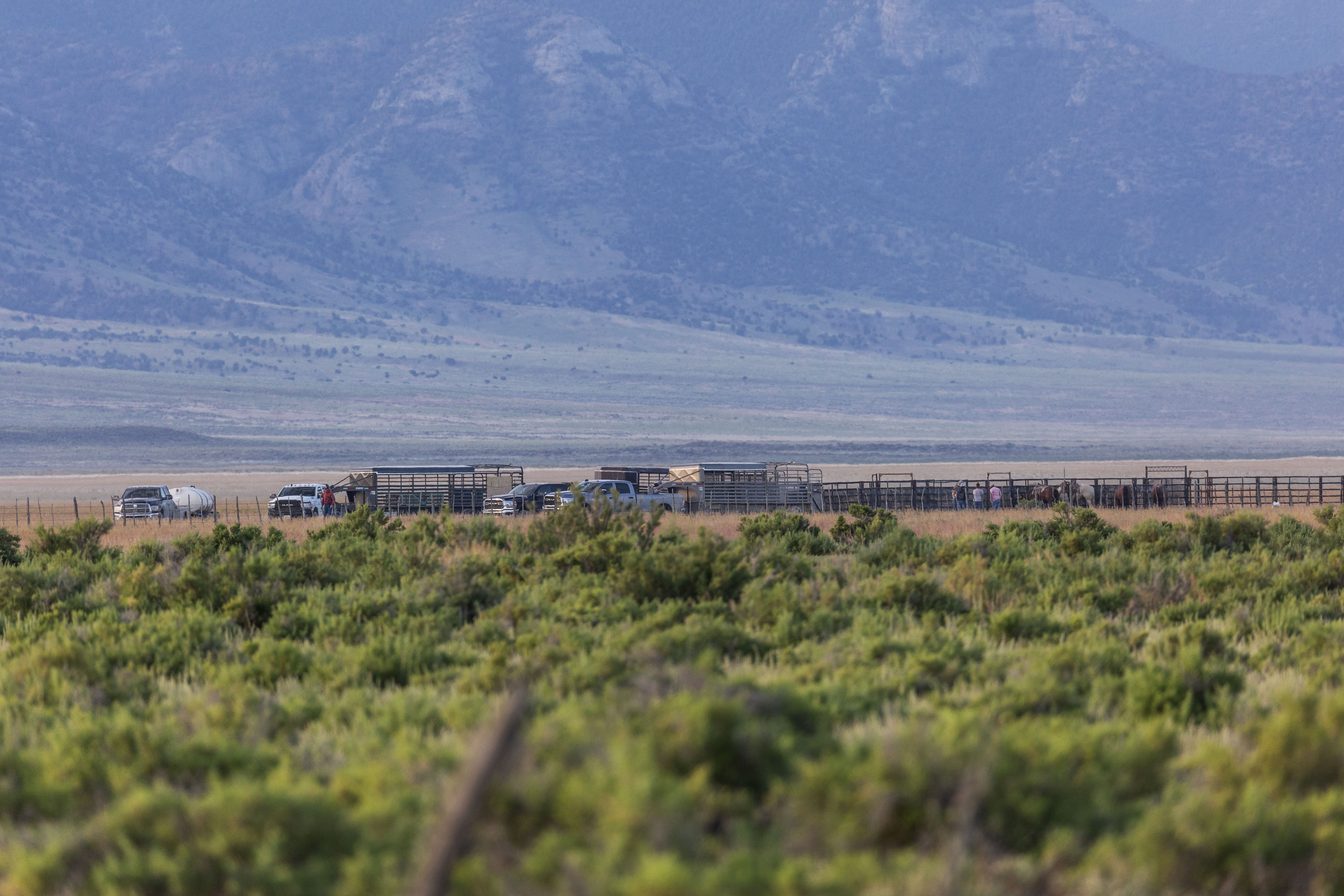
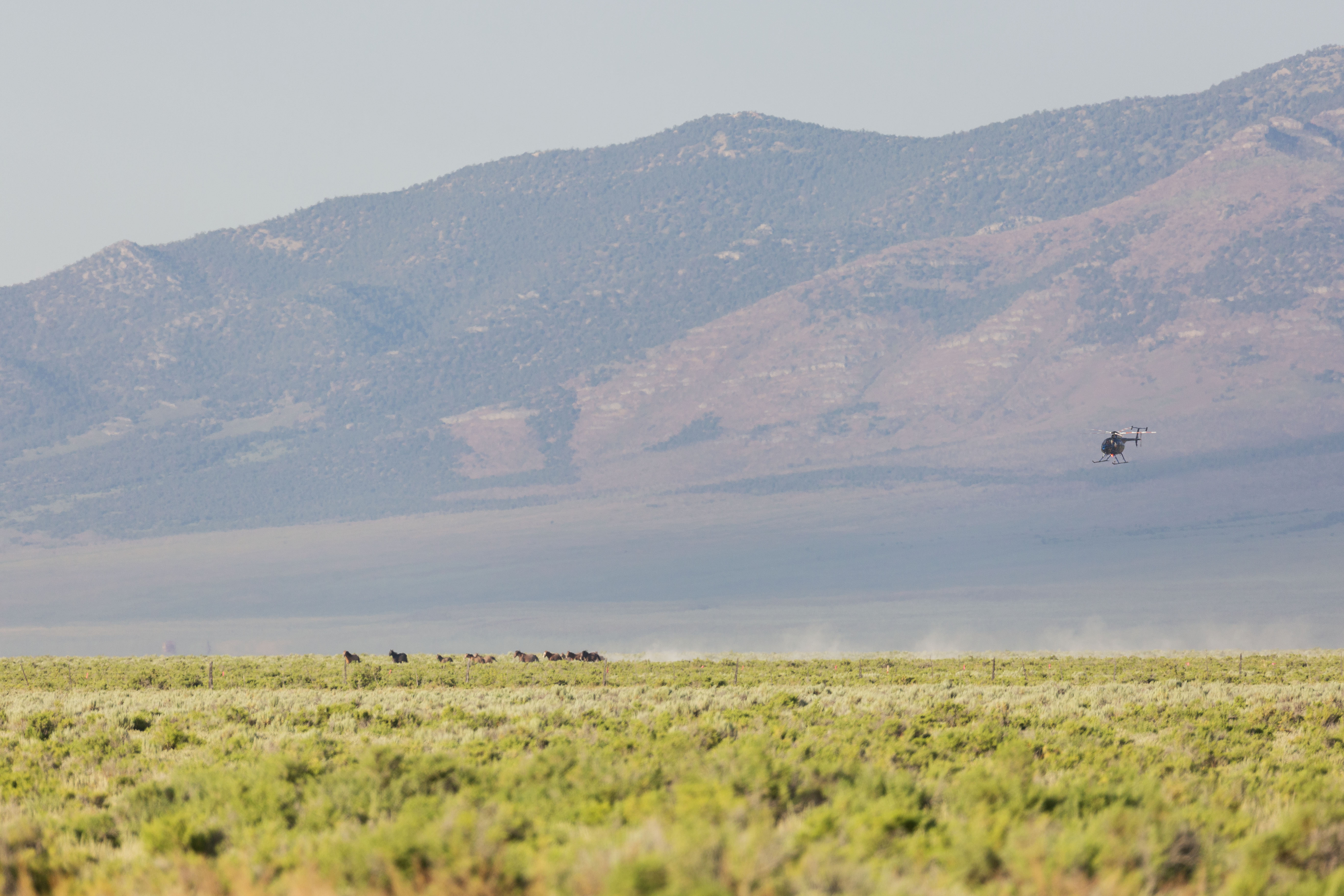
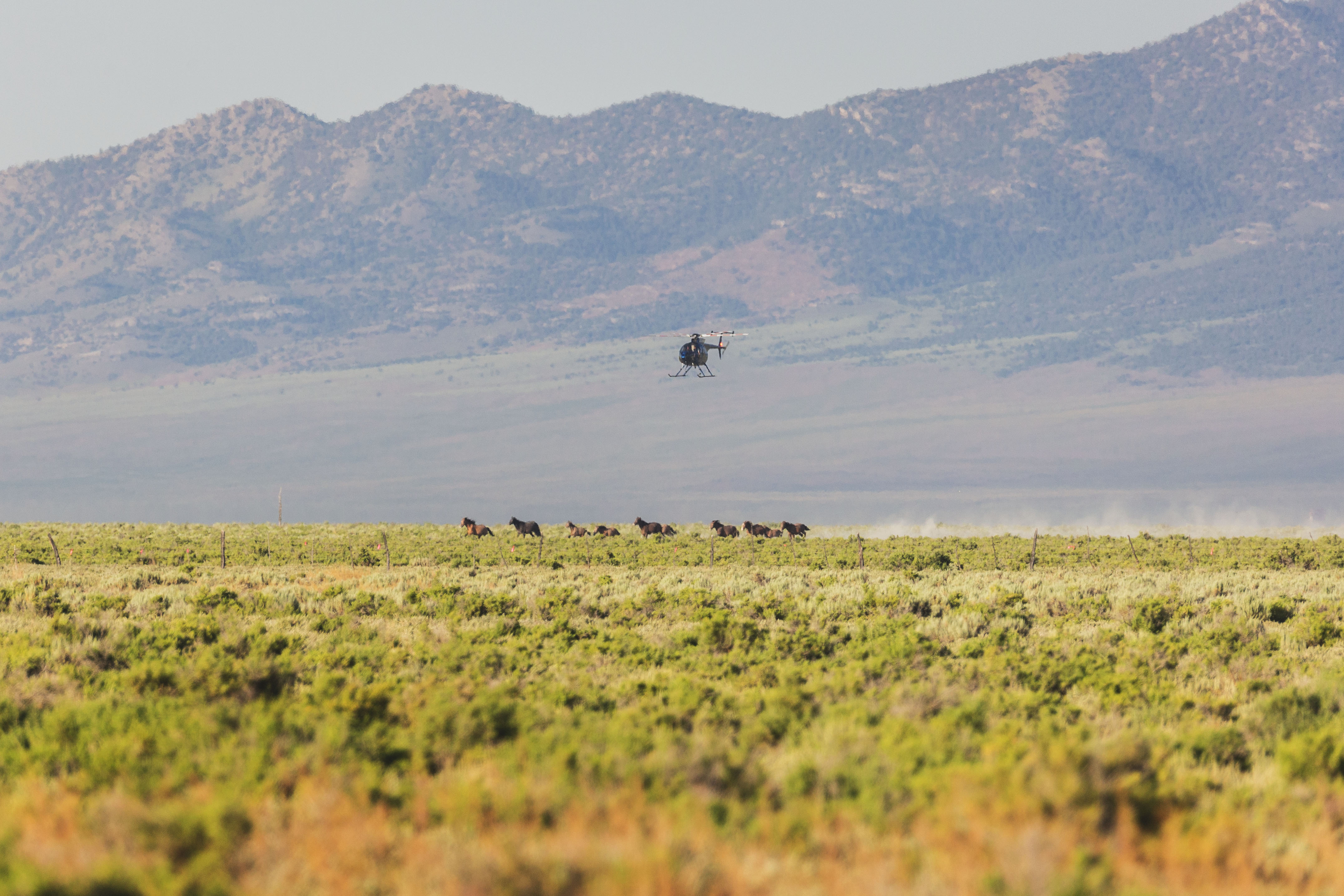
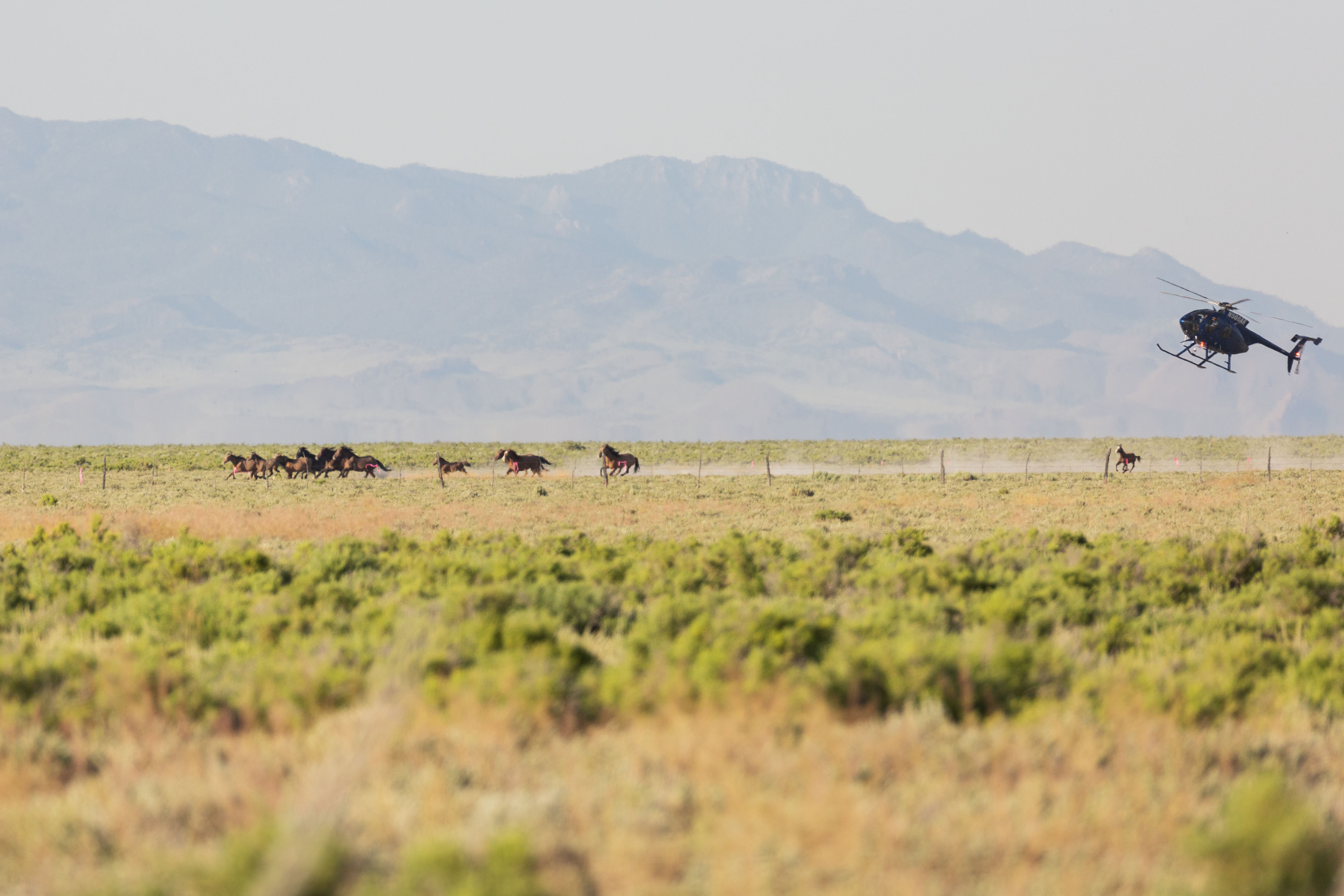


In the second run, which began at 8:56, we noticed a large dust cloud in the distance, indicating the presence of many horses. As the helicopter approached, it became evident that there were over 20 horses in this group, split into two smaller groups. Despite the efforts of the helicopter, a brave mare in the second group managed to avoid capture not just once, but twice. However, she was eventually recaptured during the third run.
Shortly after the third run, which involved a helicopter that was supposed to be operating in the south, the loading process began. Due to the distance to the temporary holding area (approximately 1 hour and 30 minutes away), a big stock trailer was used to transport the horses while the other trailers were emptied. In total, one big stock trailer and a regular trailer were utilized.
During our tour of the trap site, we observed that the perimeter was secured with barbed wire fencing. The jutes were placed a few feet away from the fence, and the remaining sections of the fence were flagged with pink markers to make them visible to the horses. The wings of the trap spanned approximately 0.83 miles.
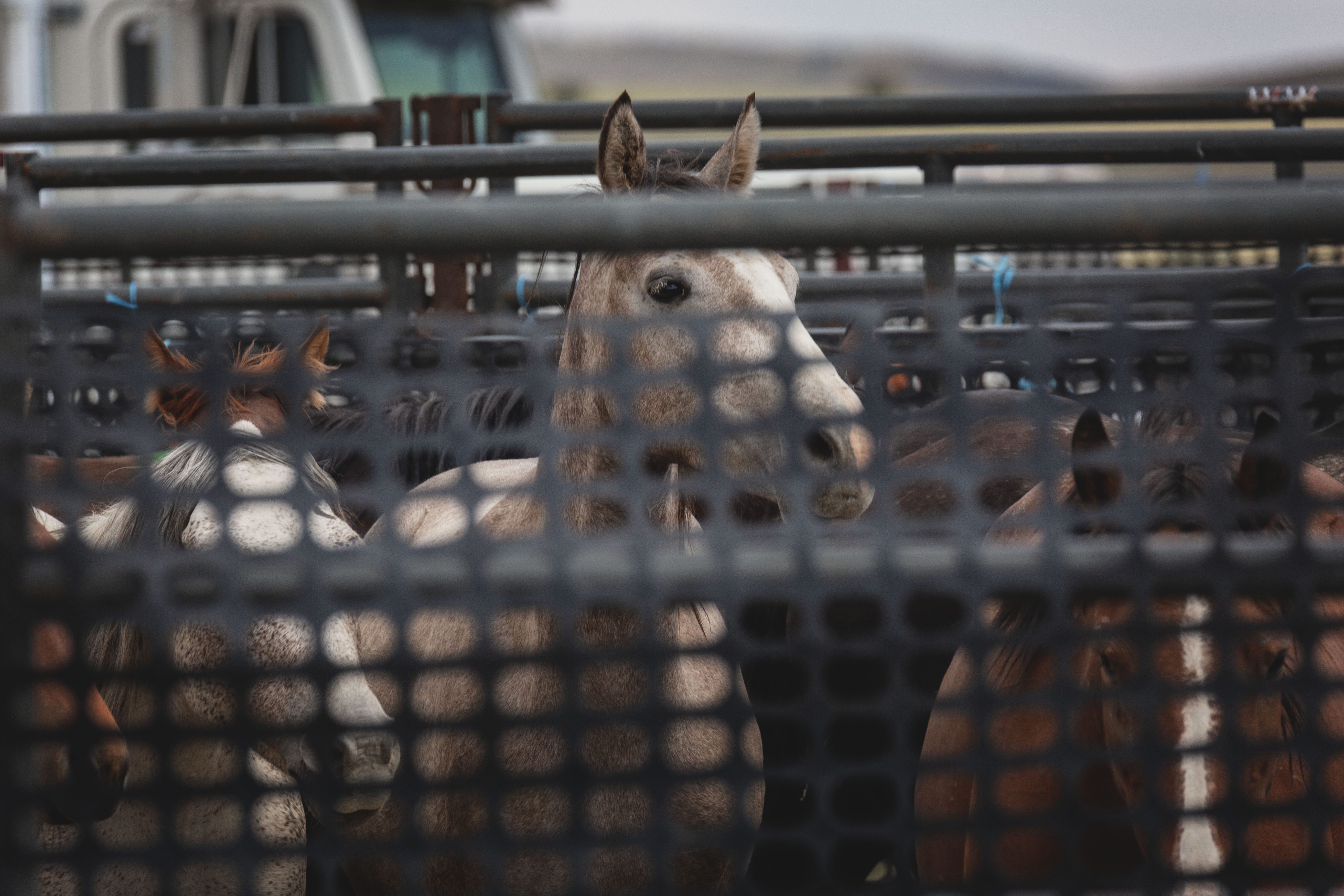
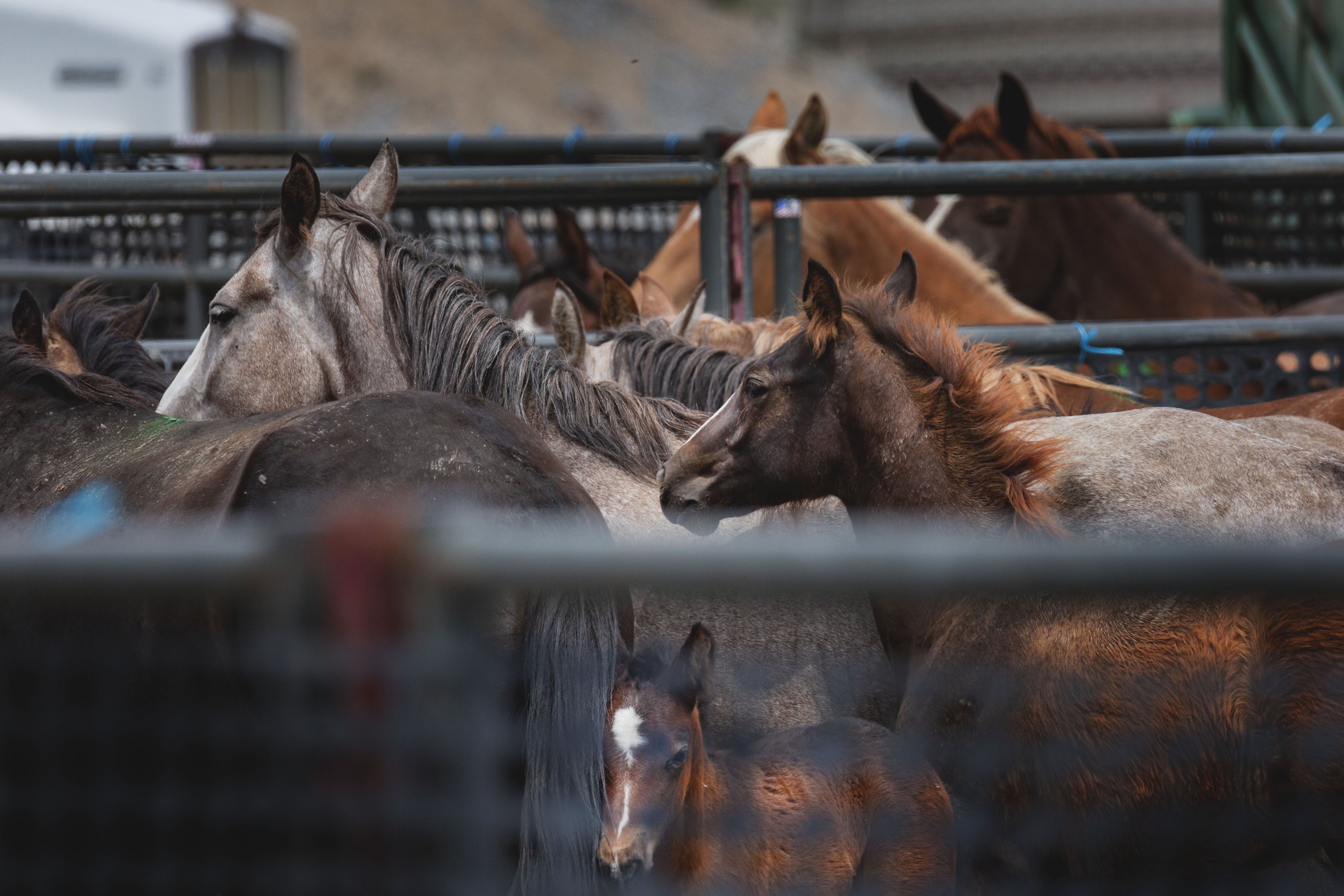 ,P>
,P>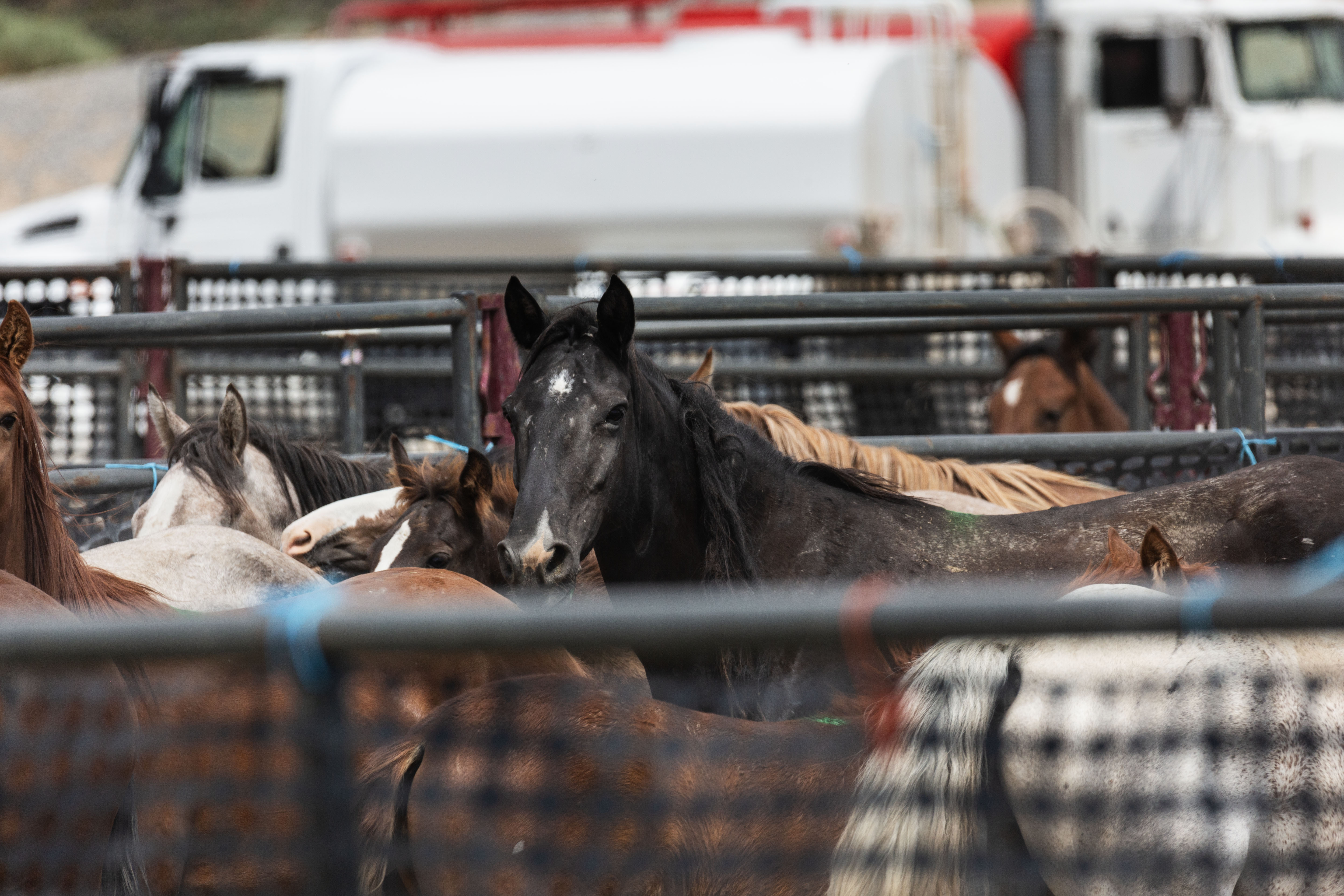
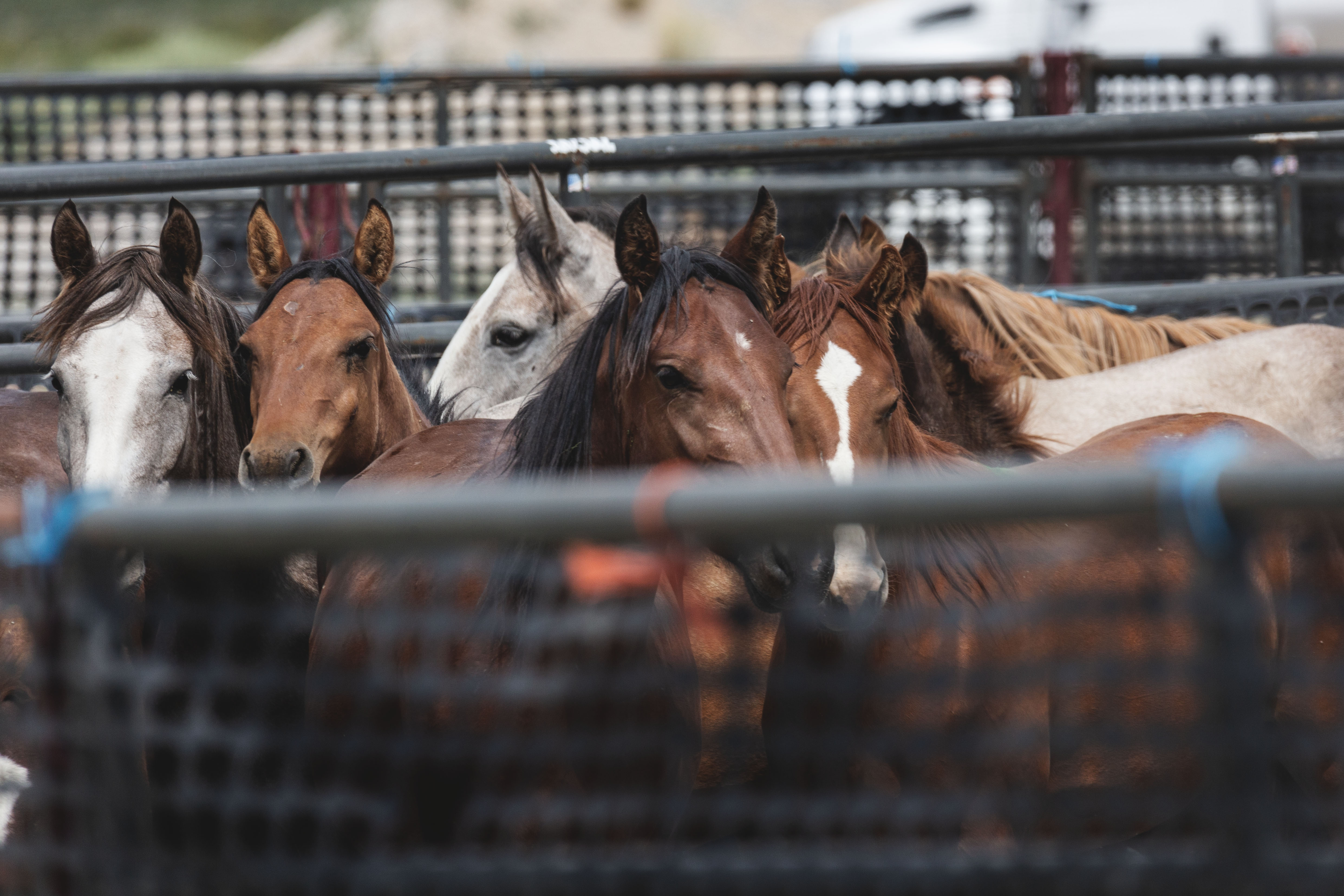
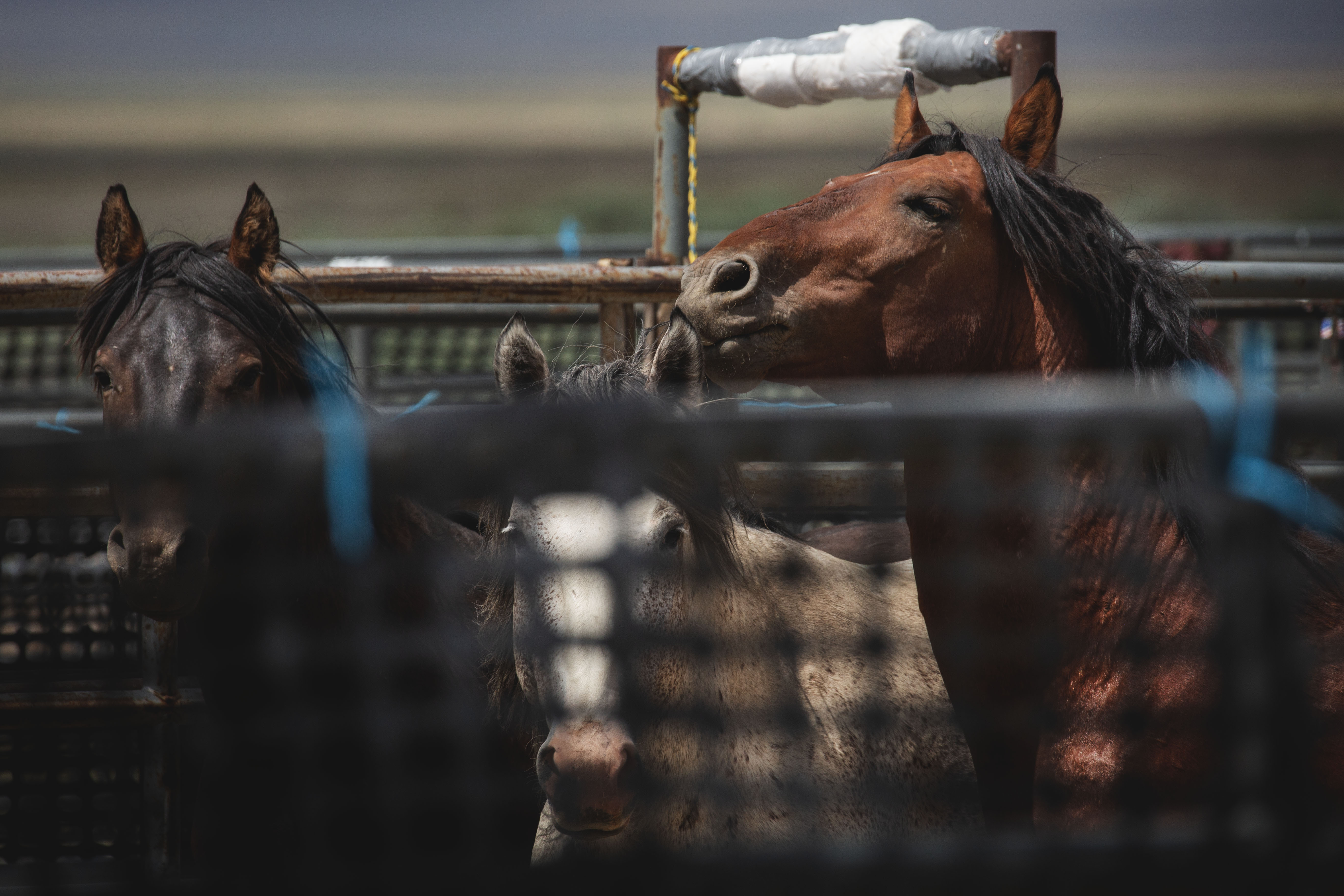
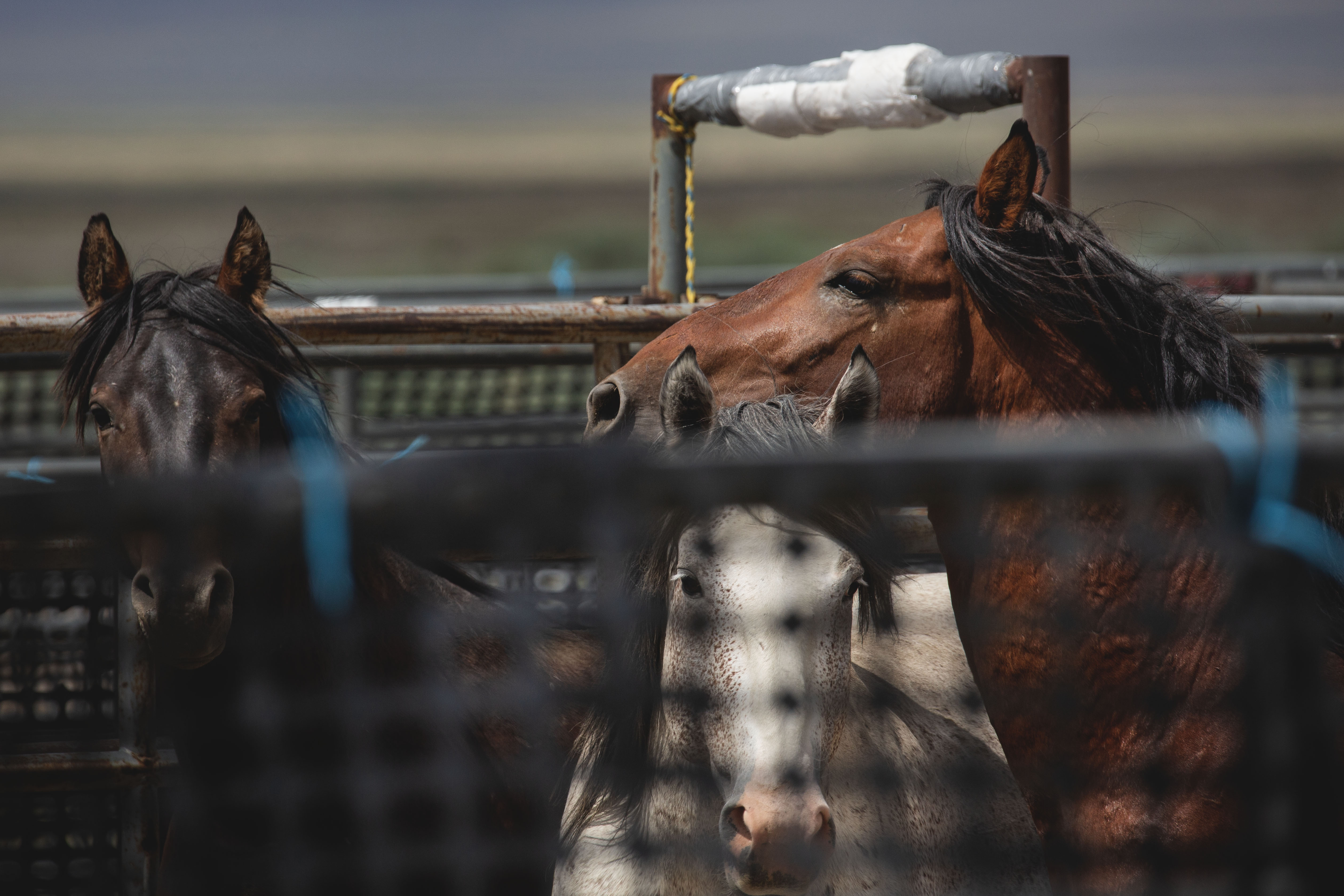
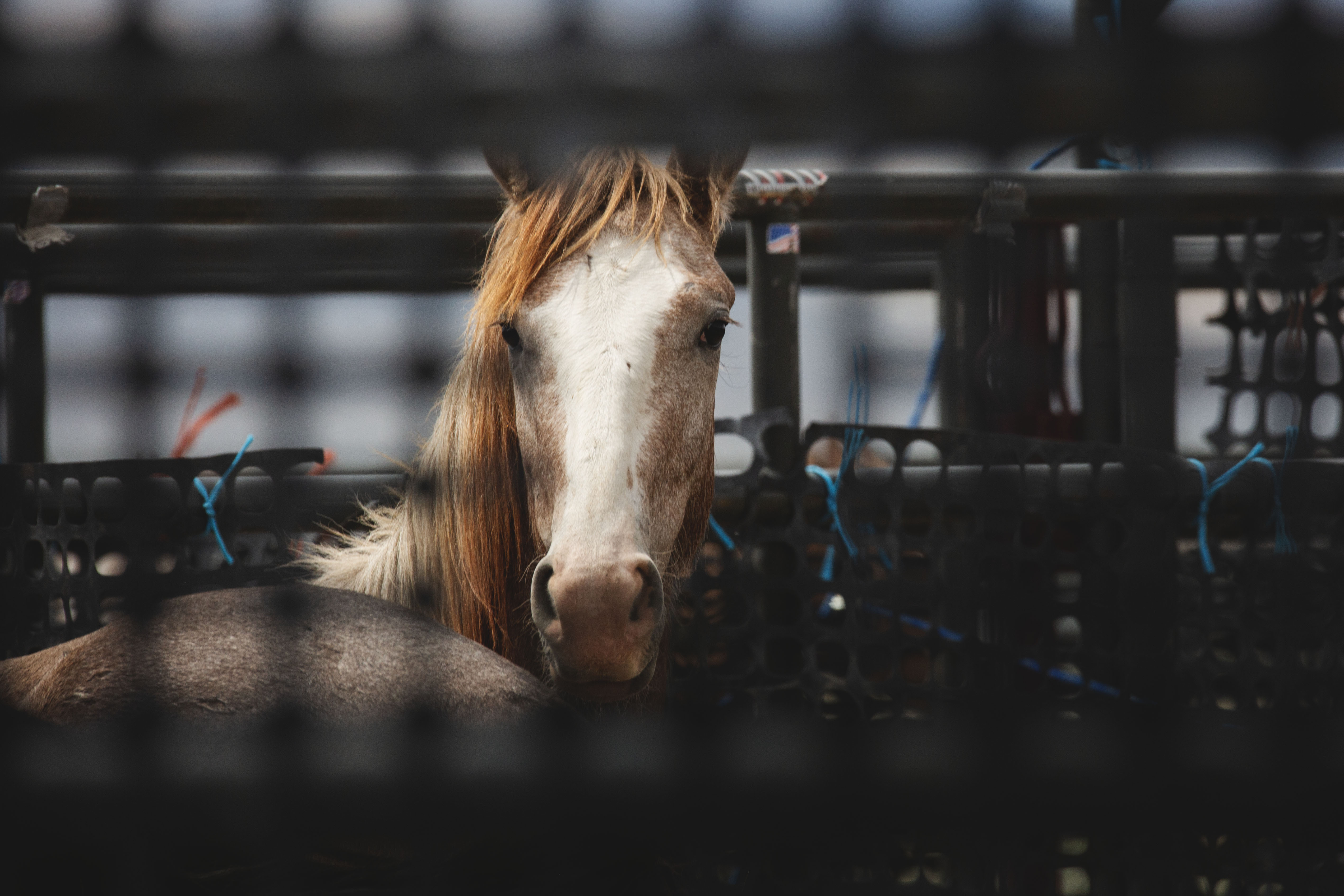
Overall, despite some challenges and the escape of one mare, the capture operation was successful, and the horses were safely transported to the temporary holding area.
July 16, 2023: There was no roundup today due to helicopter maintenance and heat.
22 wild horses captured in Saturday's operation
July 15, 2023: Temperature conditions during the observation period ranged from 57° to 87° Fahrenheit, with sunny weather and a gentle breeze. The body condition scores (BCS) of the wild horses observed ranged from 3 to 4, with a total of 22 horses consisting of 3 stallions, 13 mares, and 6 foals.
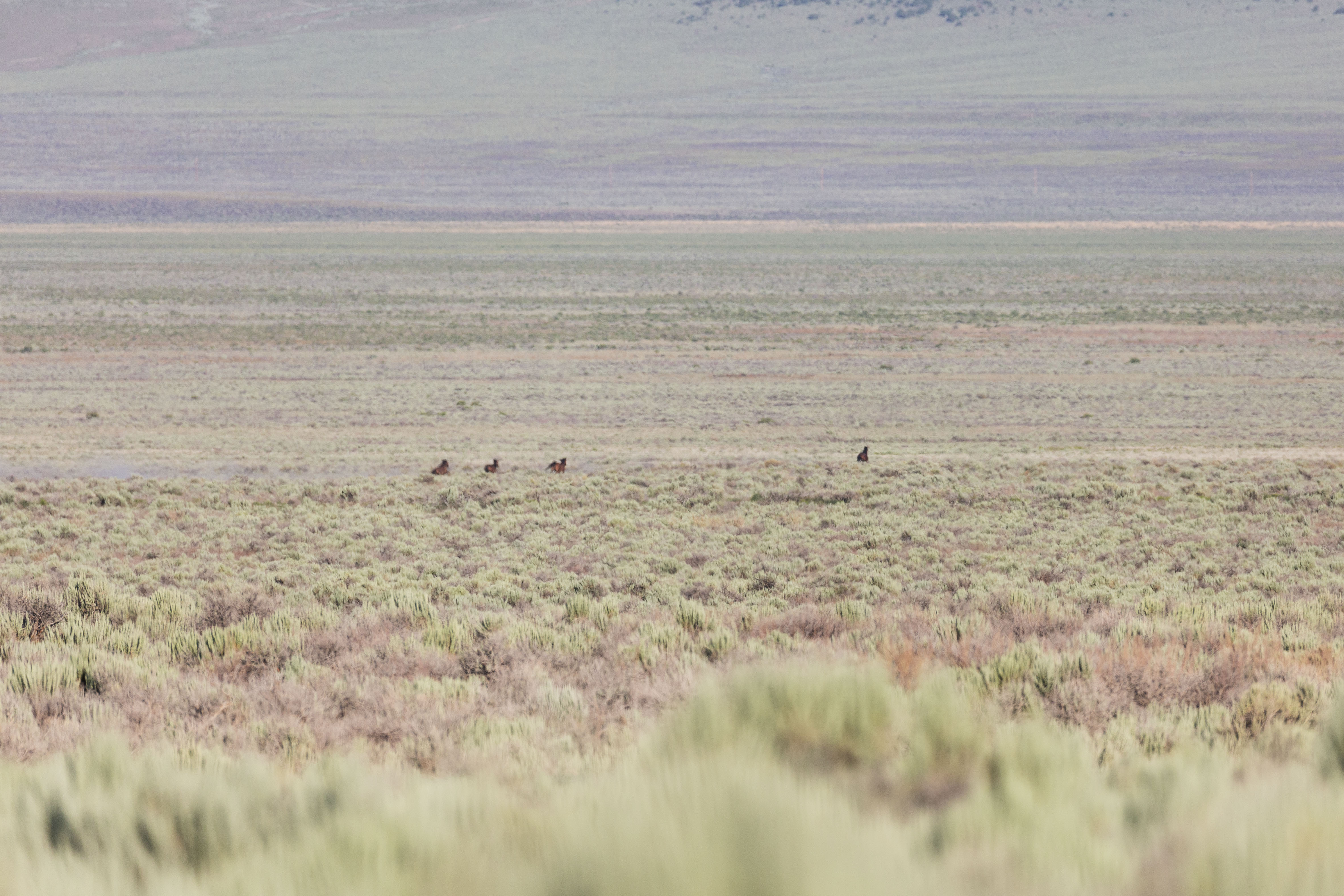
The trap site was relocated to a new location closer to Wells, just off Freeway 80. The designated meet-up time was set for 5 am. Upon arrival at the trap, it was discovered that the trap had been set up on private land. While walking towards the designated observation area, a wrangler hurriedly passed by to pick up flags near the trailers parked on the left side of the road.
Shortly after, it was observed that the helicopter had already located 4 horses and was attempting to drive them closer to the trap. However, these horses were not cooperating. Additionally, a group of 7 horses was spotted straight ahead. When the helicopter failed to gather them together, it decided to push the larger group into the trap, causing the other 4 horses to gallop out of sight.
Due to the vastness of the valley, observation from the observation point, located approximately 0.8 miles away from the trap, was challenging as visibility was limited. Only a portion of the wings was visible, while the trap and trailer for loading were obscured by a hill and sagebrush.
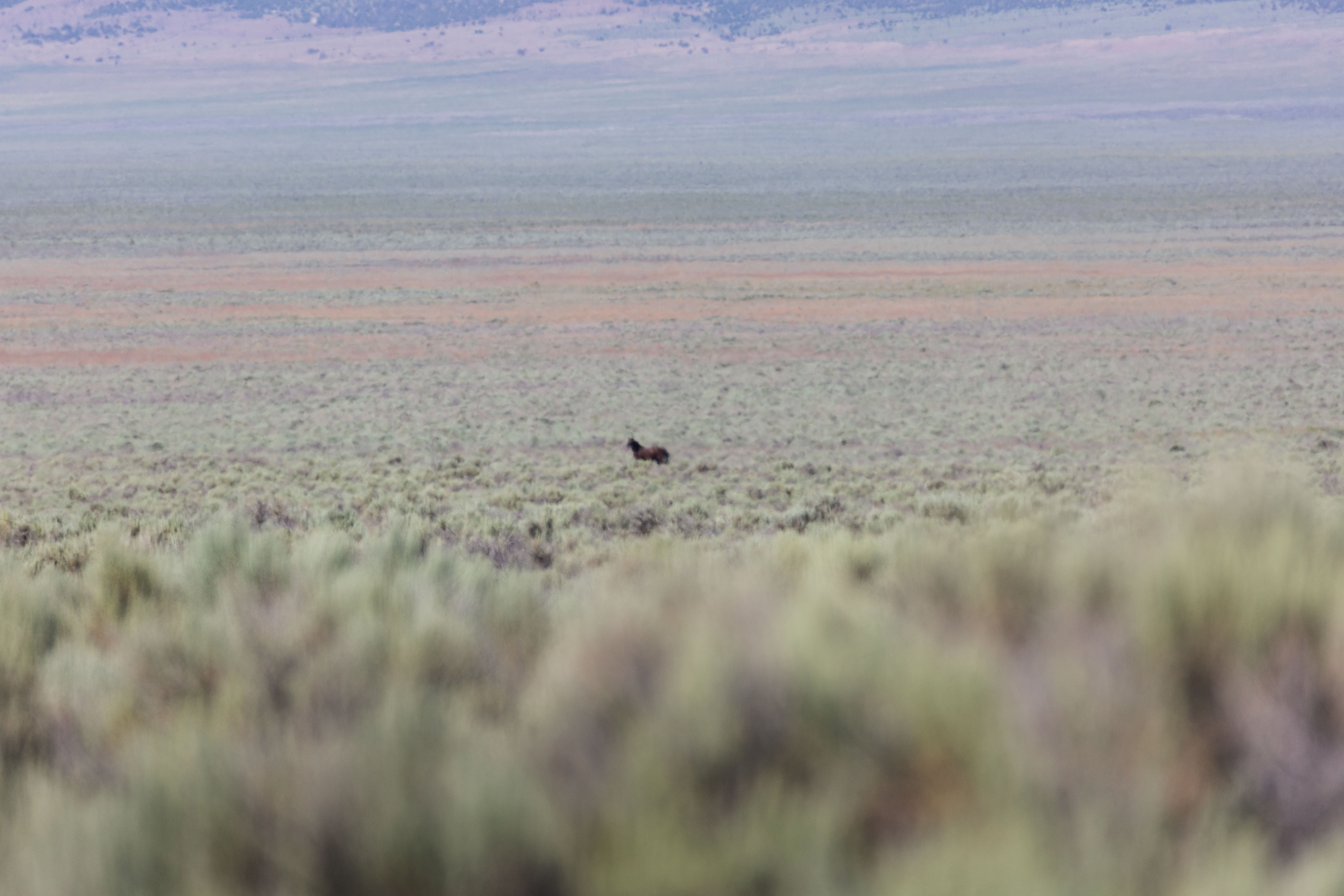
A small group of 3 horses eventually entered the trap, and the first trailer load was sent out at around 7:30 am. The temporary holding area was located an hour and 10 minutes away from the new trap site. At approximately 9 am, another band of approximately 8 horses entered the trap. One horse managed to evade the wings, prompting the helicopter to pursue it briefly before releasing it.
At 9:18 am, the helicopter closed in again. However, the intense heatwaves made observation even more challenging. One horse in particular refused to move into the trap, causing the helicopter to hover and kick up dust for several minutes. The wranglers eventually had to rope the horse with the guidance of the helicopter. After roping her, they remained stationary for a significant amount of time.
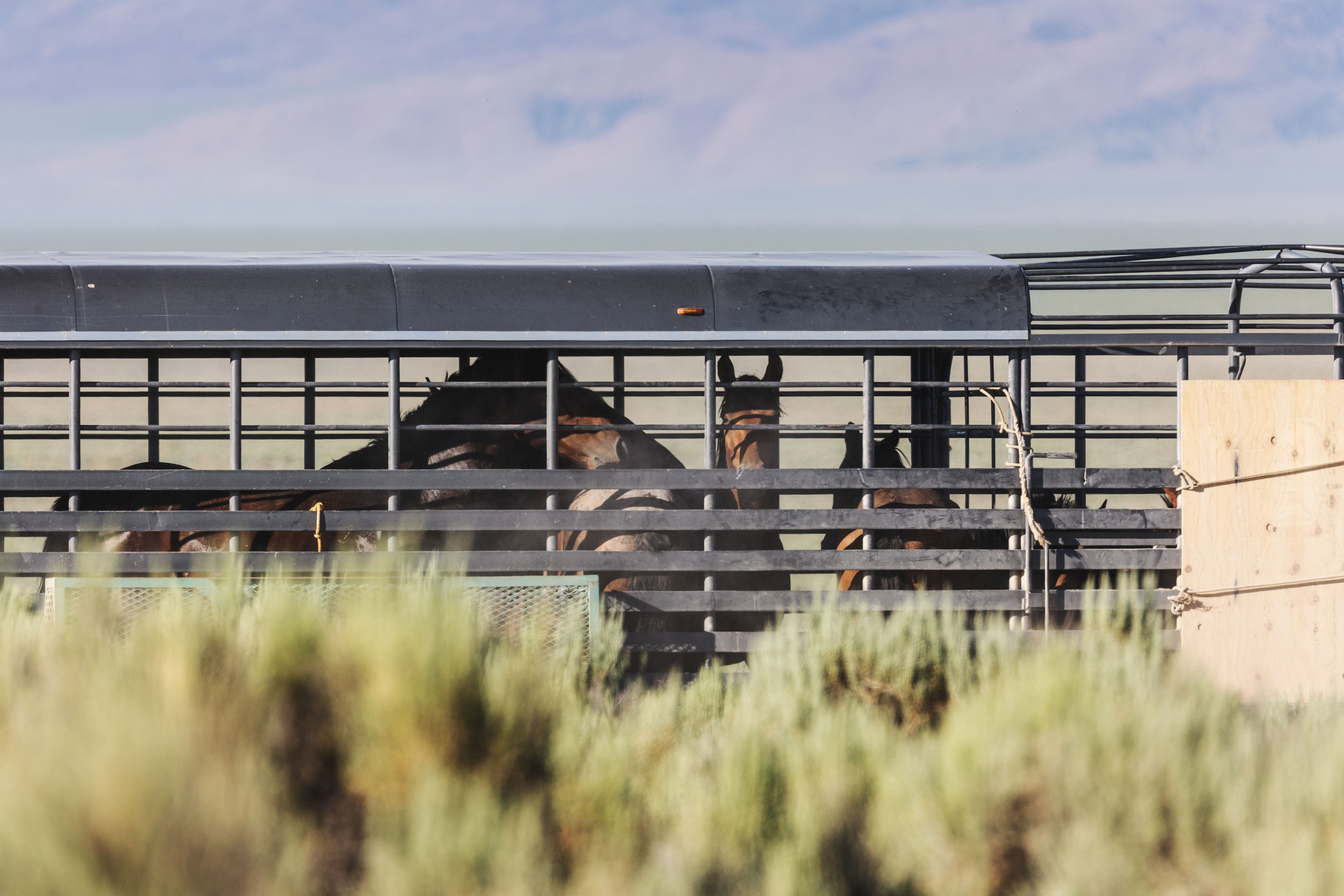
BLM staff members started walking towards the roped mare, who made several attempts to escape but was repeatedly caught. Eventually, a trailer was brought in, and the mare was slowly led closer to it. Meanwhile, around 11 am, another band of horses arrived, although the exact number was difficult to discern.
After approximately 1 hour and 30 minutes, they successfully loaded the mare onto the trailer. It was reported that she appeared weak and had been refusing to take the rope, necessitating the use of a trailer. No additional horses were brought in after that, and the roundup concluded around noon.

While returning to the car, a trailer passed by carrying the roped mare. She appeared to be in okay condition but was noticeably skinny. Operations were scheduled to be halted on Sunday due to maintenance requirements for the helicopter. Maintenance is necessary after a certain number of flying hours, and given the anticipated excessive heat, it was deemed an opportune time for maintenance. As of now, operations are expected to resume on Monday.
25 mustangs lose their freedom, and one dead after July 14 Roundup bringing current total to 227 captured, 4 dead
July 14, 2023: The temperatures ranged from 70°- 83° with sunny and breezy conditions. Later in the day, gusty winds increased.
At 6 am, we arrived at the trap site. In Run 1 at 6:40, a helicopter found horses north of your location. They were moving quickly towards the trap and entered at 6:50. The helicopter then returned north and found 3 more horses.
In Run 2 at 7:08, another small band of horses entered the trap, but one stallion successfully escaped without visible injuries. After this incident, the BLM staff added height to the panels to prevent further escapes.
In Run 3 at 9:34, a band of around 7 horses entered, and in Run 4 at 11:10, a band of 6 horses entered. Once the horses were shipped, we were informed that the roundup for the day was concluded.
We were told the trap site would be moved to a different location. During a tour of the temporary holding, the horses seemed settled, but there were no updates regarding concerns about the upcoming heat wave.
>
We noticed a mare with a blind eye in the photos, who was later euthanized.
49 Wild Horses Captured, 3 Dead at Thursday's Roundup
Weather conditions during the day ranged from the 70s to high 80s, with sunny skies and a nice breeze. Wind gusts increased as the day progressed.
A total of 49 animals were rounded up, including 16 stallions, 25 mares, and 8 foals. Additionally, 77 animals were shipped, consisting of 38 stallions, 30 mares, and 9 foals.
The day started with a meet time at a gas station in Wells at 4:45 am. We arrived at the trap site, which was the same location as the previous day, at 6 am. The helicopter was already in the air but had not captured any horses yet.
The first run occurred at 7:20 am when a band of 9 horses approached from the south and entered the trap at 7:25 am. Two hours later, the helicopter closed in with the second band.
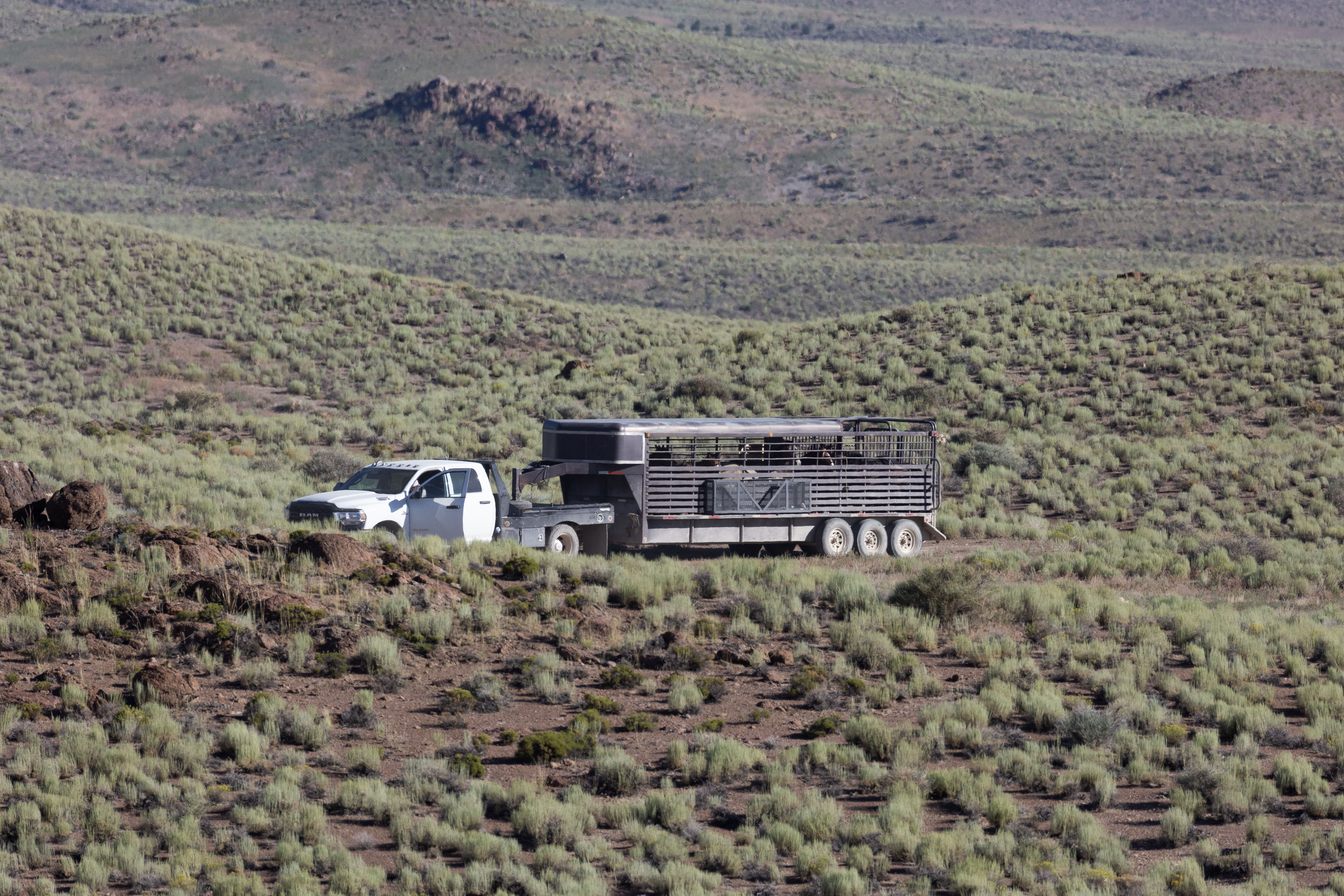
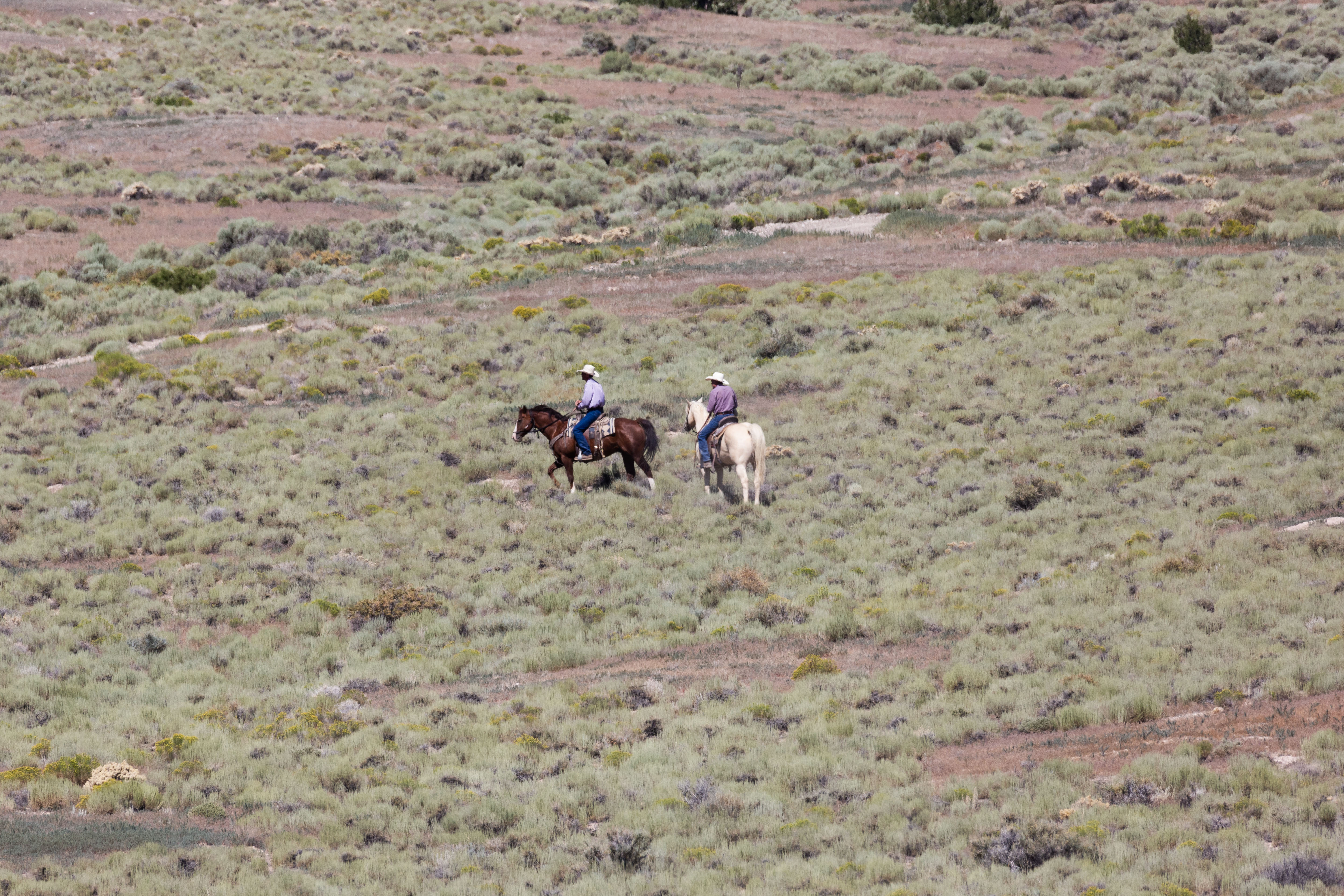
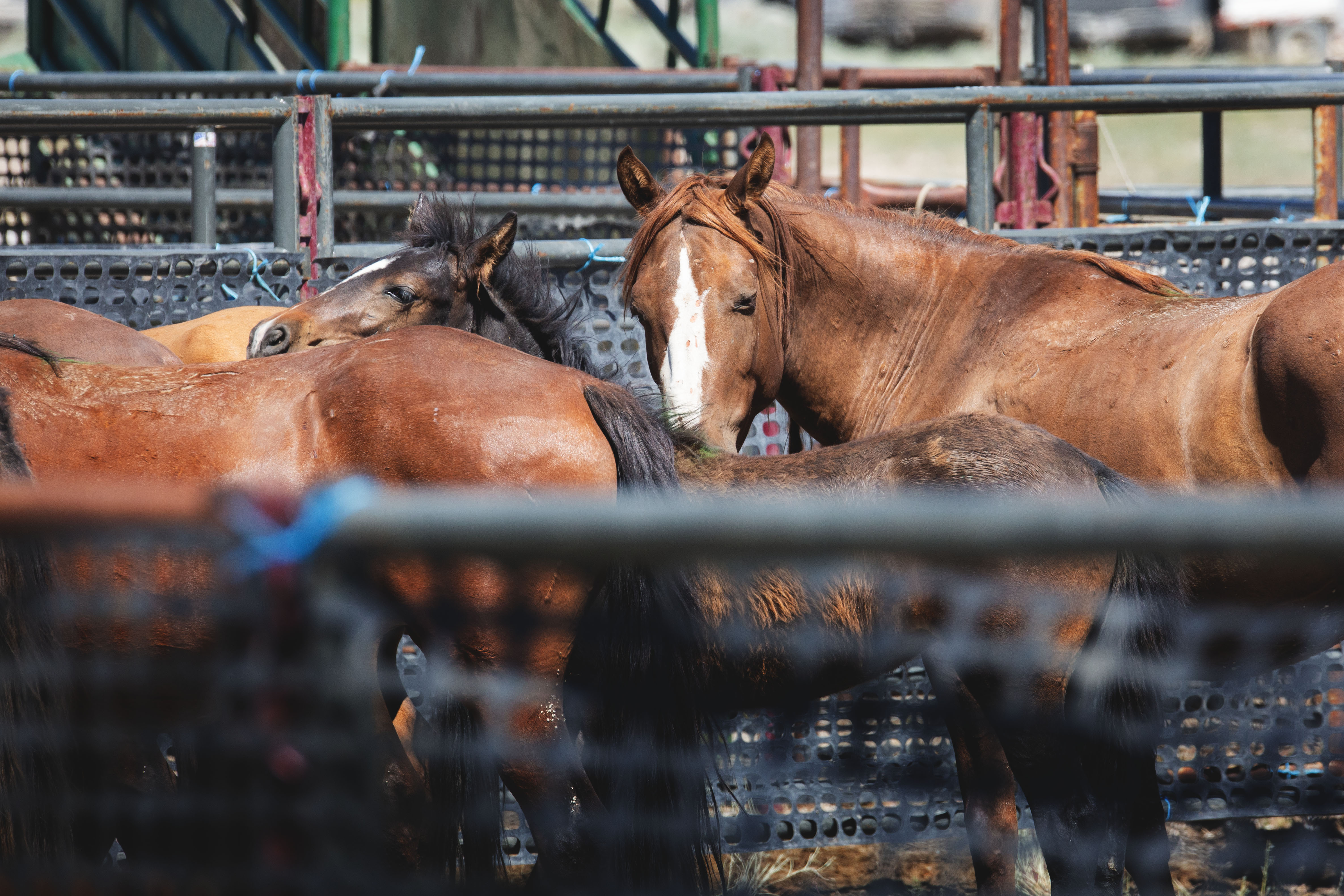
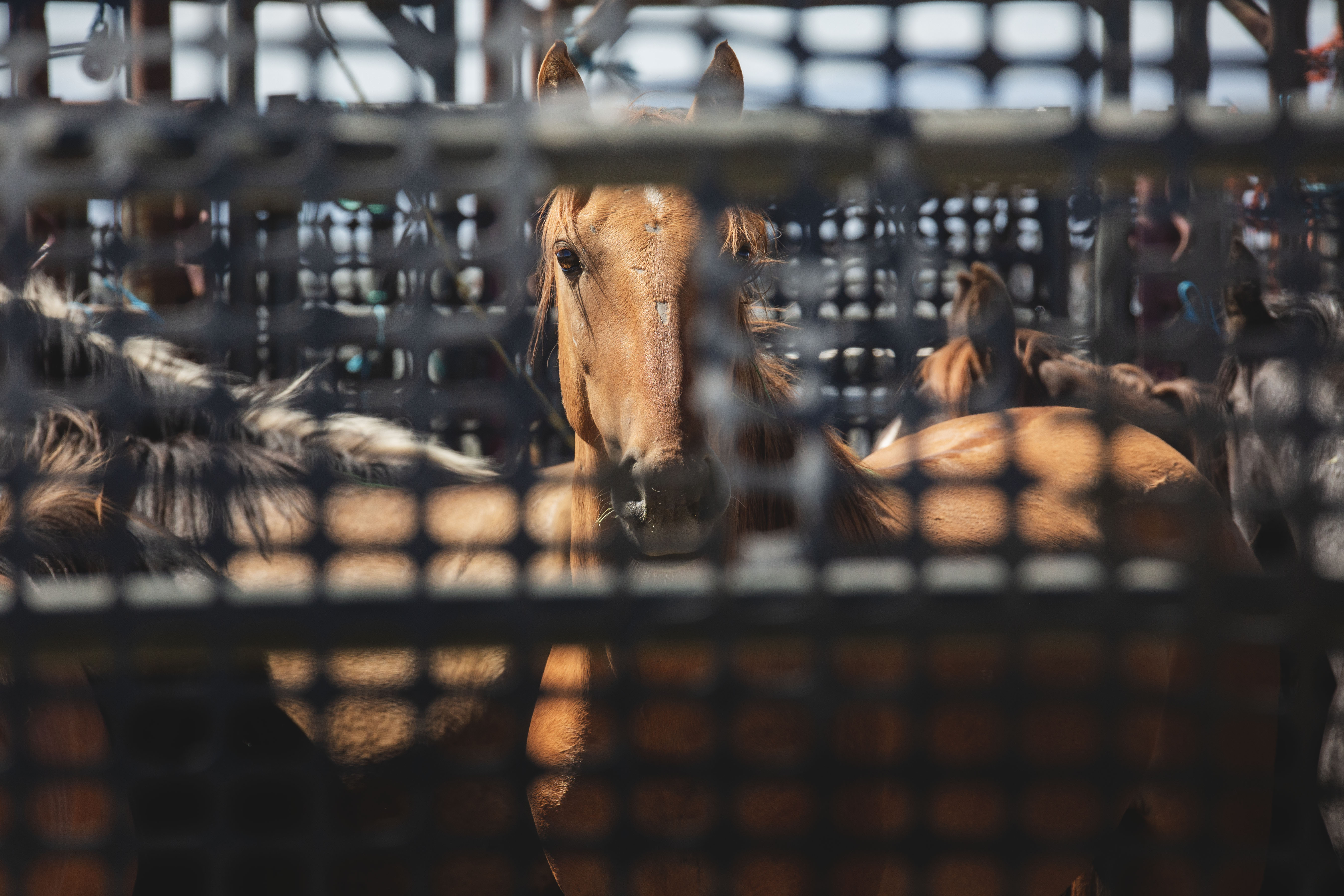



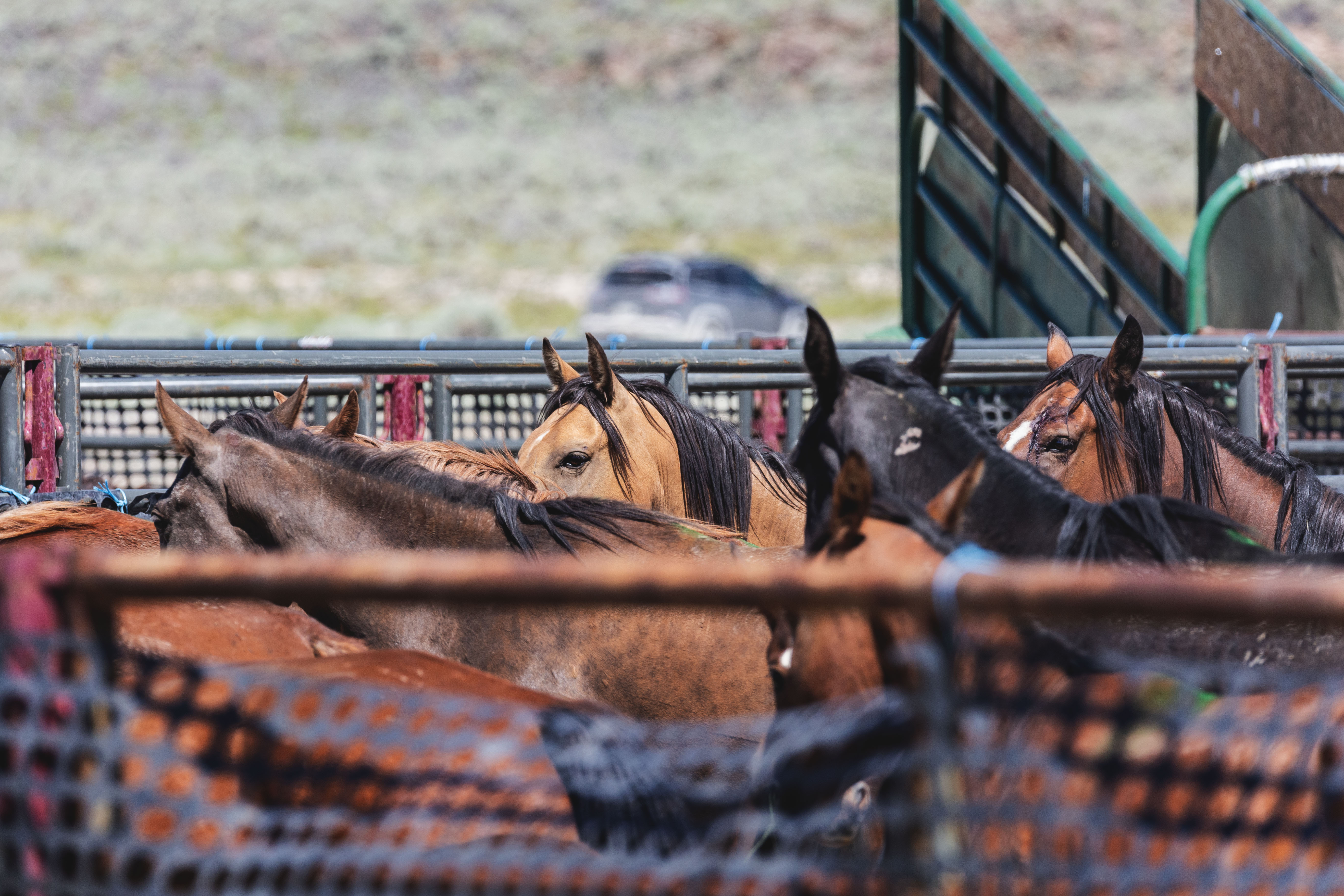
At 9:30 am, a band of approximately 15 horses was spotted coming from the south. They entered the trap at 9:36 am. During this run, a palomino stallion tried to escape by jumping over the fence but injured himself in the process. Despite the injury, the stallion continued running on three legs.
Efforts were made to rope and capture the injured stallion, but after about 35 minutes, it was determined that euthanasia was necessary. The stallion was brought back to temporary holding for further examination and burial.
Two more runs occurred throughout the day, with a group of 15 horses entering the trap at 11:10 am and three additional horses, including a foal, at 11:50 am. The foal had to be roped as it got separated at the wings/trap site.
The day concluded with temperatures measuring in the low 70s to 87.5 degrees Fahrenheit at the trap at noon. A total of three deaths were reported, two of which were acute and one the BLM says, was pre-existing. One foal died due to roundup-related colic, and a bay filly succumbed to a severe infection caused by lameness.
82 wild horses lose their freedom on Day 4 of roundup operation
July 12, 2023: The operation took place in West Wendover, with observations made at a new trap site located approximately 10 miles north of the previous one.
During the operation, temperatures ranged from the 70s to the mid-80s. However, it is important to note that a heat wave is expected this weekend, with temperatures forecasted to exceed 100º. Sunday is anticipated to be the hottest day, with temperatures nearing record highs.
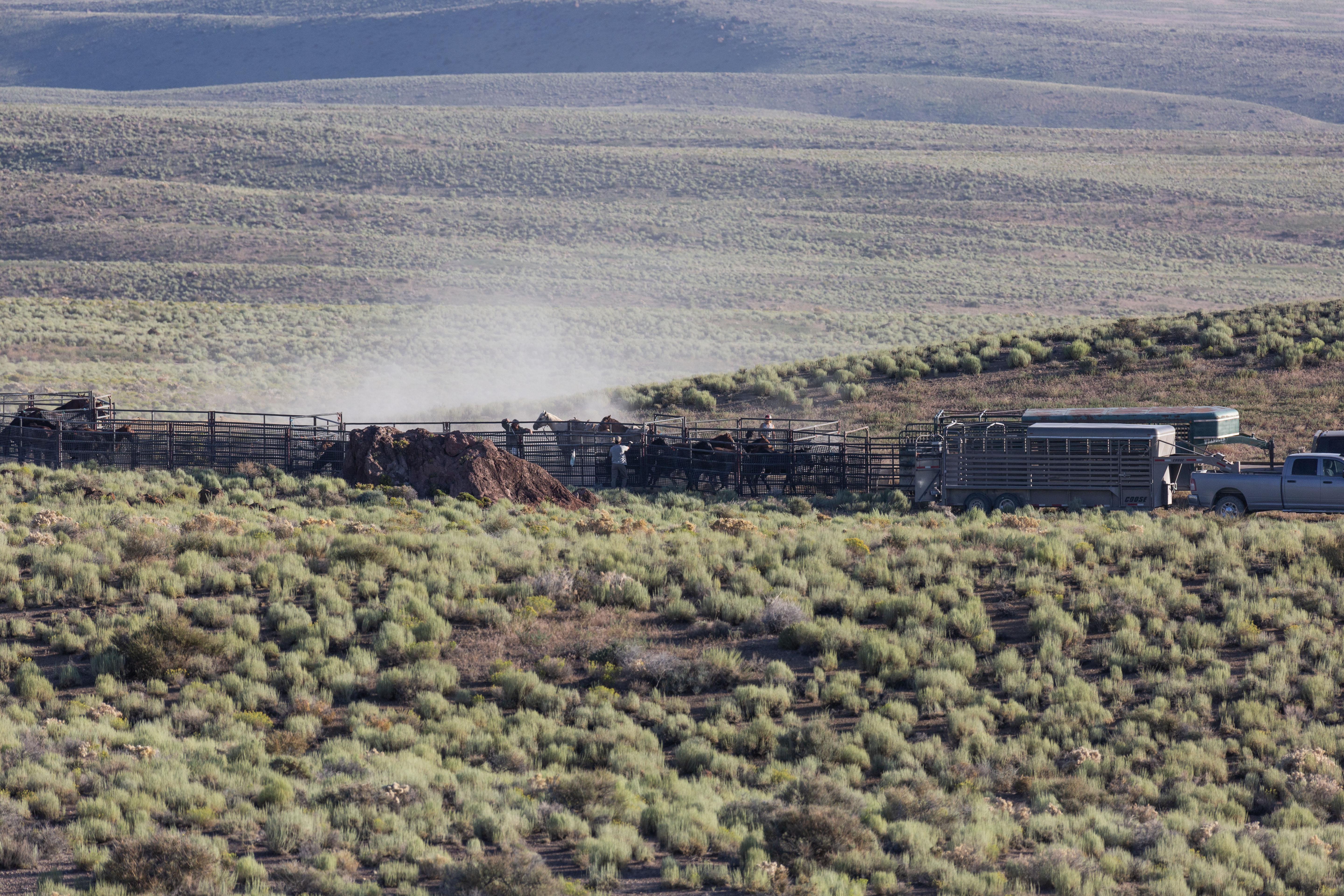


Several runs were conducted, with horses being guided into traps for temporary holding. Notable observations include:
- Run 1: A band of approximately 10 horses, including a small foal, was successfully loaded and transported to temporary holding.
- Run 2: A group of 15 horses came from the mountains to the west and entered the trap.
- Run 3: Another band, guided by two helicopters, was successfully maneuvered into the trap.
- Run 4: A band of around 10 horses from the south entered the trap. A protective mare with her foal displayed aggressive behavior towards other horses.
- Run 5: A large group of 19 horses entered the trap.

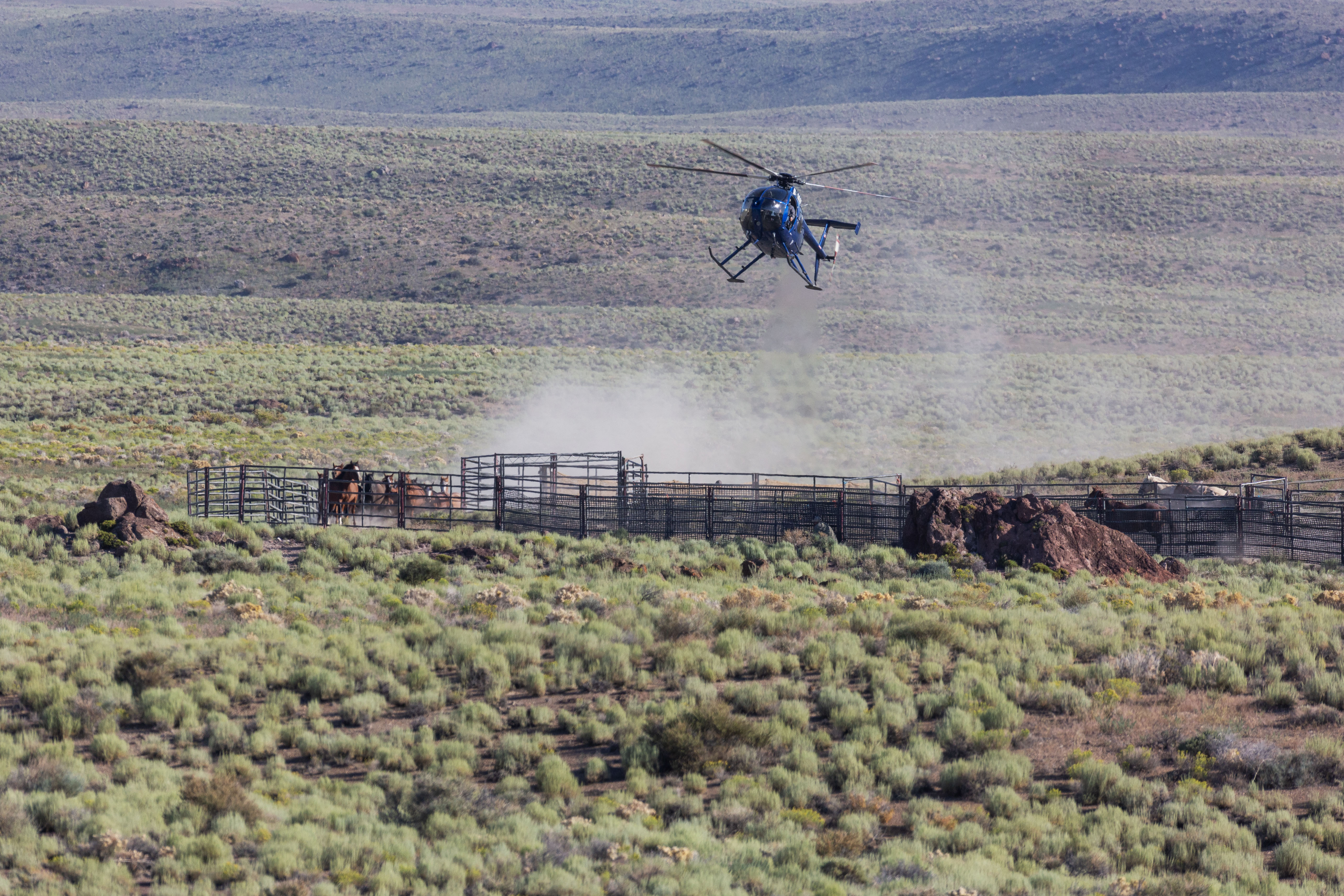
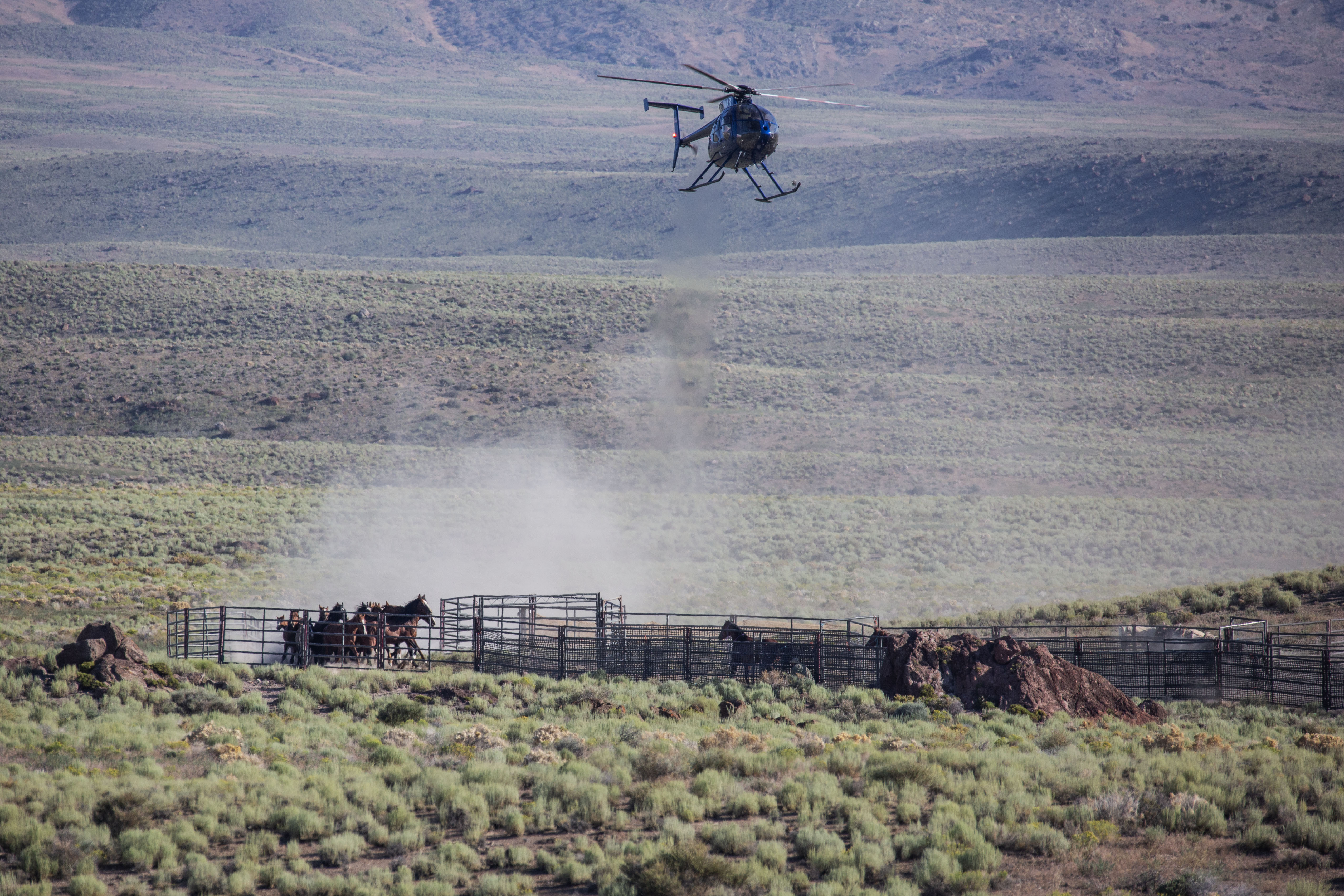
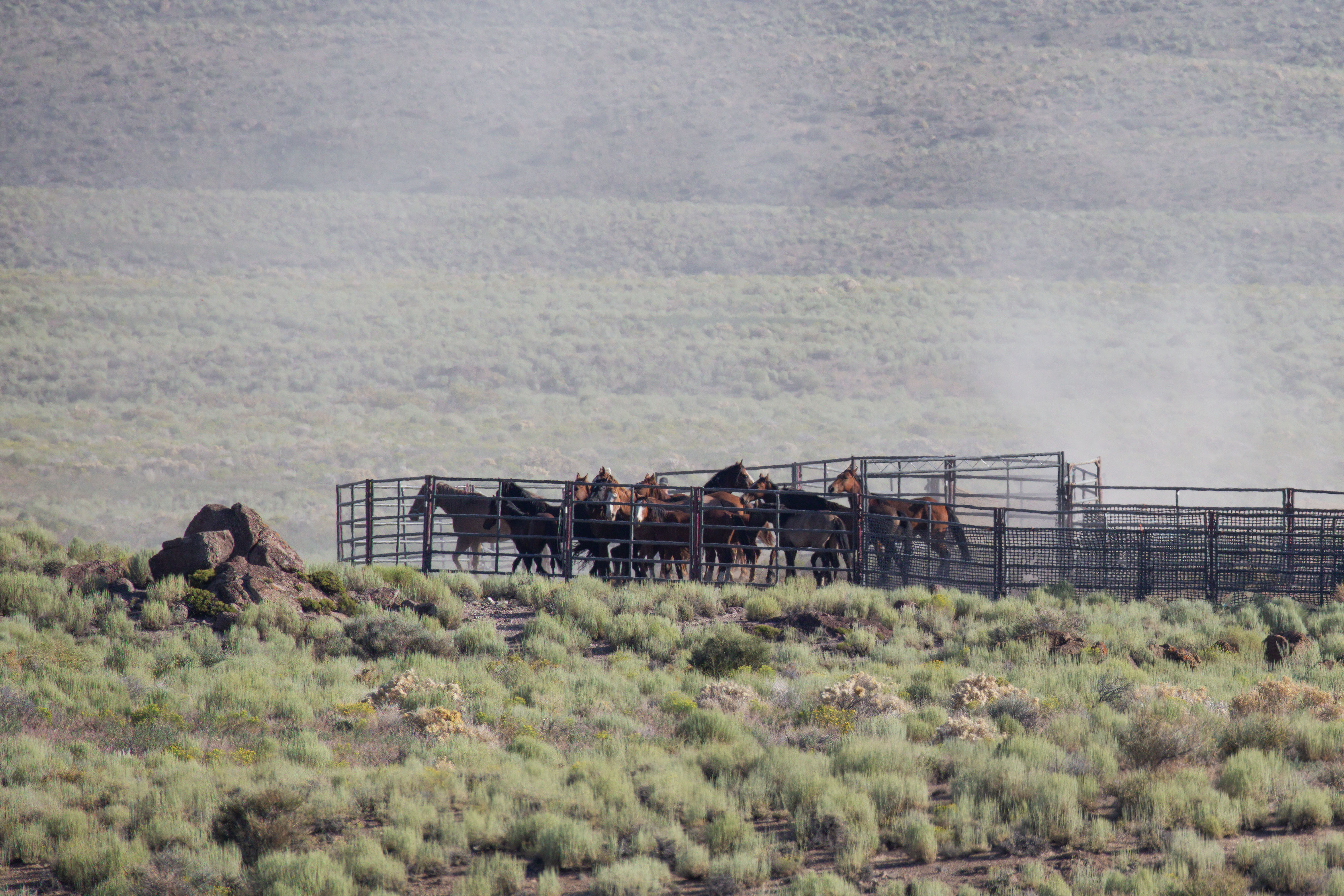

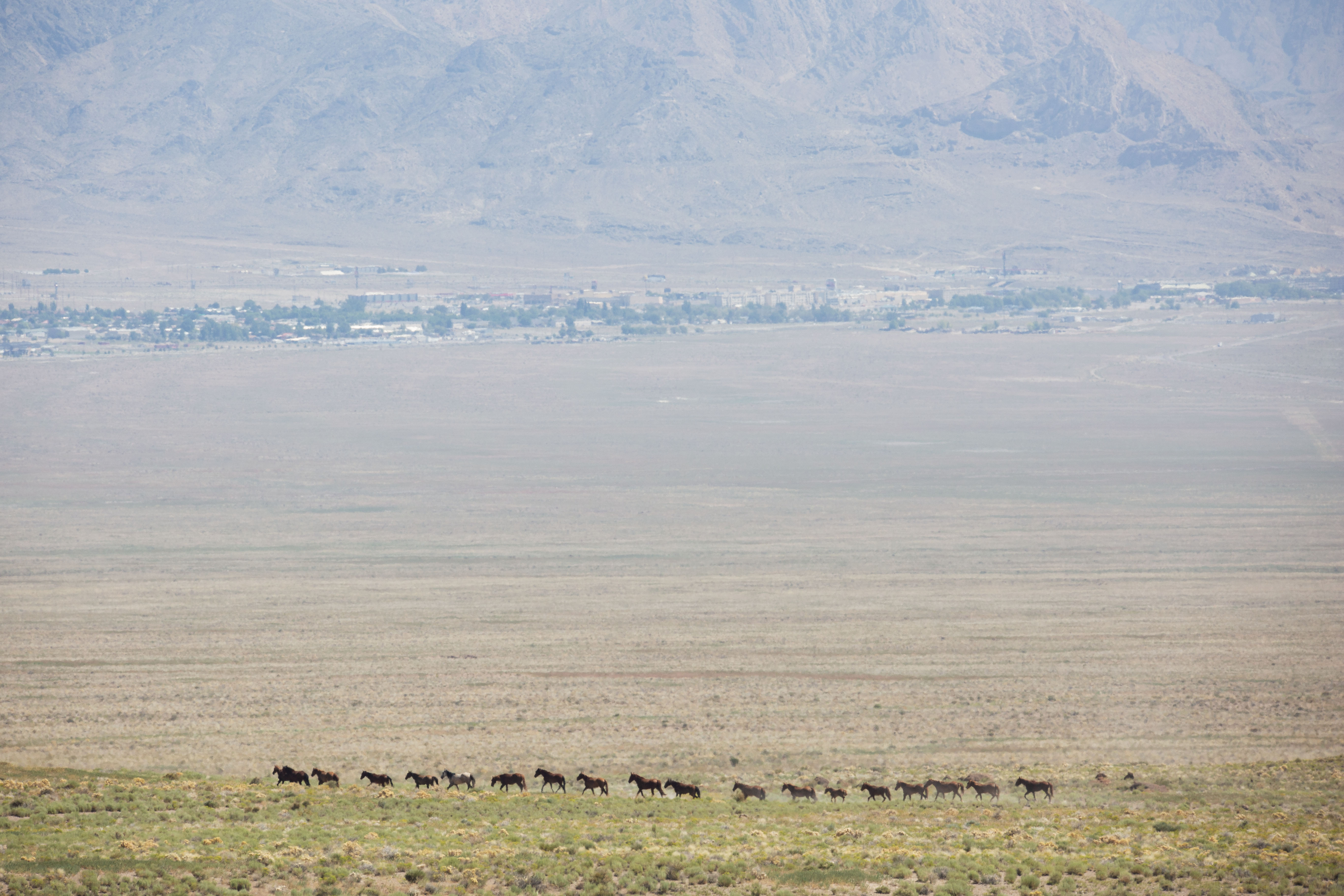
The operation concluded earlier than expected, raising questions among observers. Although no clear reason was provided, it is speculated that the trailers used for transportation were located a distance away, causing delays in loading. At temporary holding, a BLM official went on to explain that the operation ended early to give the horses time to come back into the area as they were very spread out.
Concerns were raised regarding the upcoming heat wave and the potential impact on the horses. A BLM representative mentioned that more horses were still in the mountains and that the heat was a concern.
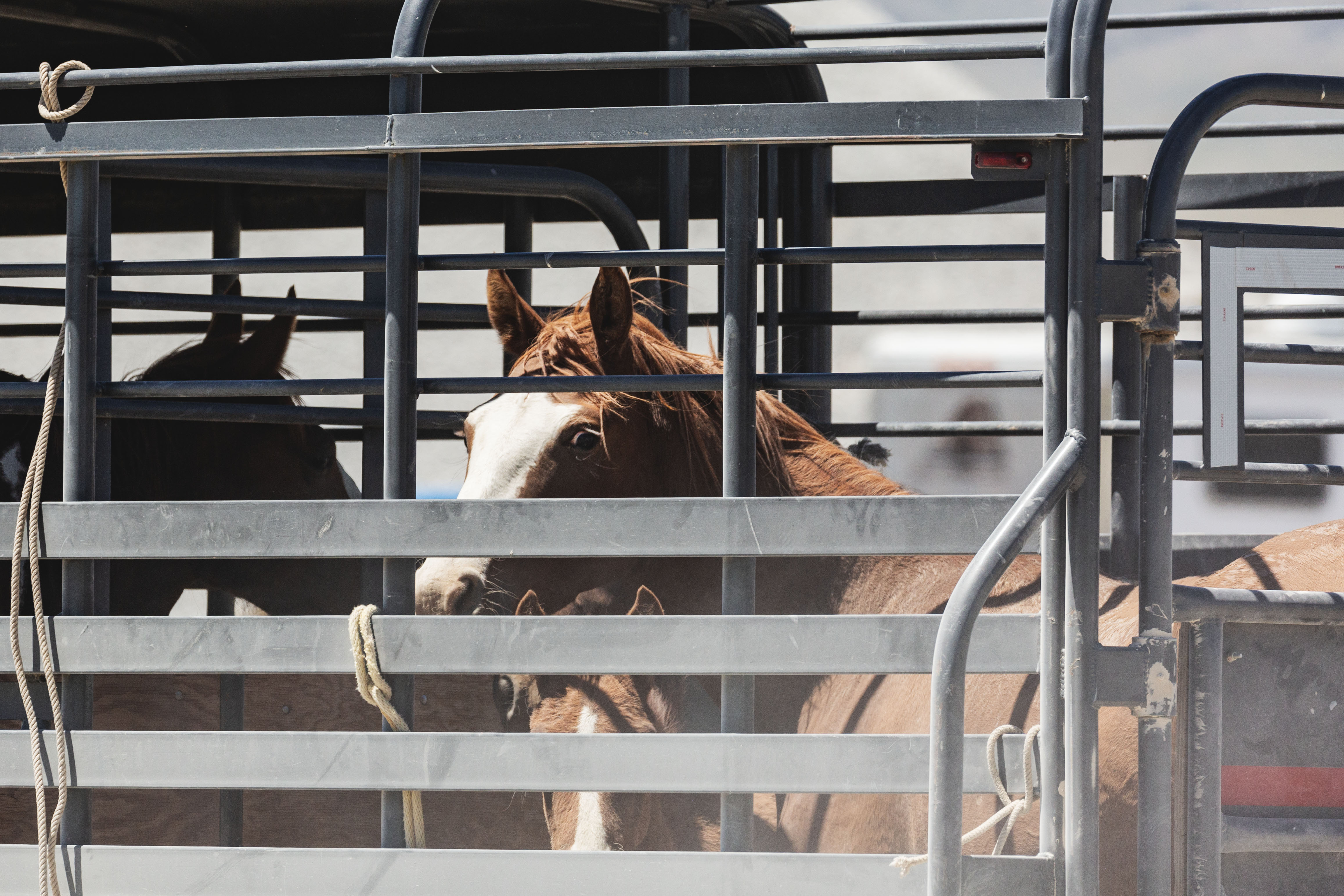
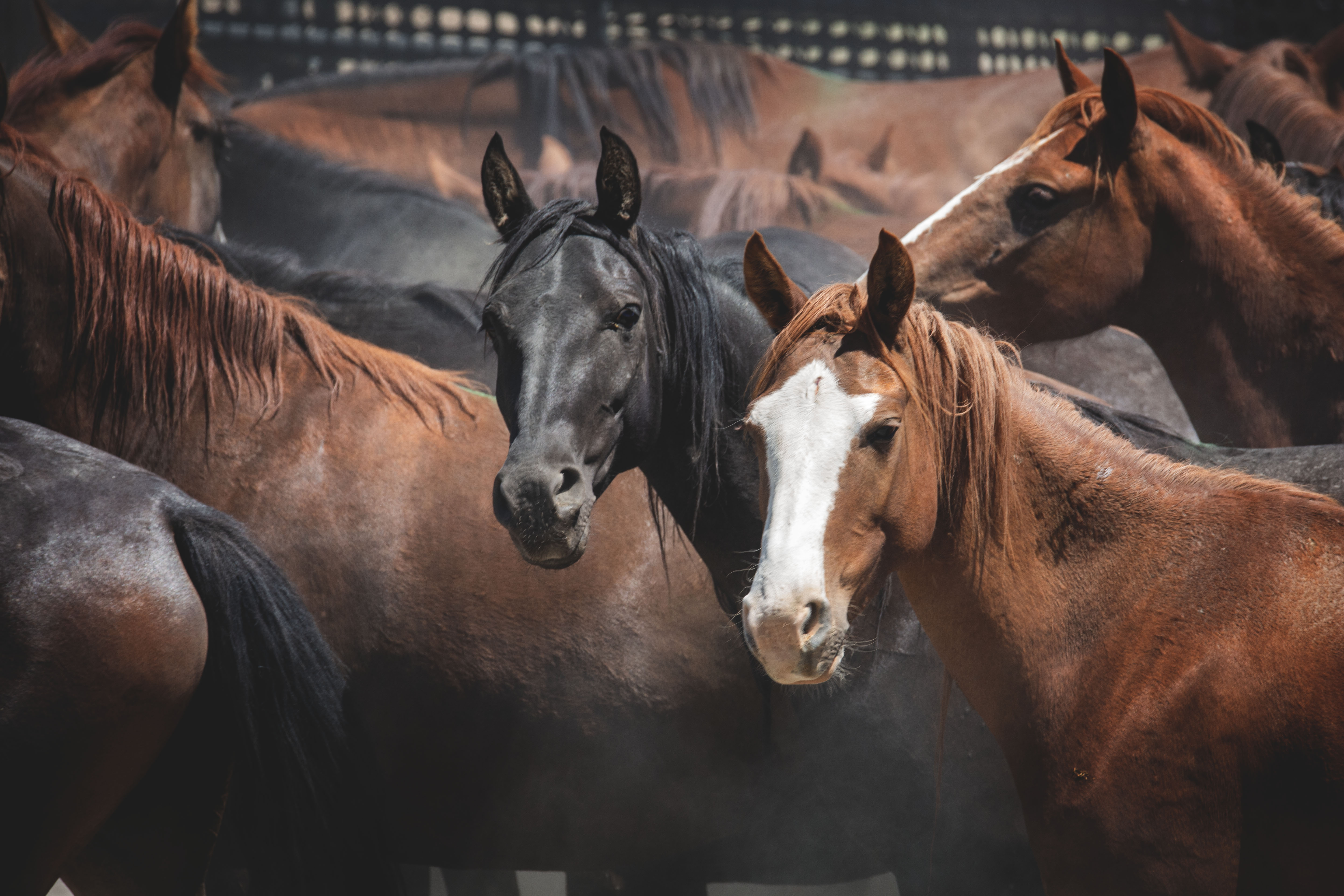
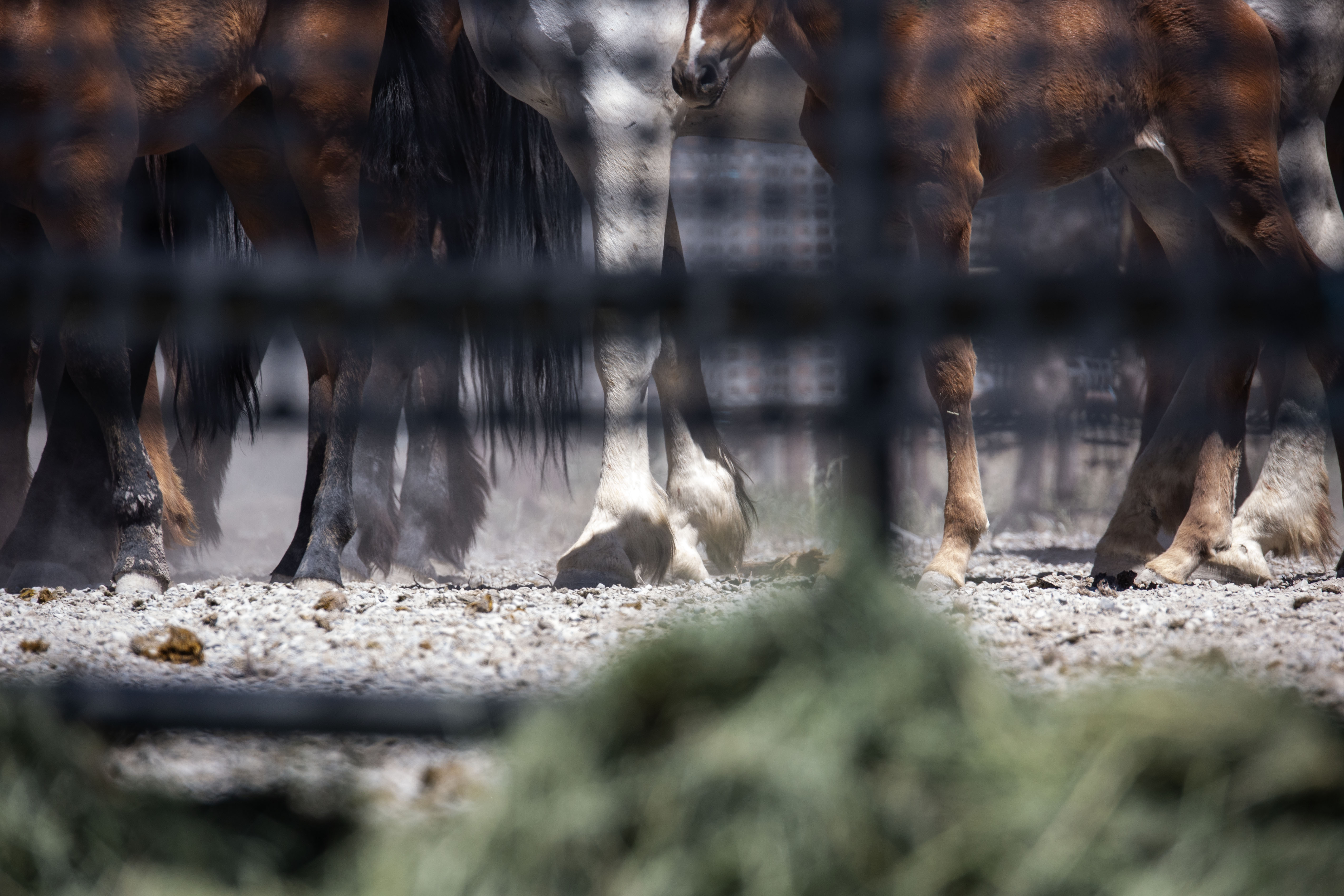
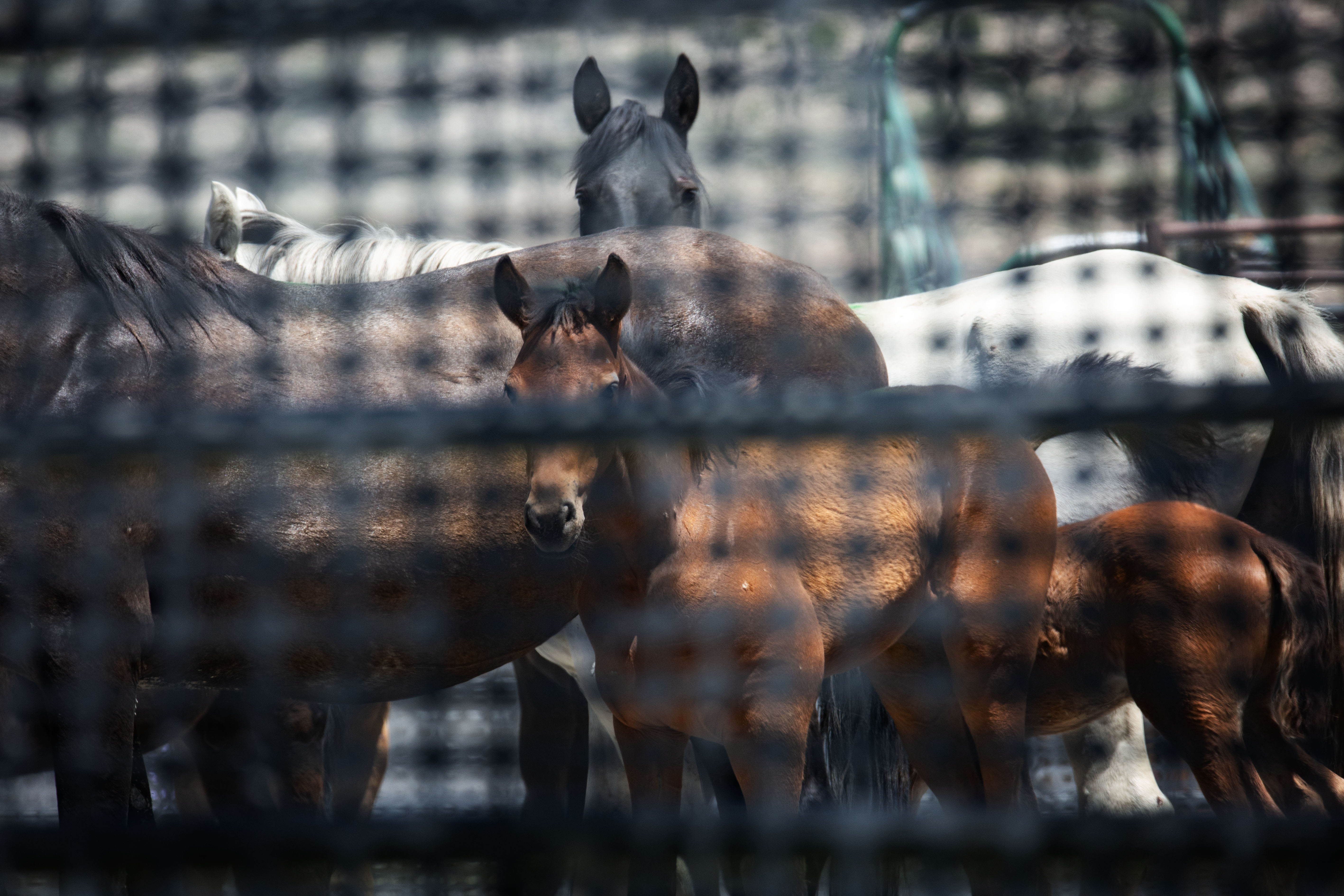
No injuries or deaths were reported during the operation.
Considering the anticipated heat wave with temperatures exceeding 100º, there are legitimate concerns about the welfare of the horses.
49 Mustangs Captured on Day 3 of Antelope-North Roundup
July 11, 2023: Today, a total of 49 horses were captured. The weather conditions were clear with temperatures ranging from the mid-70s to 91º. The meet time was at 4:45 in Wells, and the team drove east towards Wendover, dropping about 20 miles south on US 93 to reach the trap site.
During the first run at 7:05 am, approximately 8 horses were pushed into the trap by the helicopter without any issues. Shortly after, a smaller group of horses followed, and one foal got diverted and ended up on the left side of the wings. A roper went out to assist, but by the time they reached the foal, it had already entered the wings on its own. The foal was then pushed into the trap by the wrangler and no roping took place. The runs consisted of small bands of horses, resulting in a quiet trap site. The horses remained calm, and they were sorted and loaded onto the trailer quickly. The stallions were loaded first, followed by the mares and foals. There was a concern about the bumpy road potentially causing horses to lose their balance, but the trailers were driven slowly, and another vehicle followed each load to ensure safety.
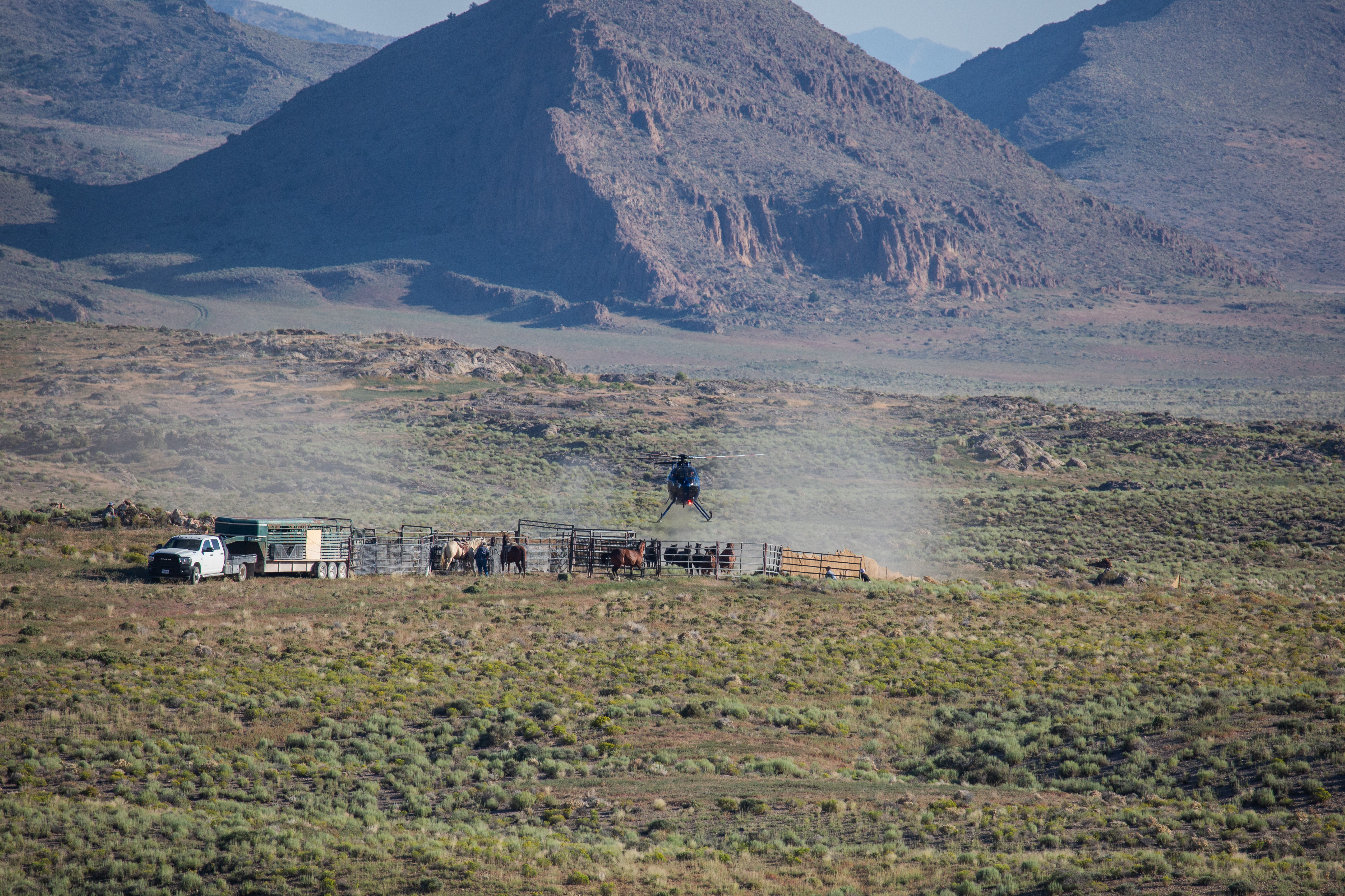

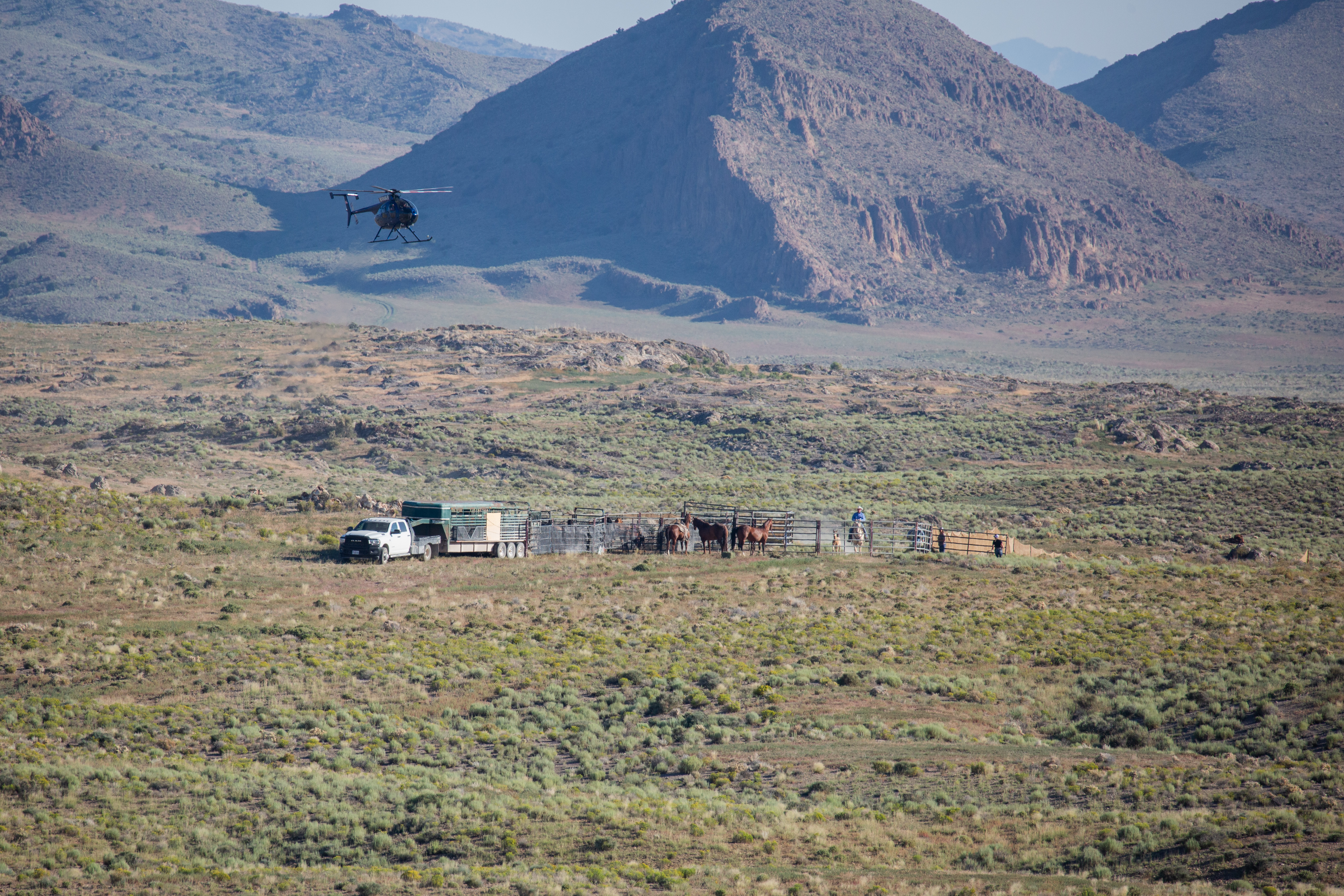
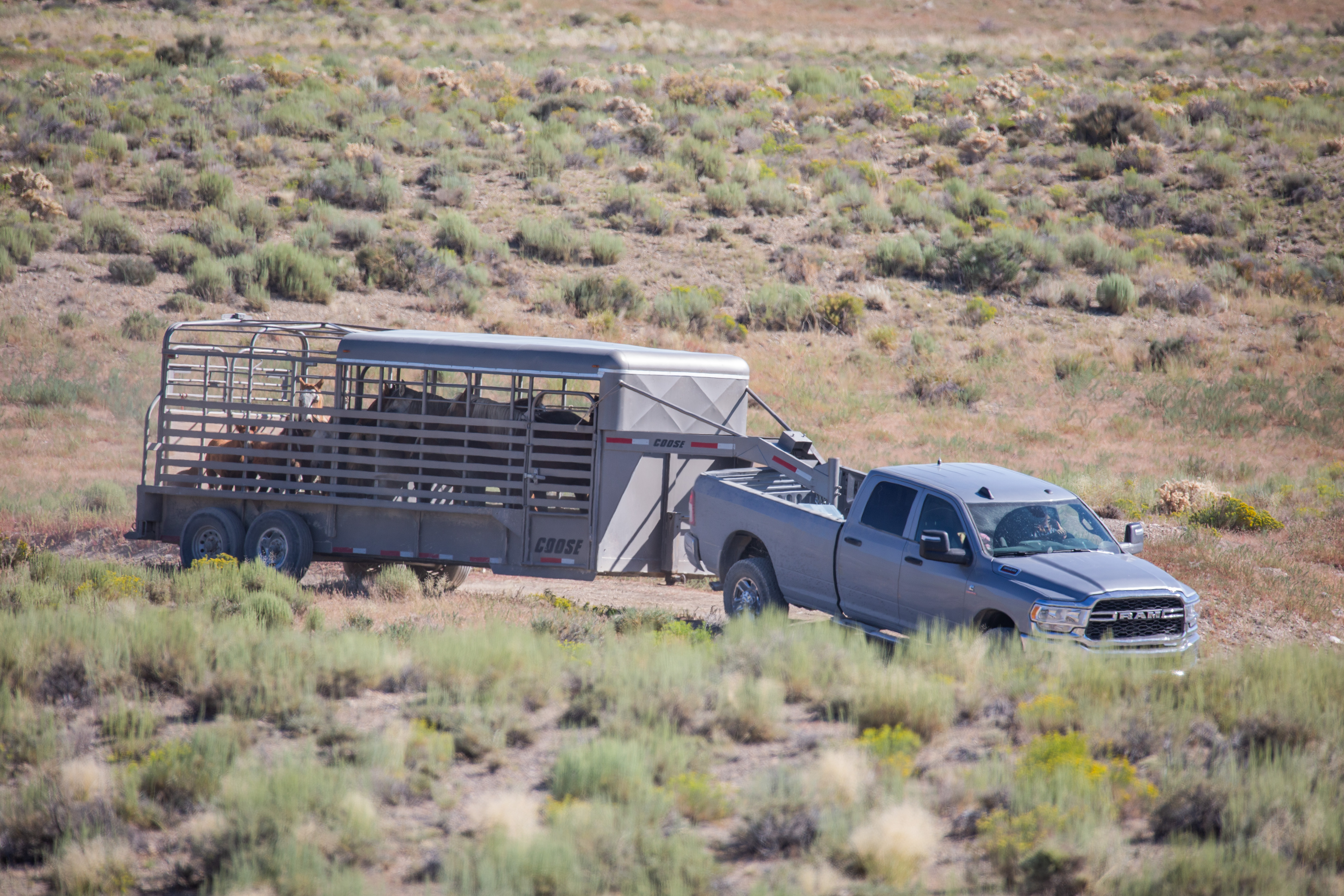


In the second run at 8:35 am, another small band of 7-8 horses came in without any issues and were quickly loaded onto the trailer. Two foals were noticed in the back of the trailer during this run. The third run occurred at 10:15 am, with approximately 7 horses pushed into the trap. The fourth run took place at 10:55 am, and although there seemed to be some difficulty maneuvering the horses, everything went smoothly once they reached the trap. The fourth trailer load went out at 11:25 am.
After the fourth run, it was announced that the trap would be moved for the following day, approximately 10 miles north of the current location. While scouting the area, two more small bands of horses were found and brought in, with the last band consisting of just 3 horses and a small foal. They were loaded onto the trailer as soon as they came in. In total, there were 5 trailer loads for the day.
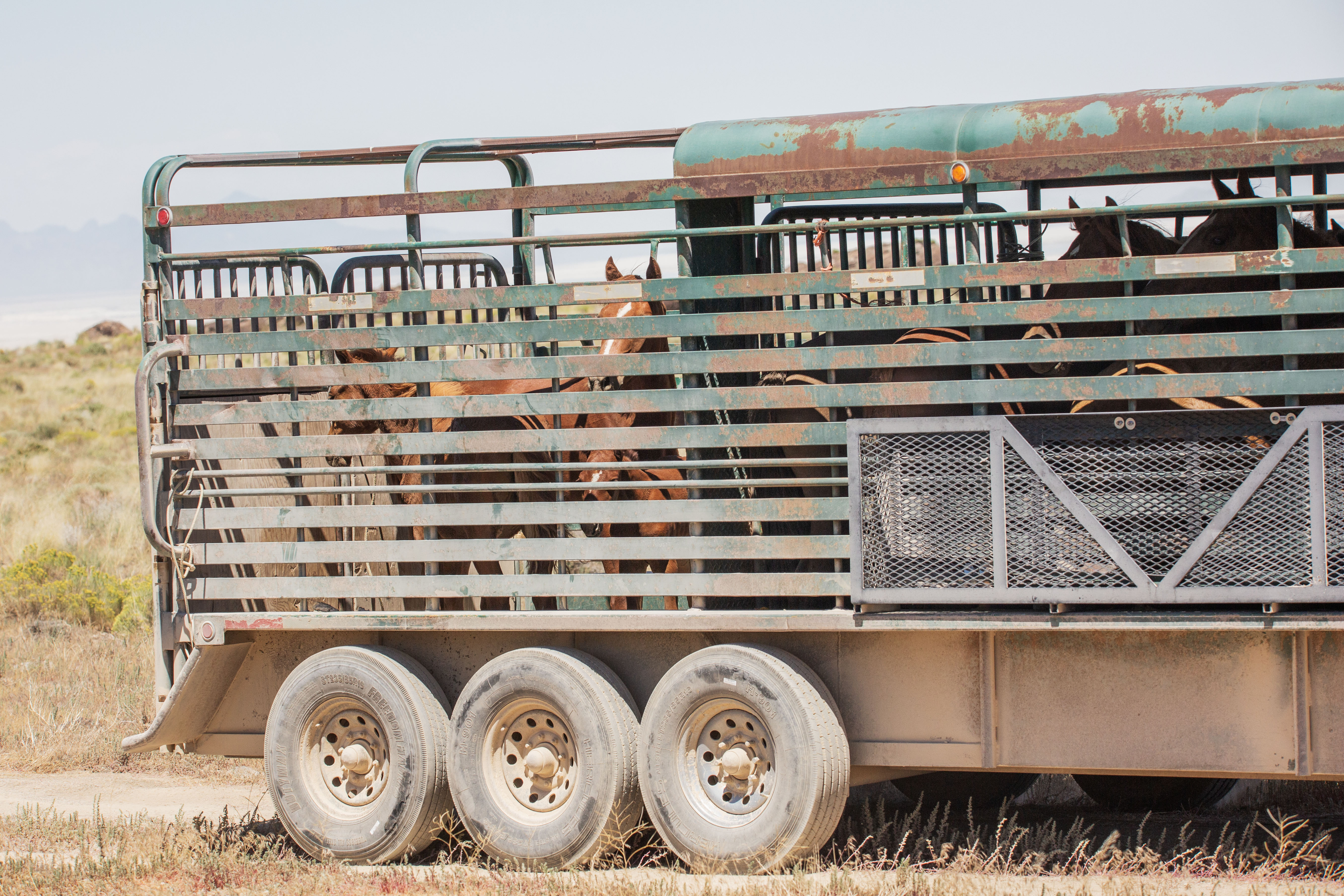
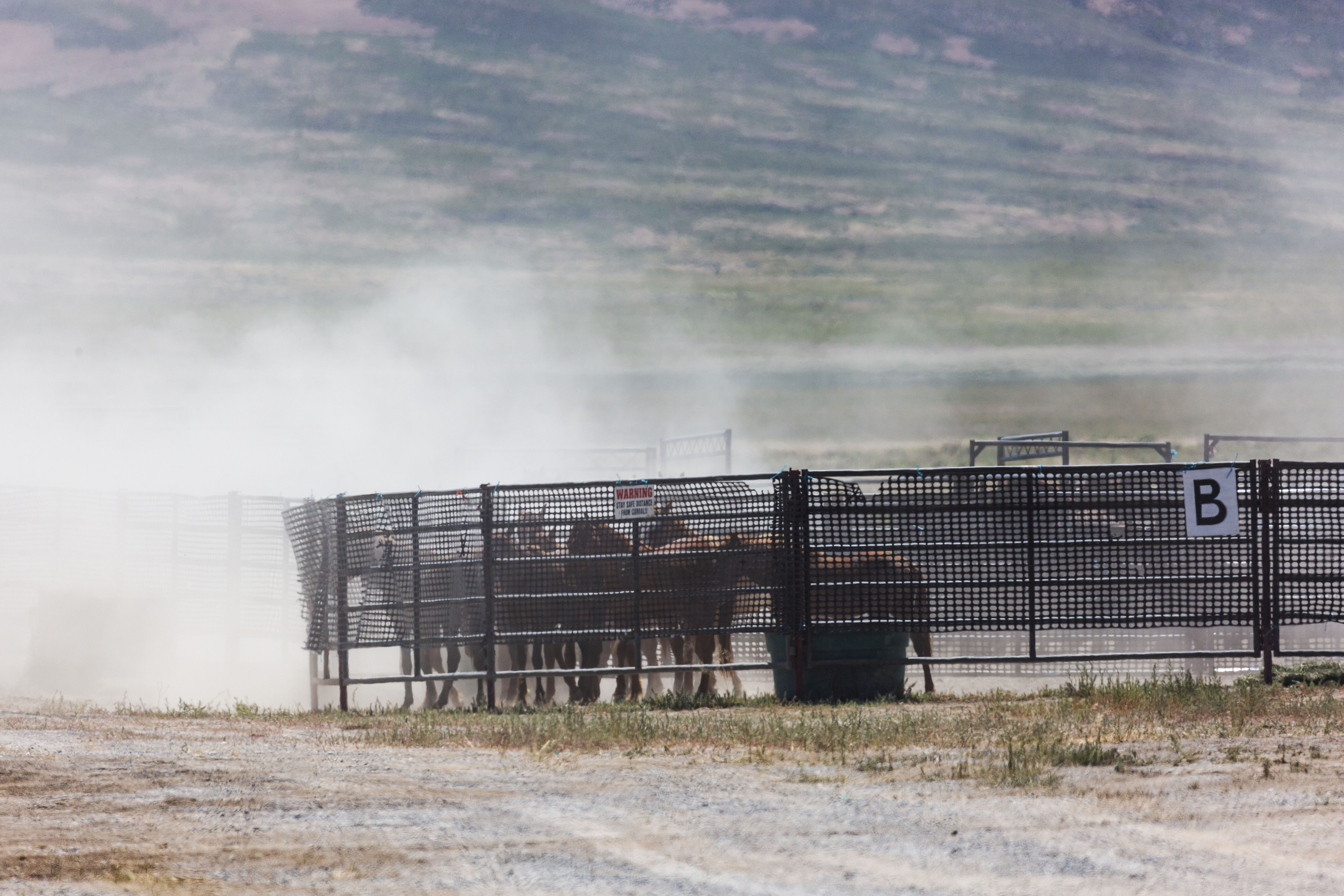
A tour was given at the temporary holding area once all the horses were sorted and settled with hay and water. The tour was quick, and there wasn't much time provided for observation. However, there were no visible injuries, and all the horses appeared to be in good condition.
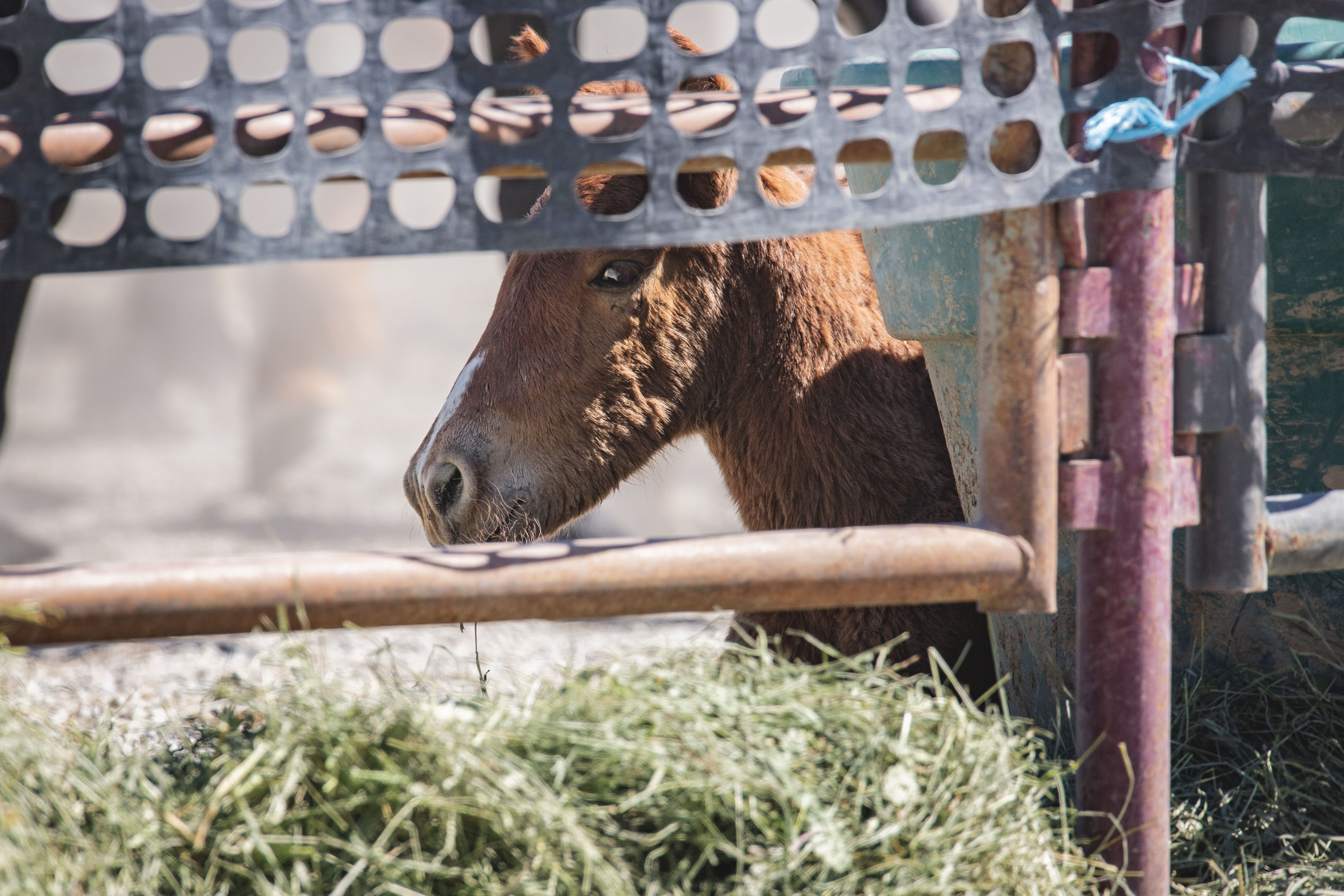

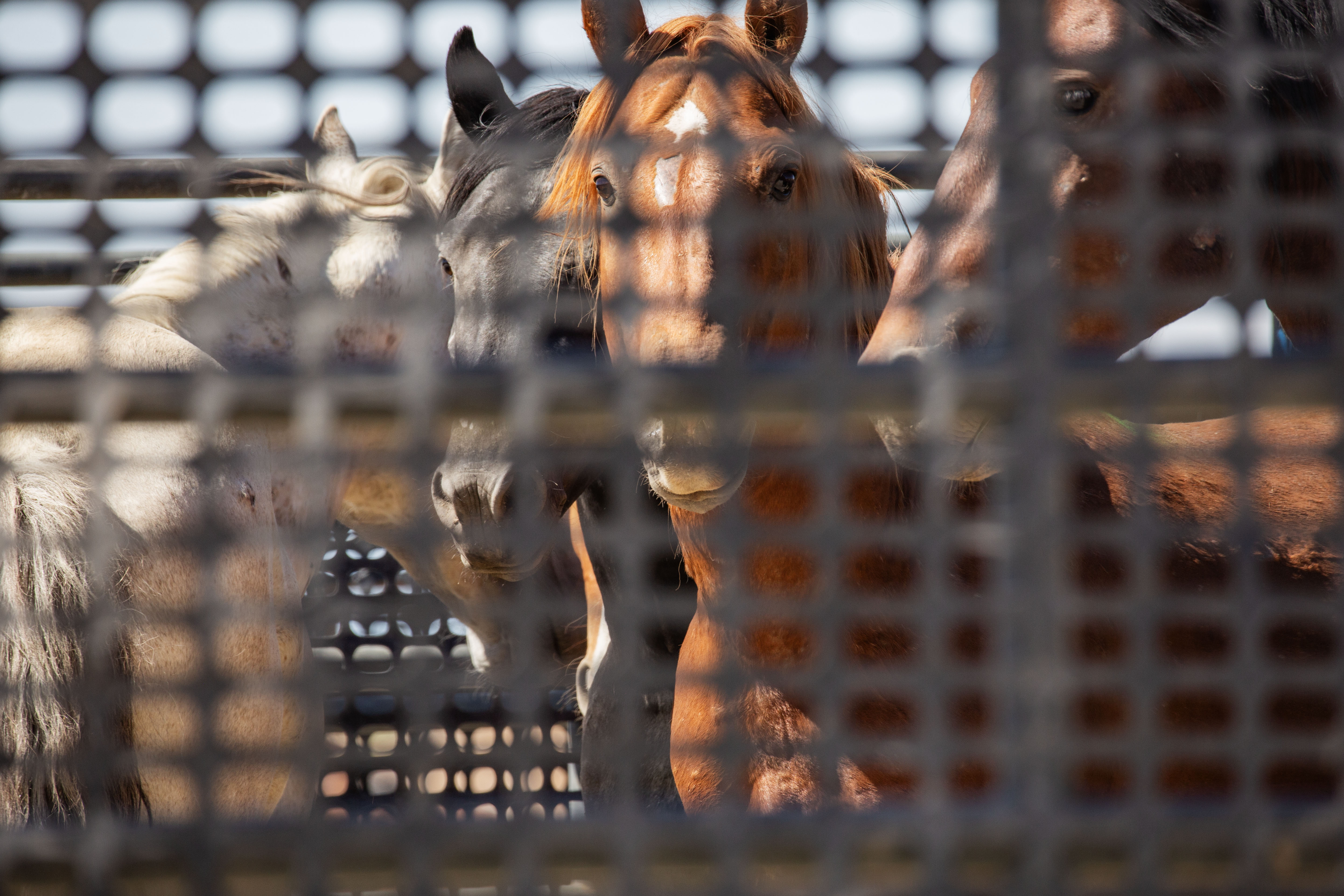
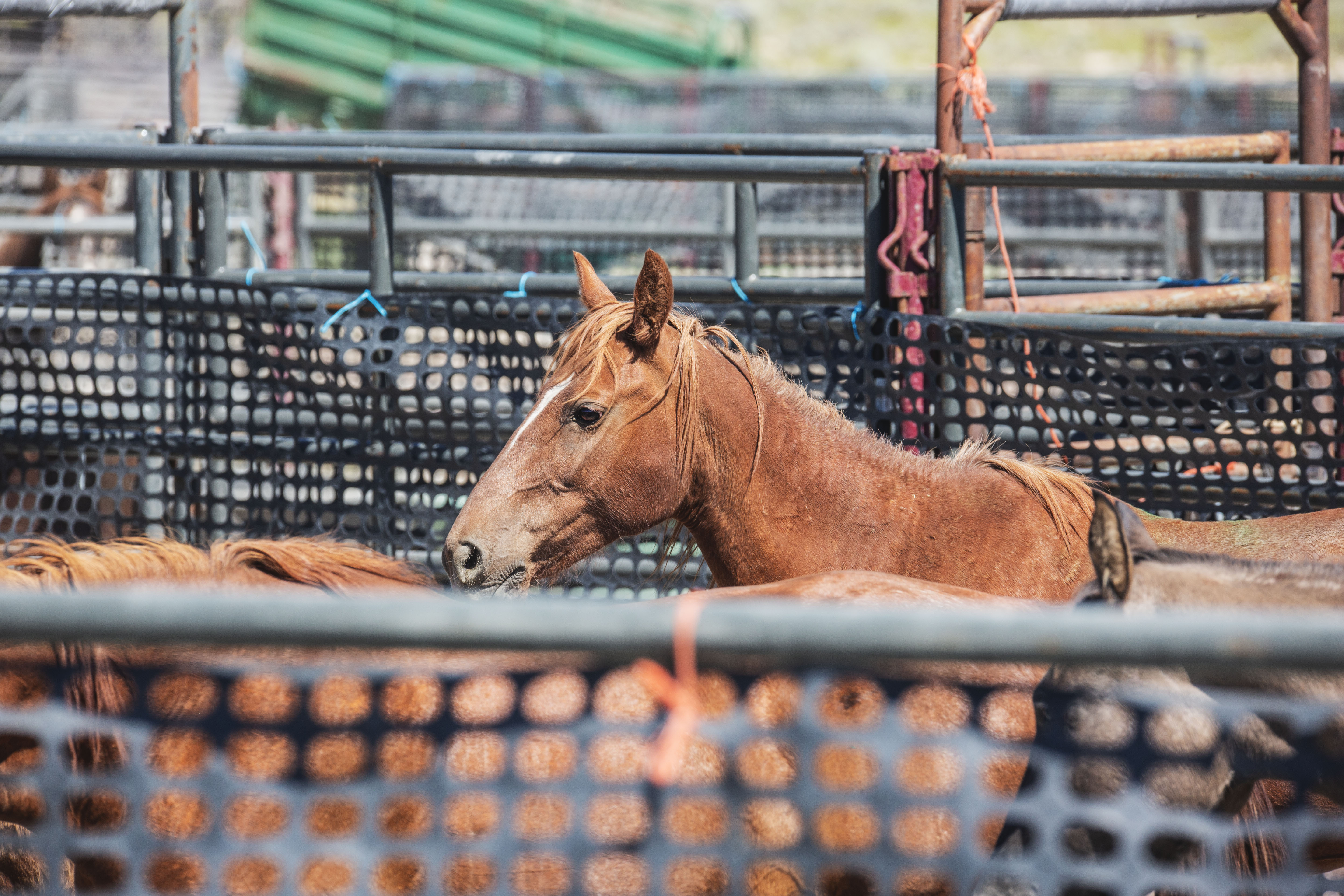
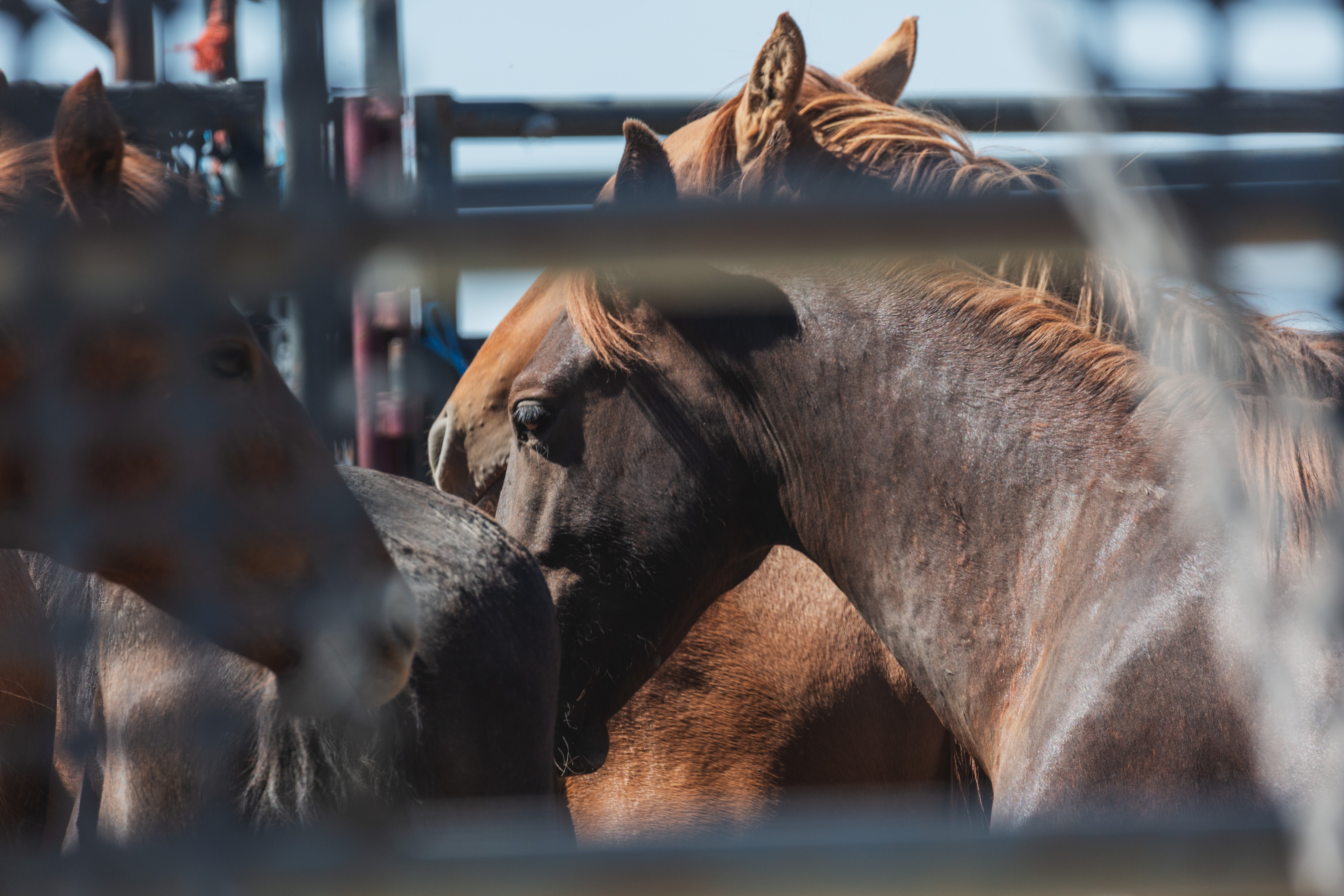
The Antelope Complex-north horses will be shipped to the Indian Lakes short-term holding facility.
July 10, 2023: No roundup operation occurred today due to high winds.
22 Wild Horses Captured on Day 1 of Antelope Complex-North, (6 Stallions, 10 Mares, and 6 Foals)
July 9, 2023: We had a slightly delayed start to our day, arriving at our designated location near Wendover around 9:30 am. The trap site was situated approximately 20 miles south of Wendover, adjacent to US Route 93. The weather was pleasant, with sunny skies, a gentle breeze, and temperatures ranging from the 80s to 90ºF. As we approached the trap site, a hill partially obscured our view, revealing only the trap itself.
During the first run at 10:00 am, the horses appeared suddenly, making it challenging to observe them clearly at this site because of the obstruction and the distance, which was around 1 mile away. I estimated the initial group to consist of around 7 horses. Interestingly, a second group of 3 horses seemed to have separated from the larger group. As they neared the trap site, the horses managed to escape through the wings. The helicopter had to circle back around to push two of the three horses back into the trap. After another pass, the final horse was successfully funneled into the trap. Additionally, a wrangled ventured out near the trap site and brought in what appeared to be a very young foal, which I later spotted resting at the temporary holding area.
From my vantage point, the horses seemed to be in good condition and displayed a calm demeanor at the trap site, with ample space available to them. The second run occurred at 12:30 pm and involved a group of 8 horses. During this run, one foal took matters into its own hooves and managed to escape through the wings. A roper promptly intervened and guided the foal back to the trap site.
In terms of temporary holding, both the Antelope Complex-south and north were being accommodated at the same location, albeit in separate pens labeled A and B. I did not observe any visible injuries among the horses, and they appeared to be well-provided for with an adequate supply of hay and water. However, I did notice a couple of foals that seemed quite exhausted, opting to rest rather than join the movement of the mares and other foals as we passed by.

